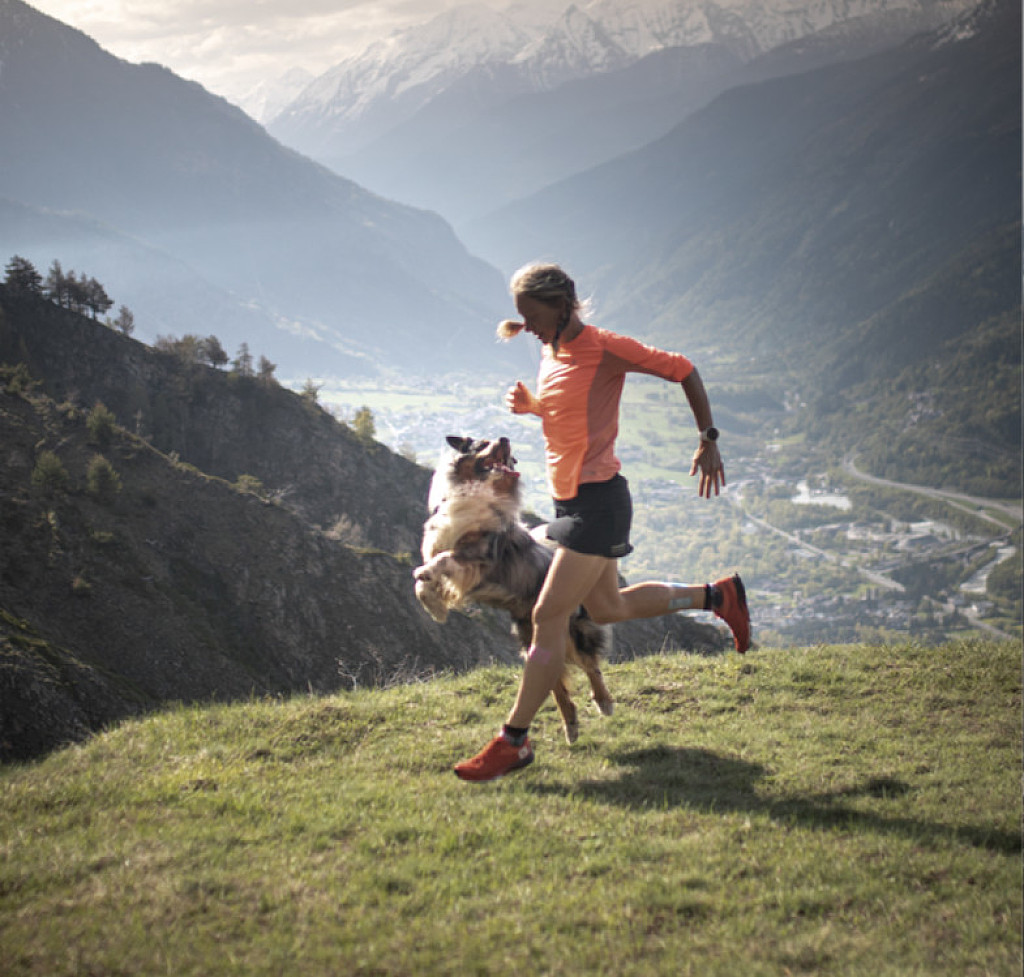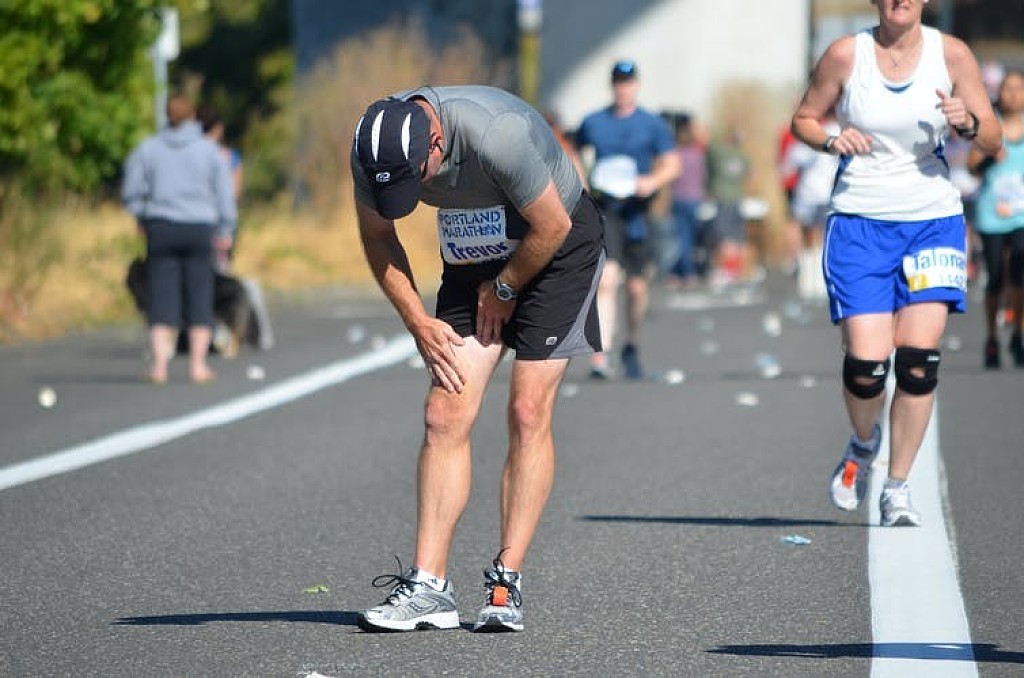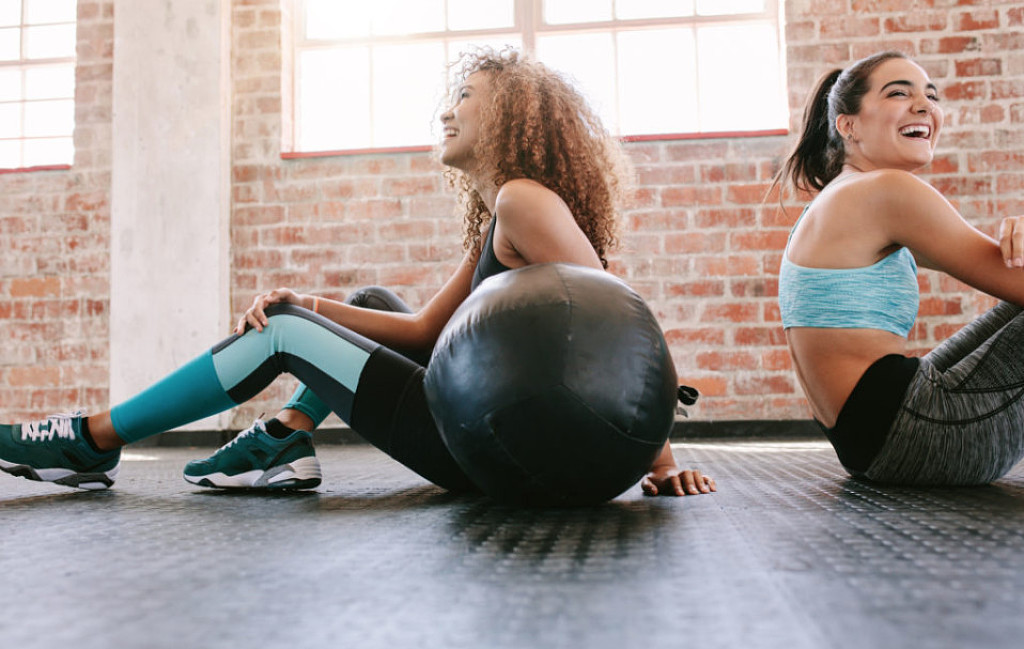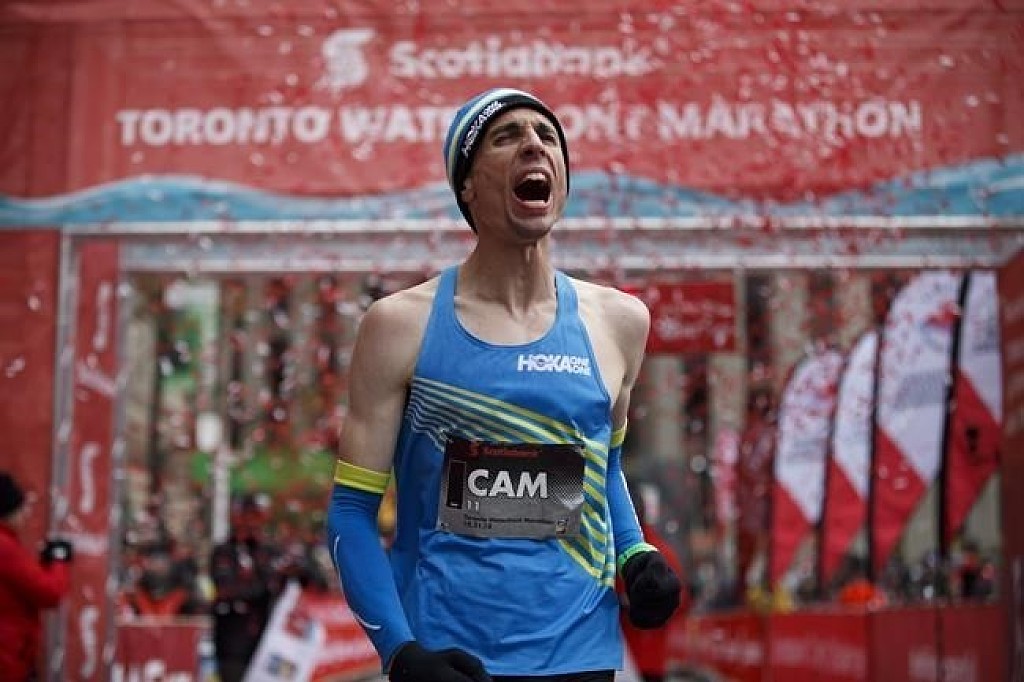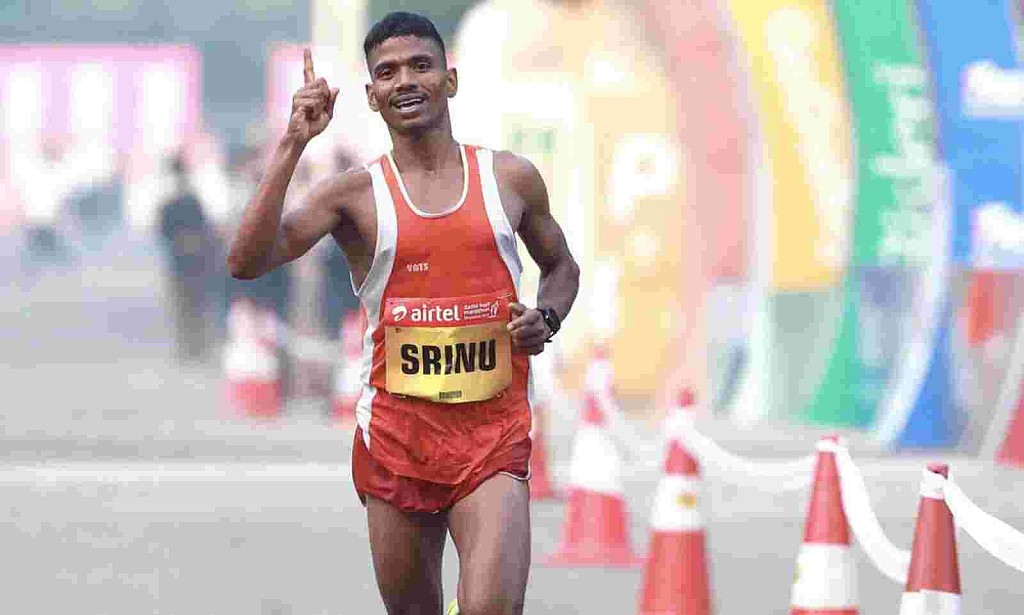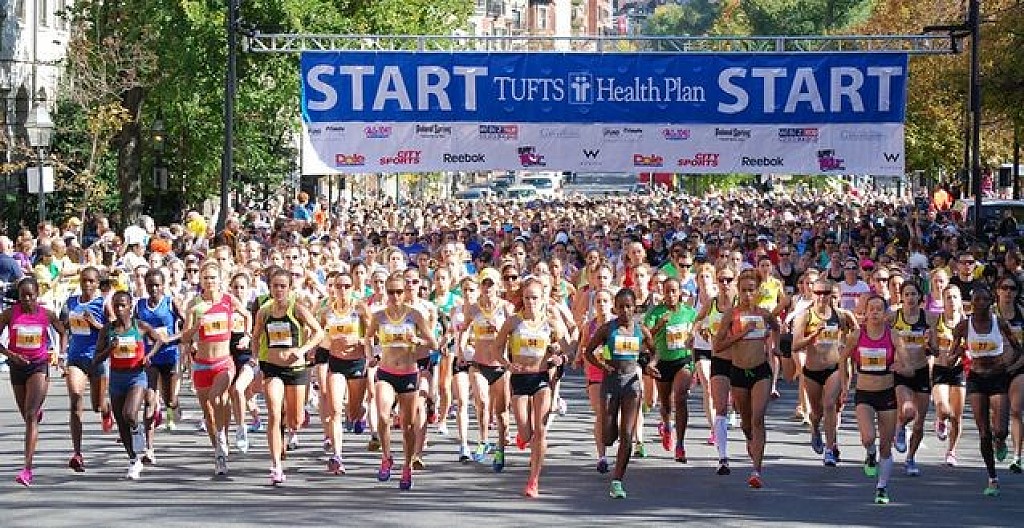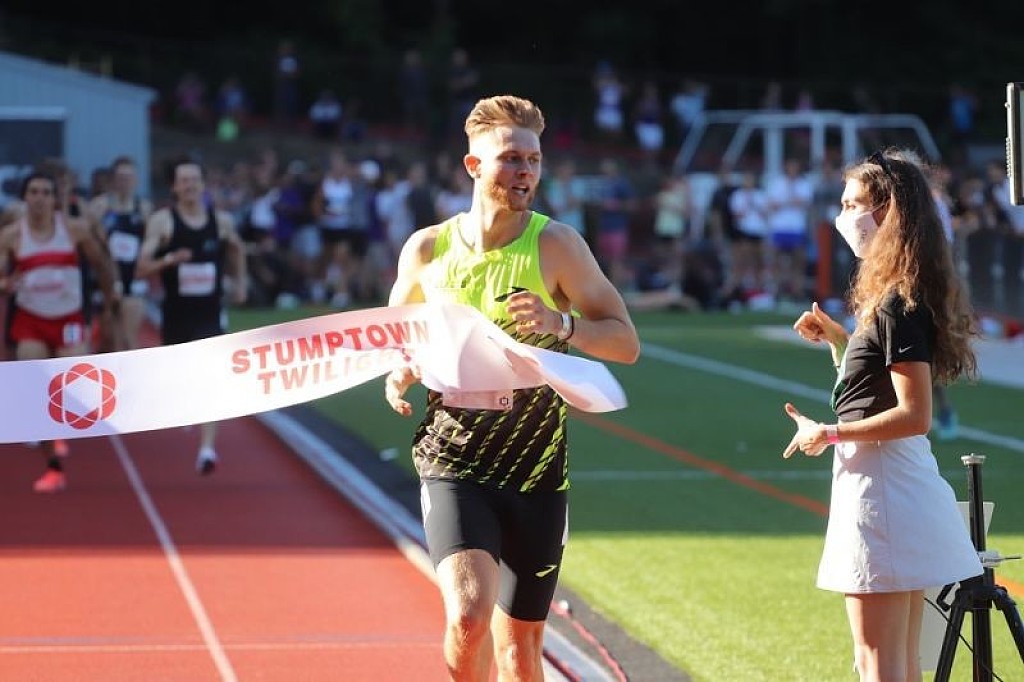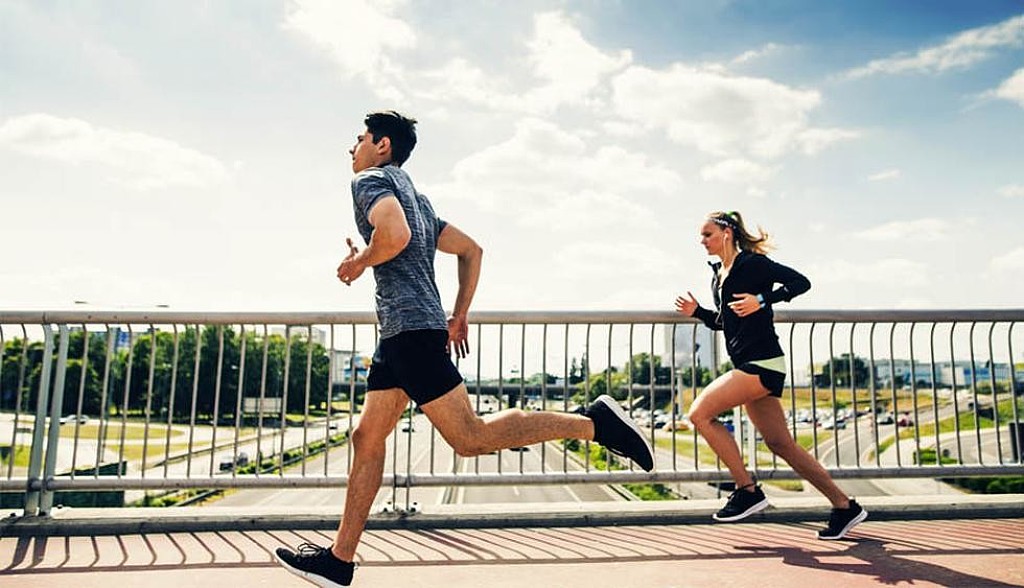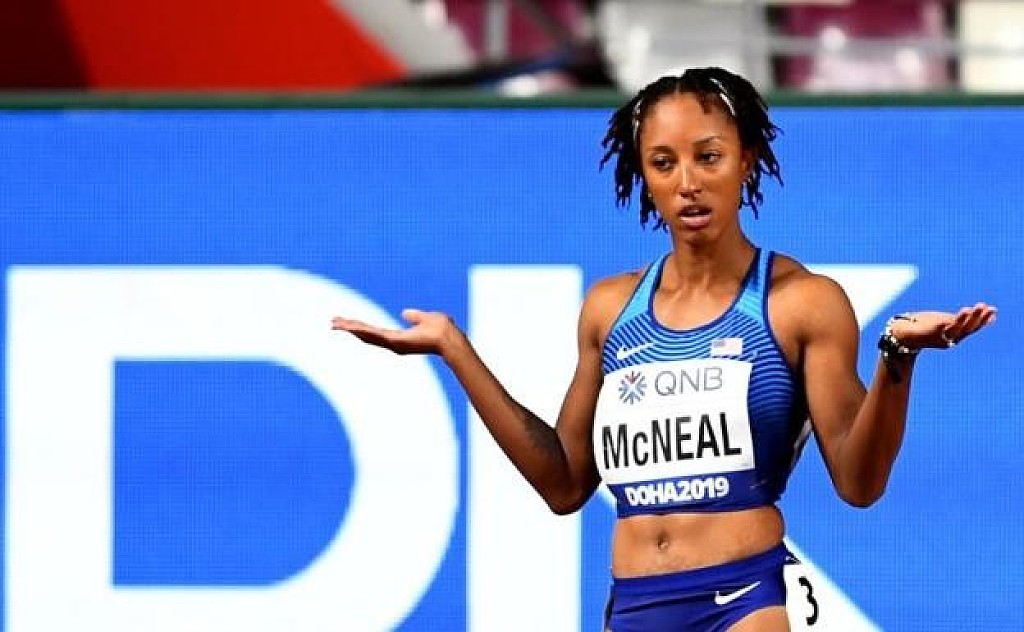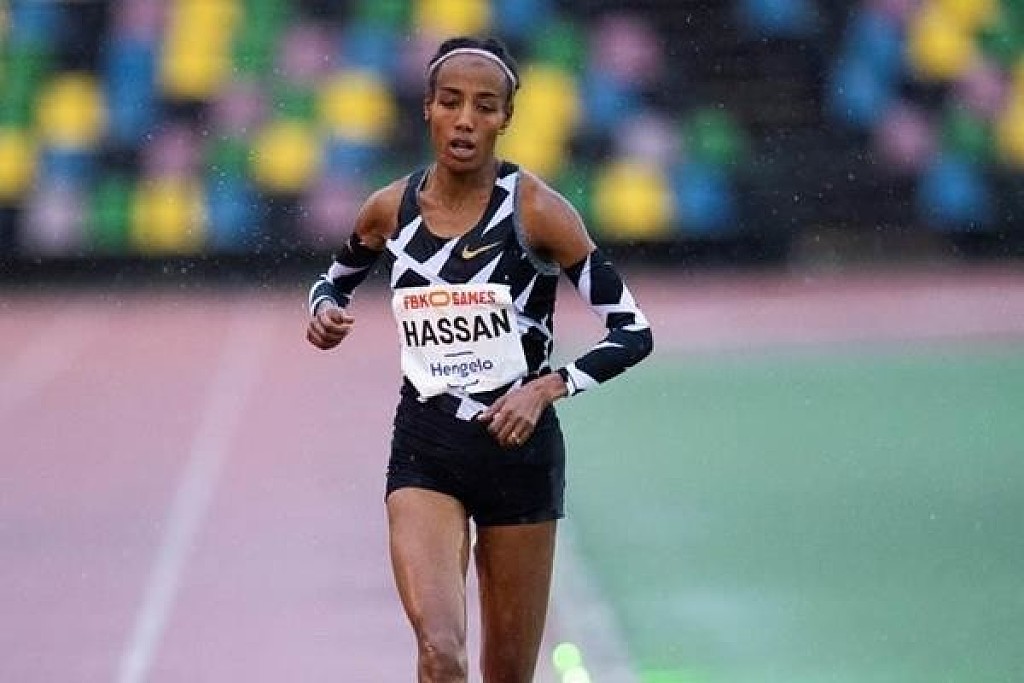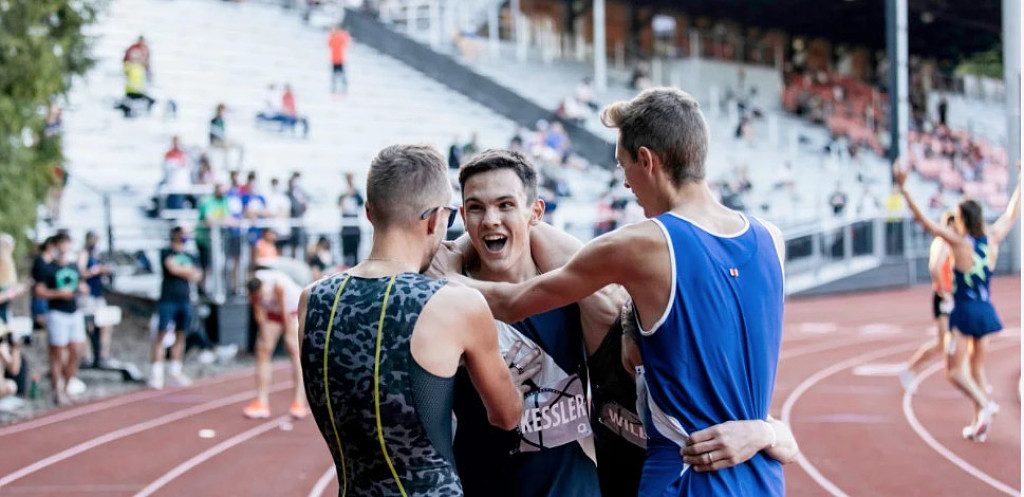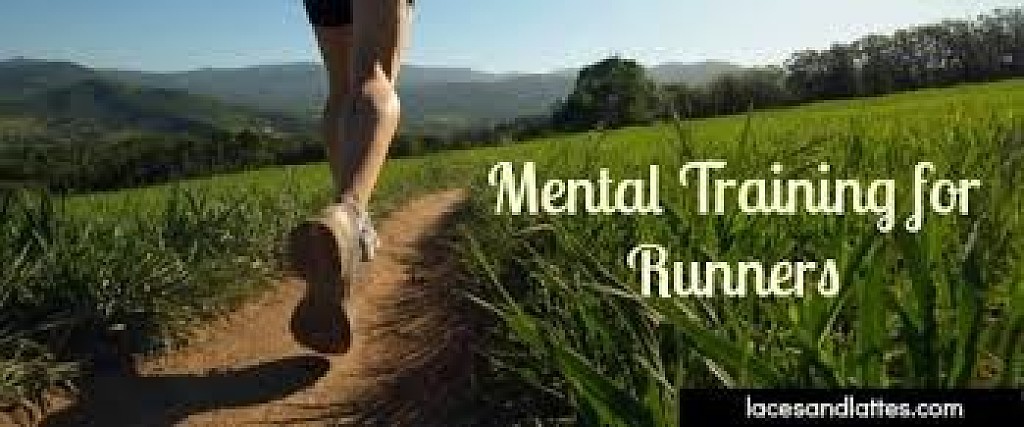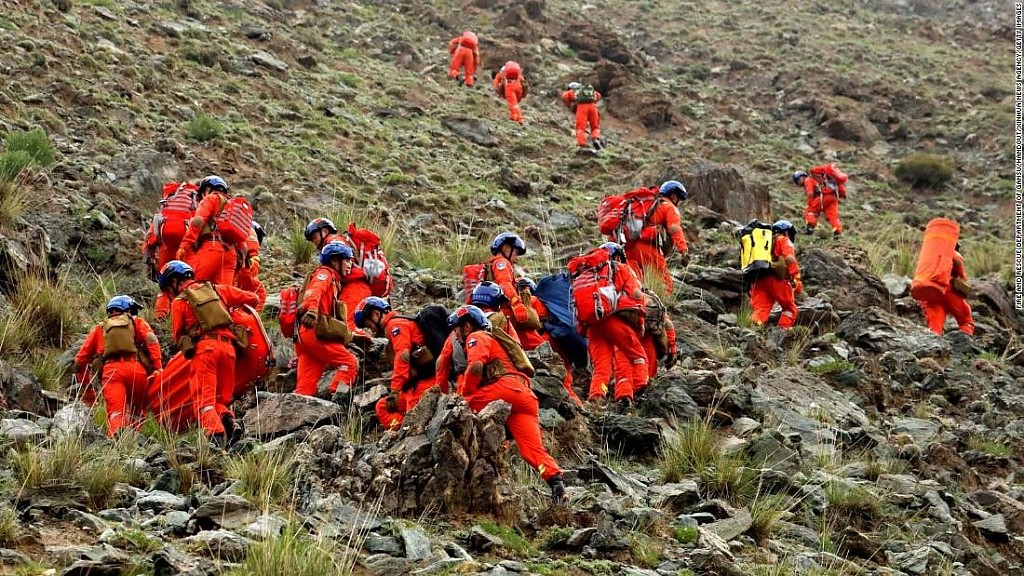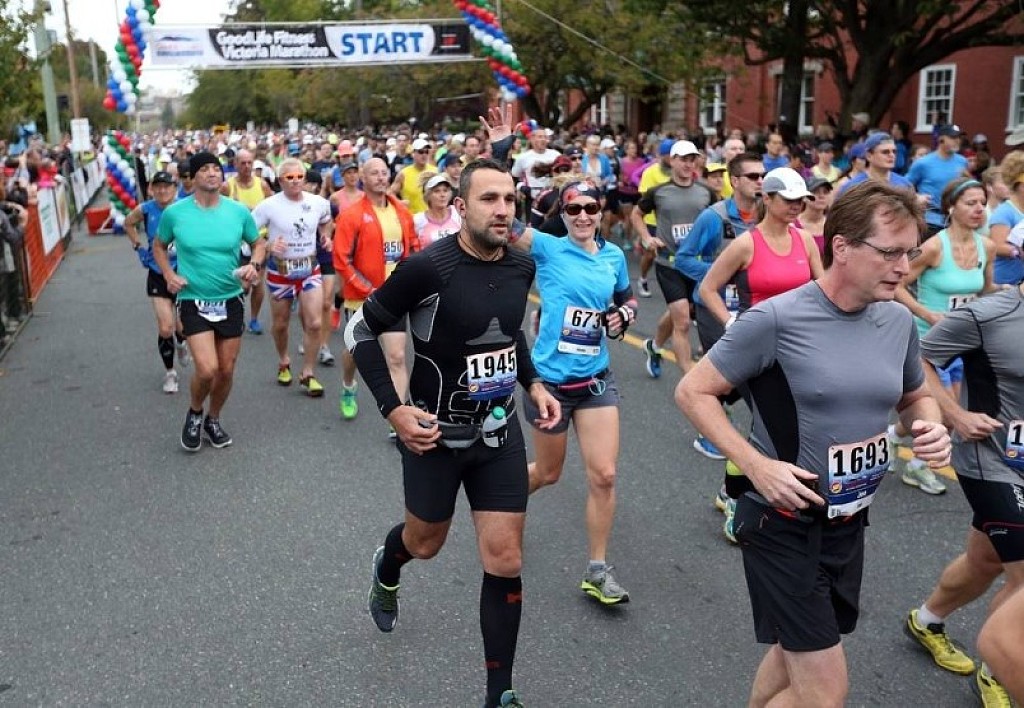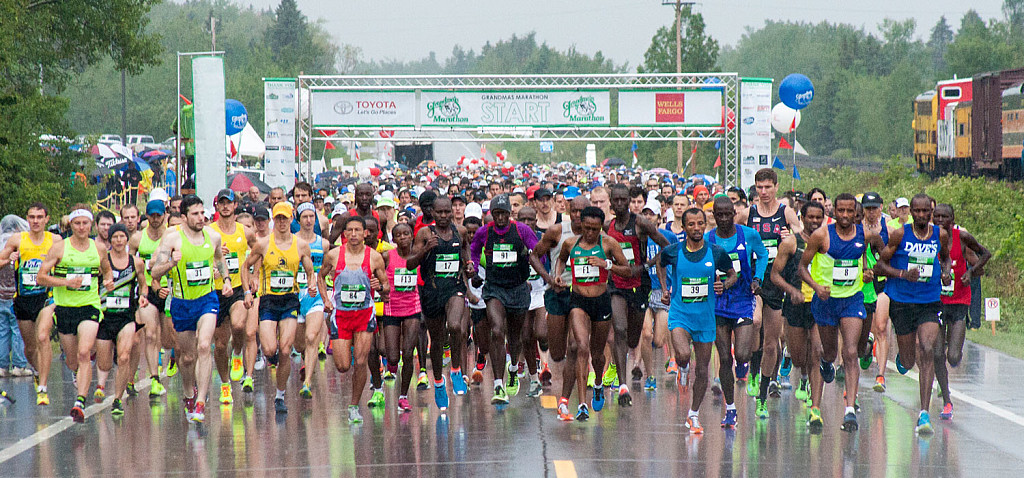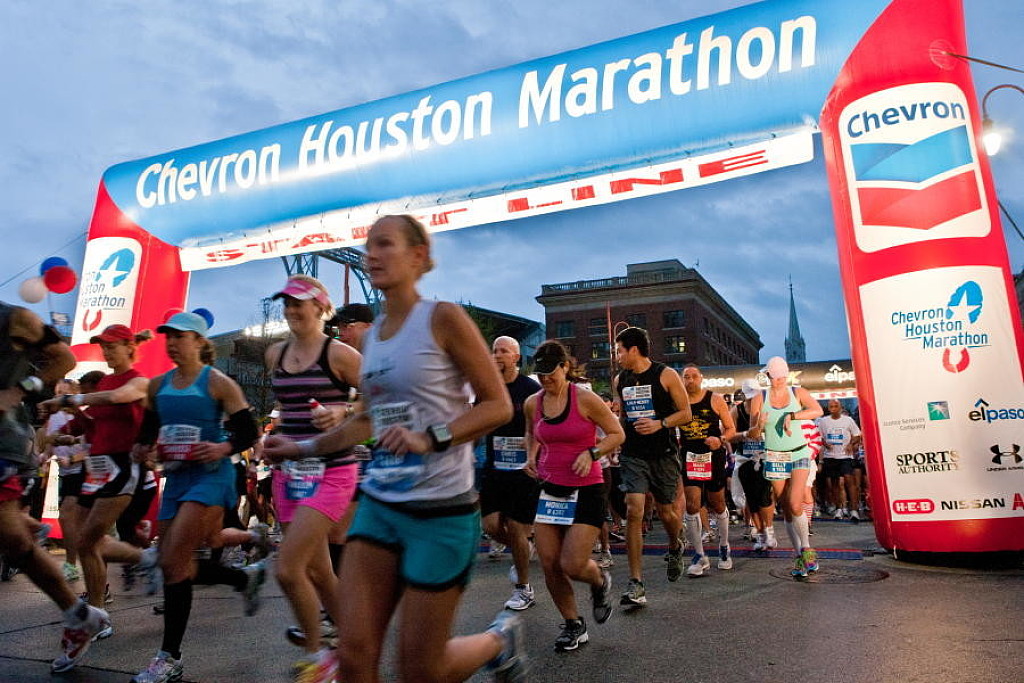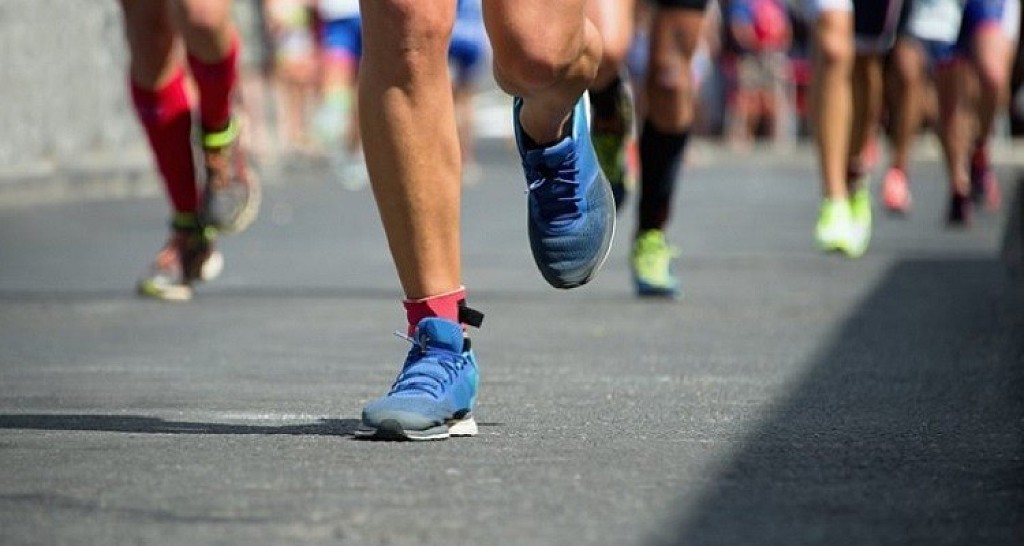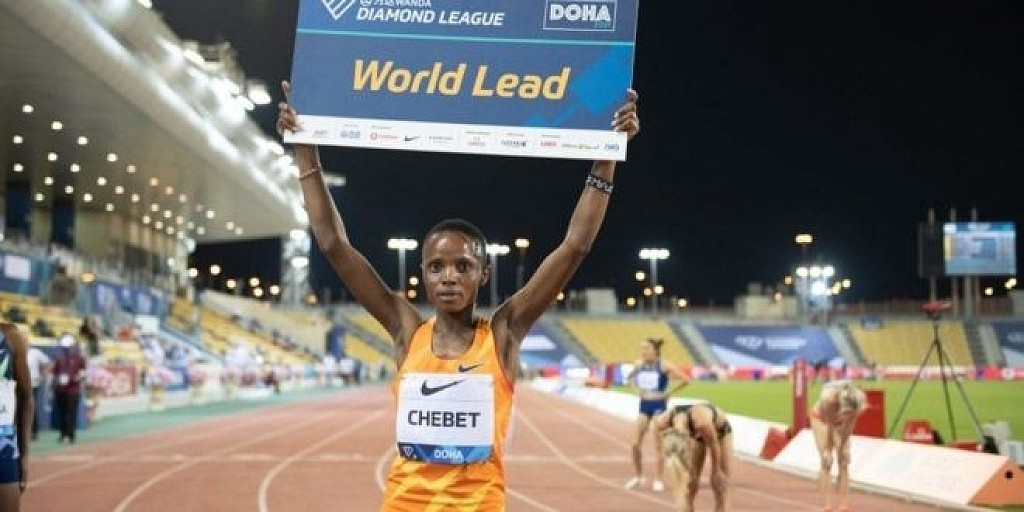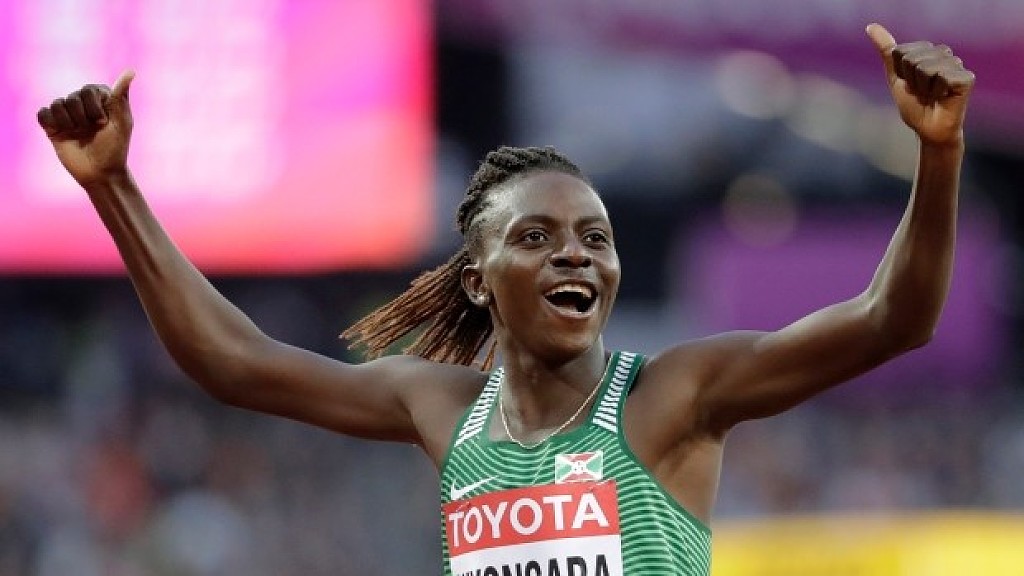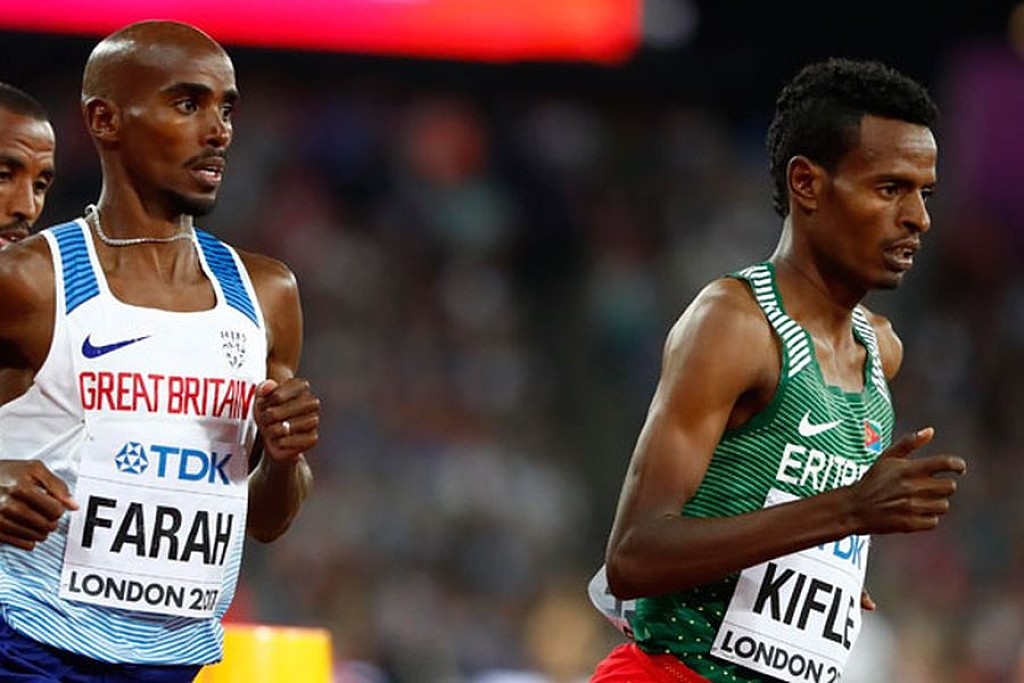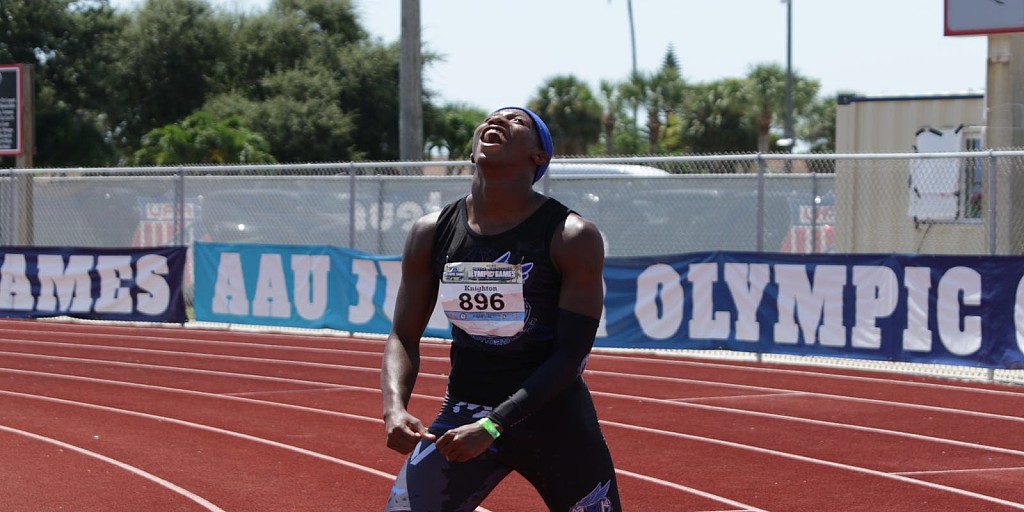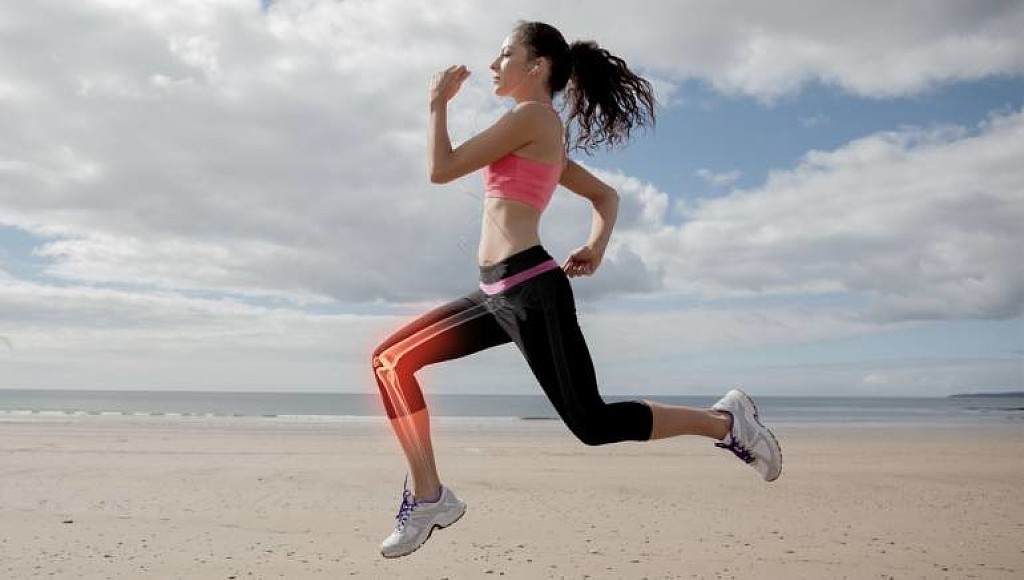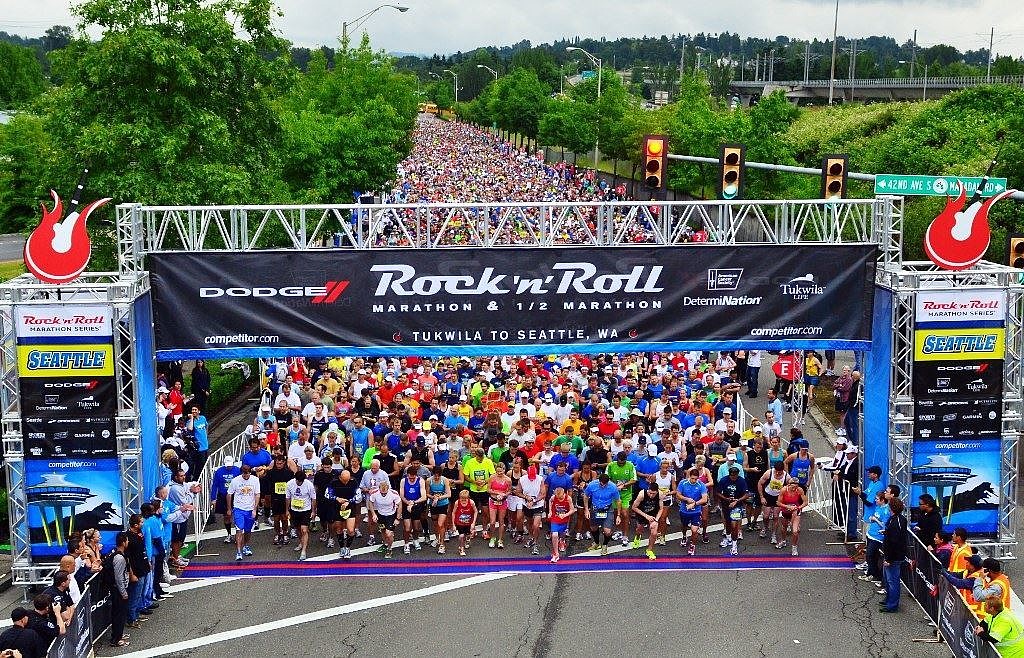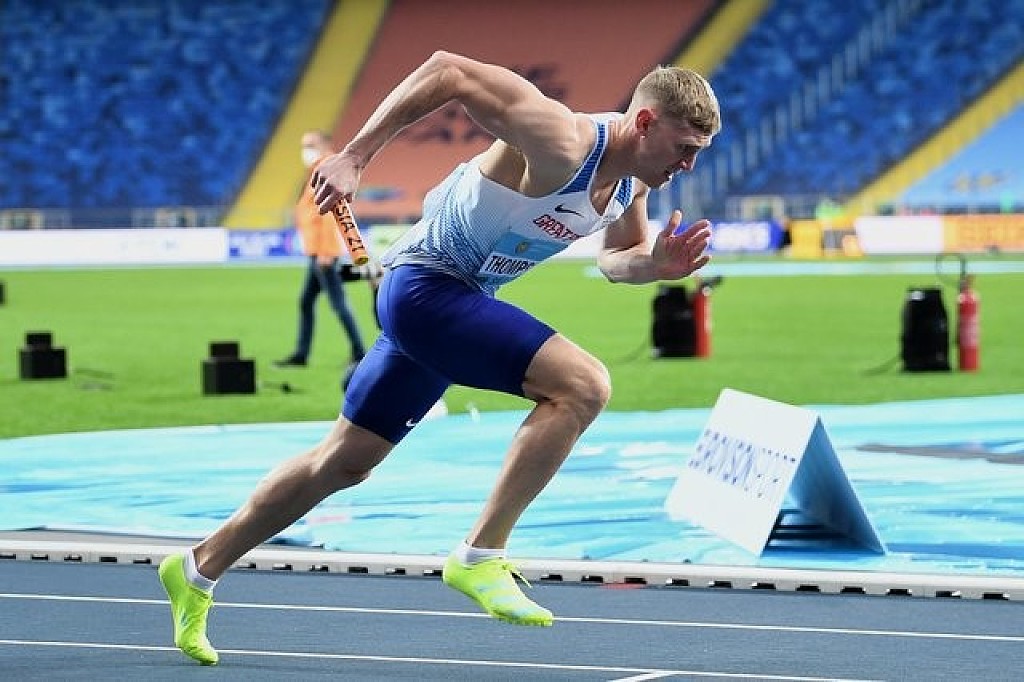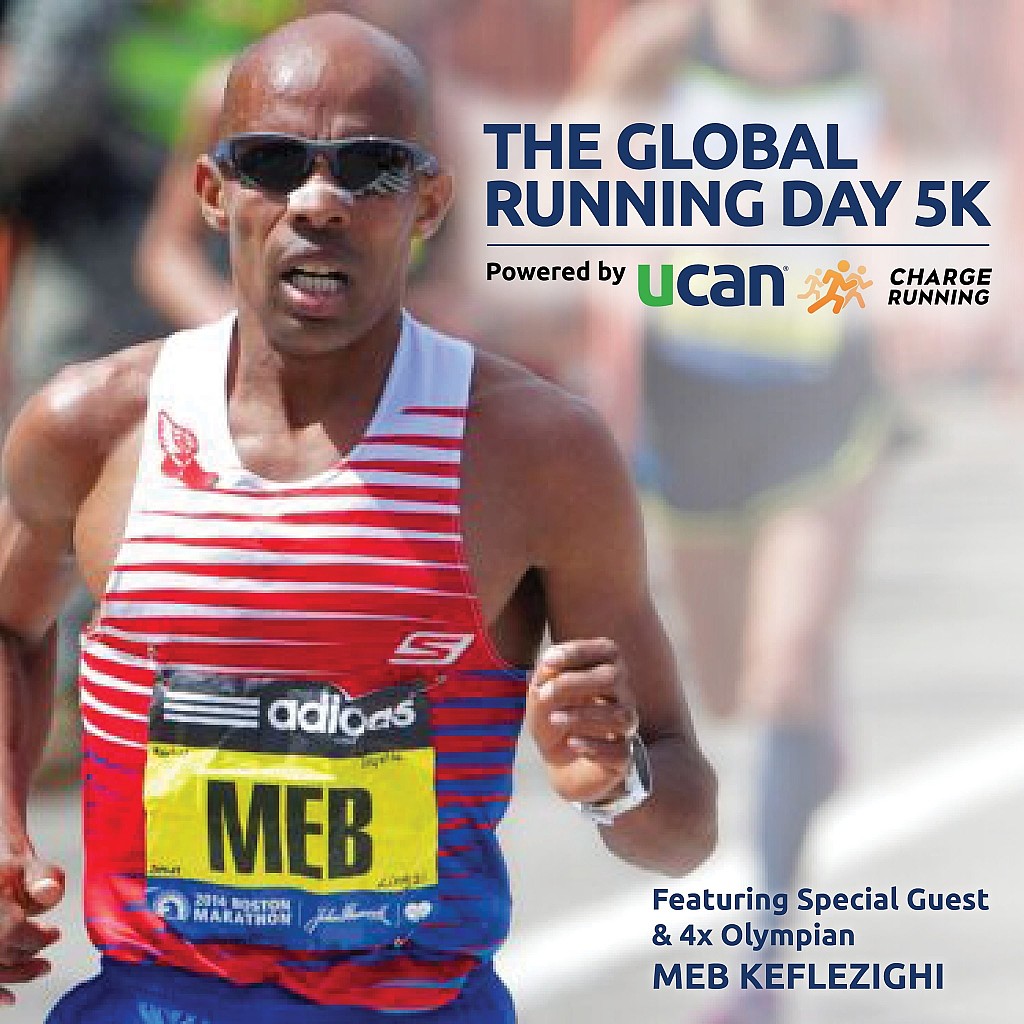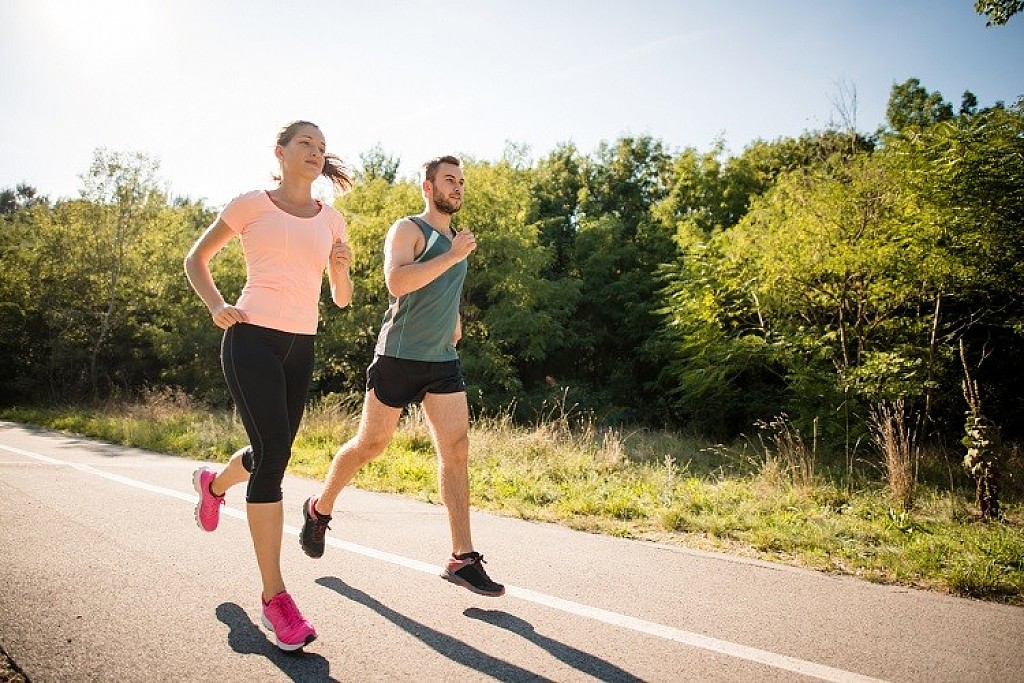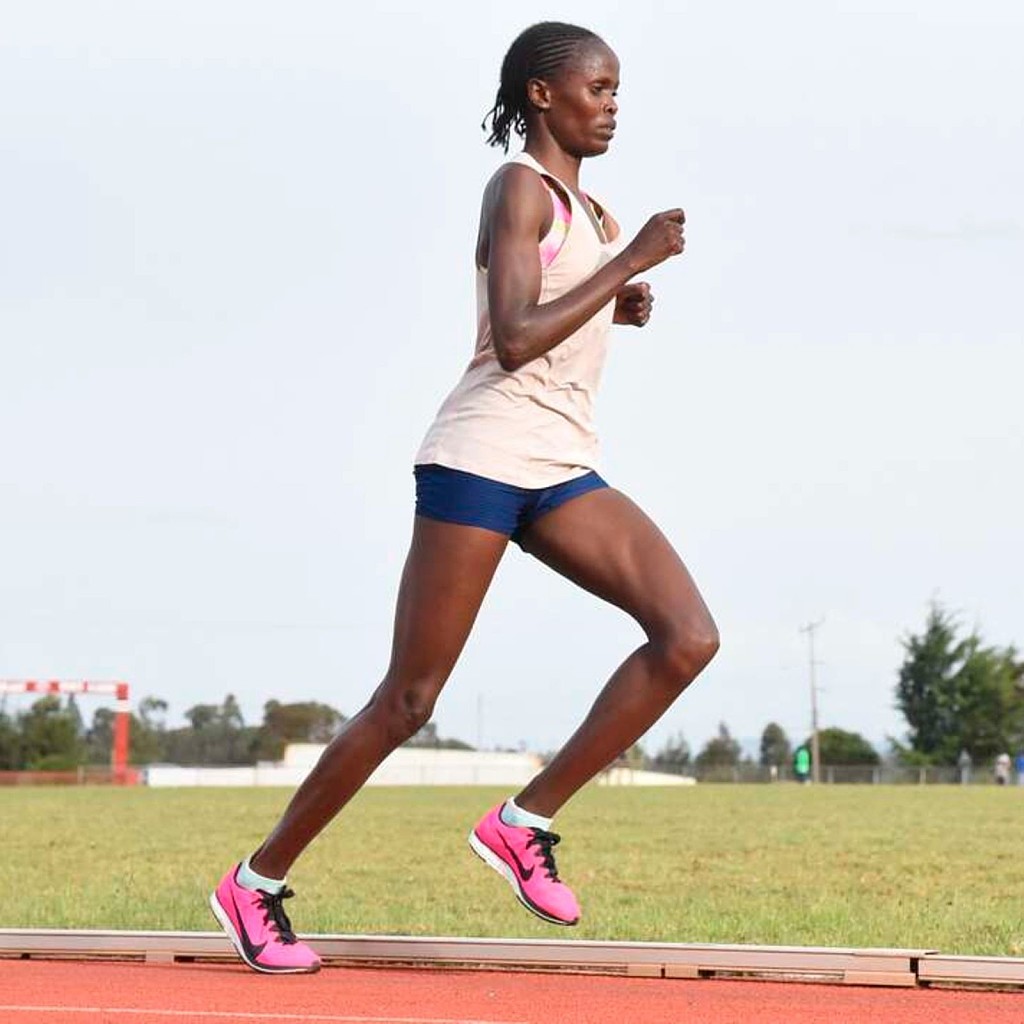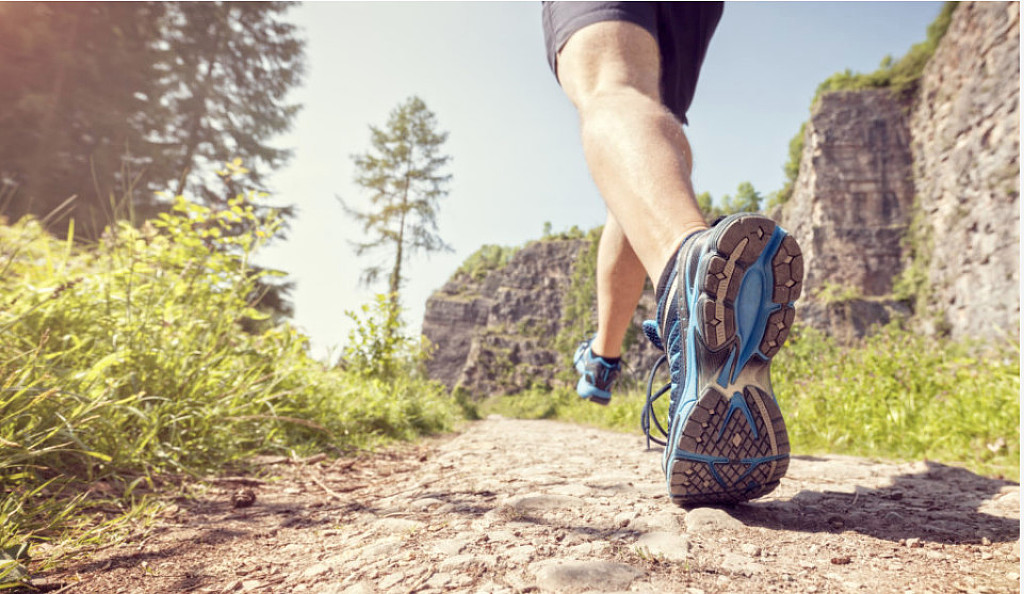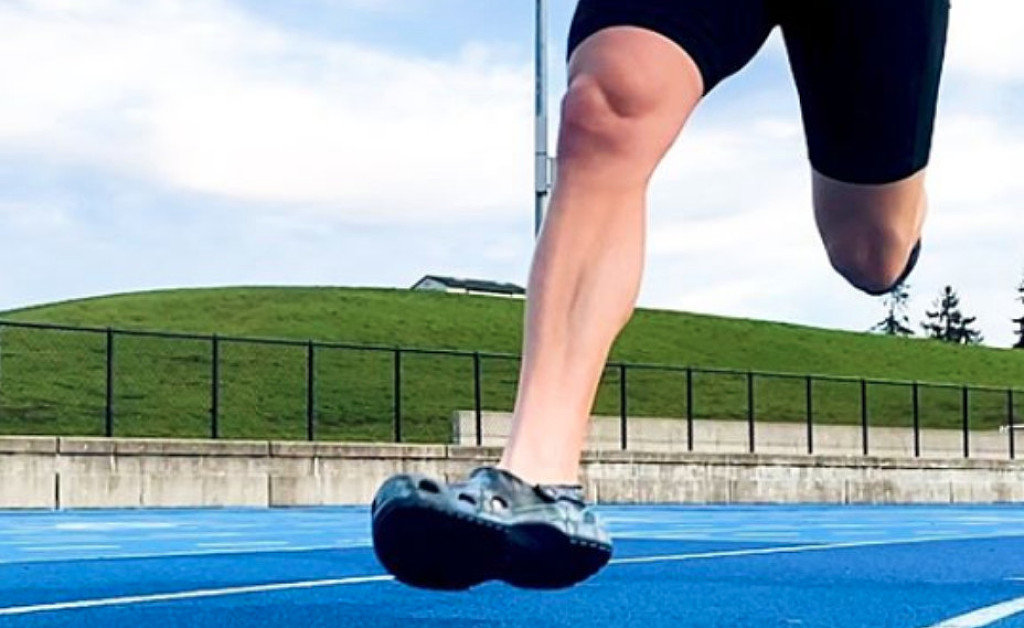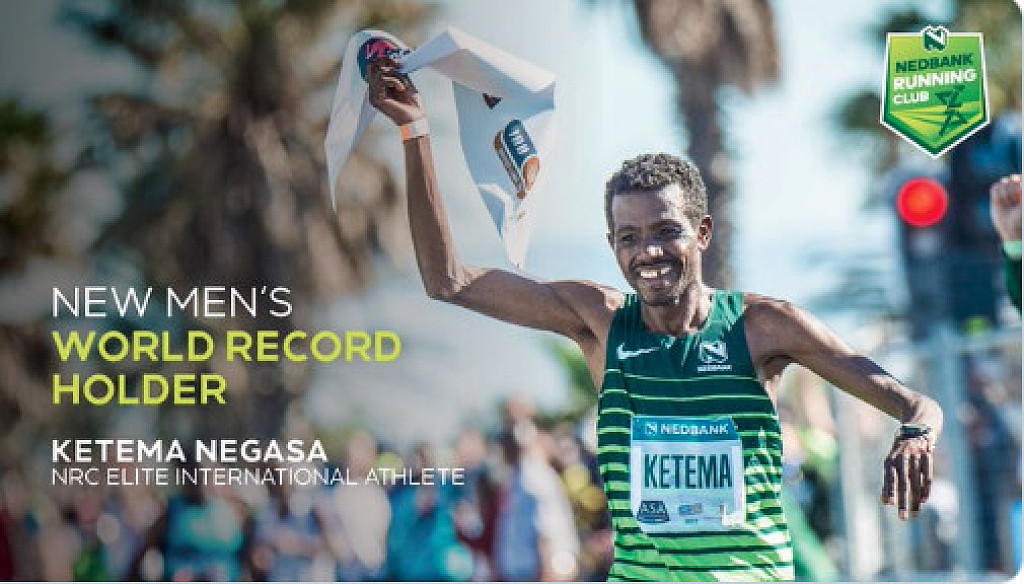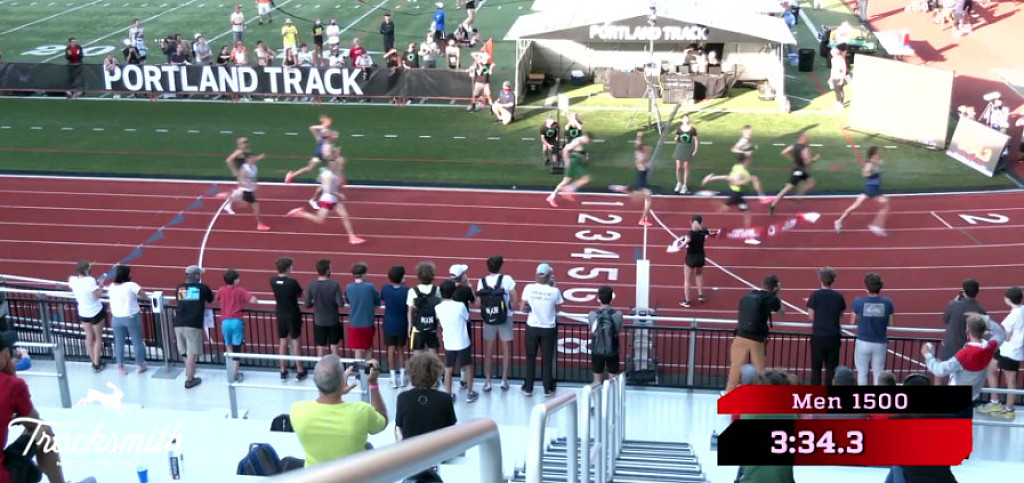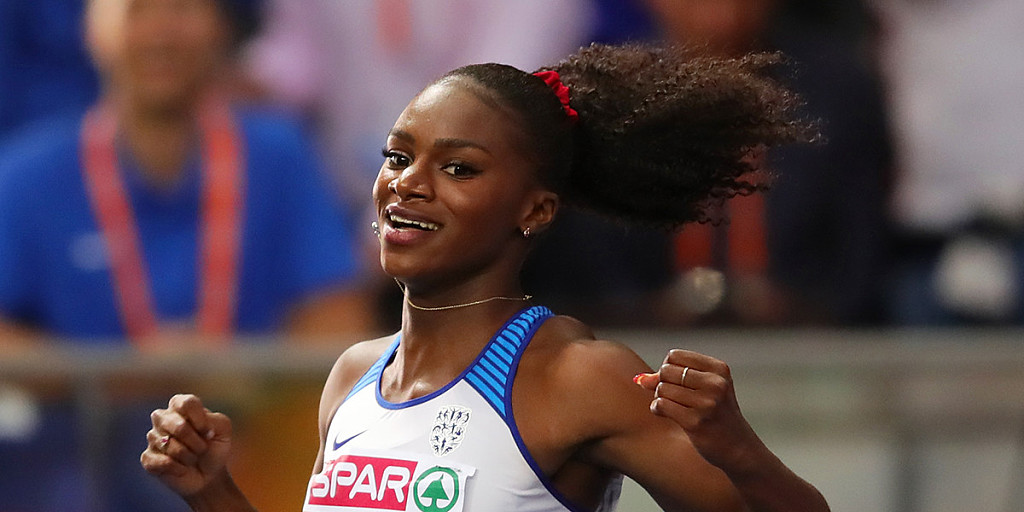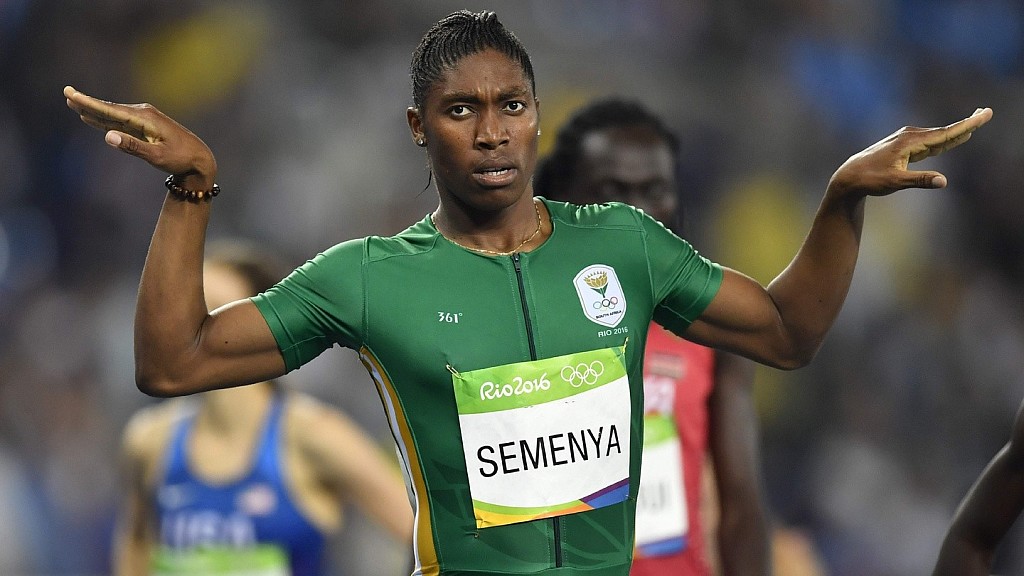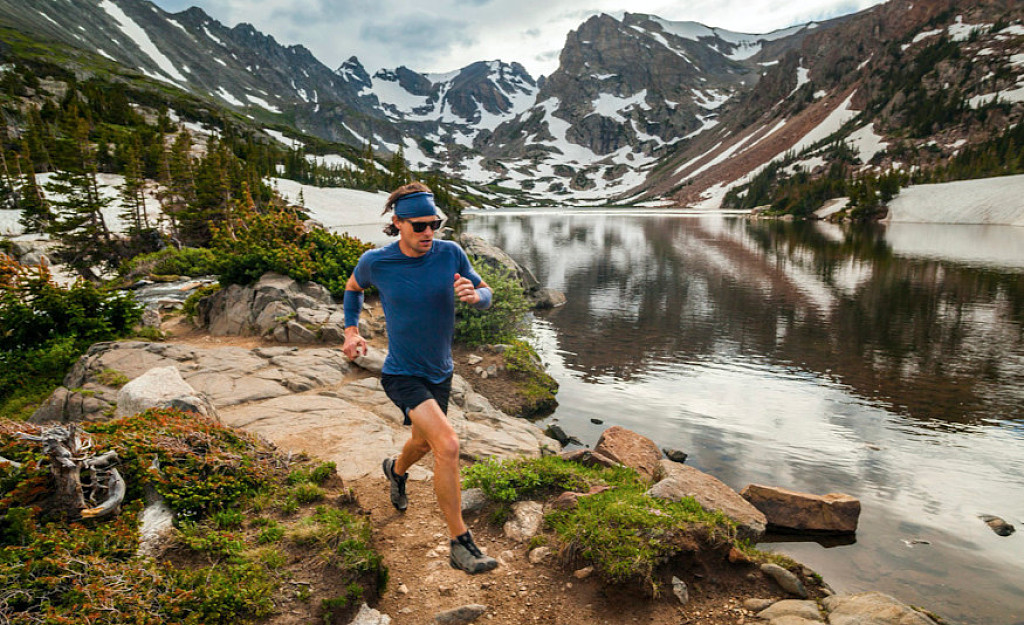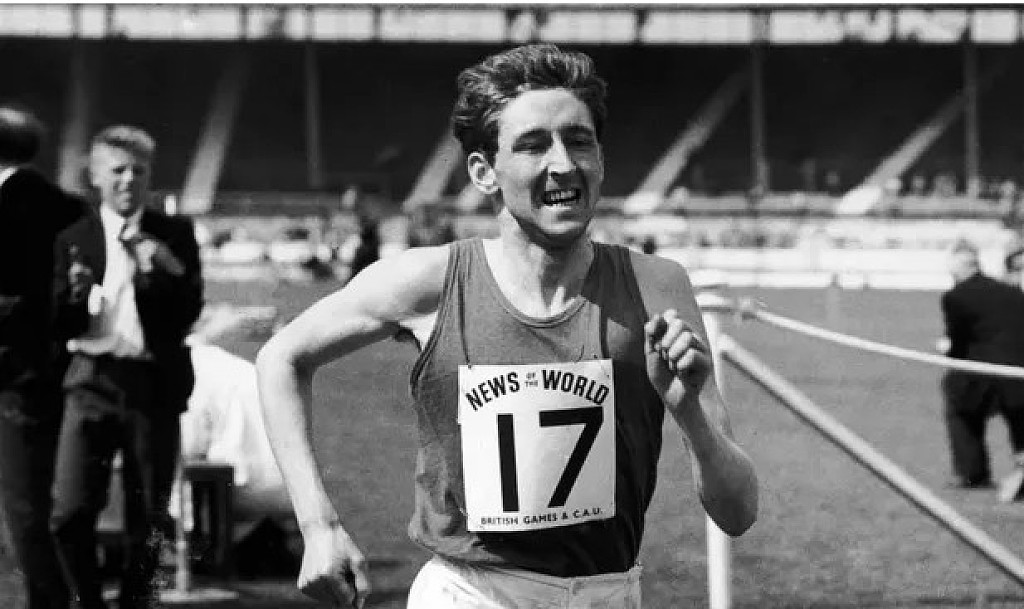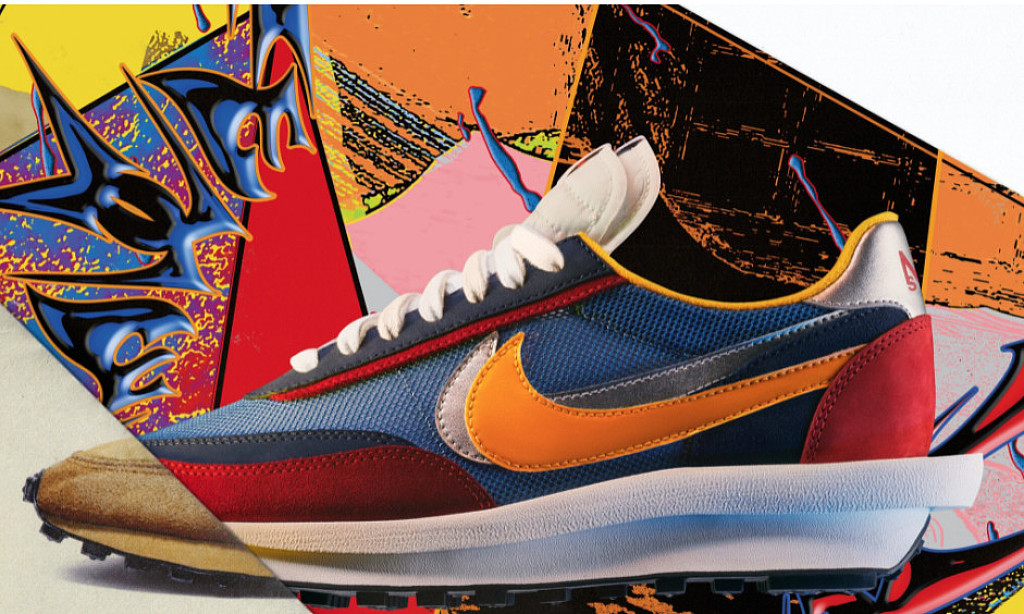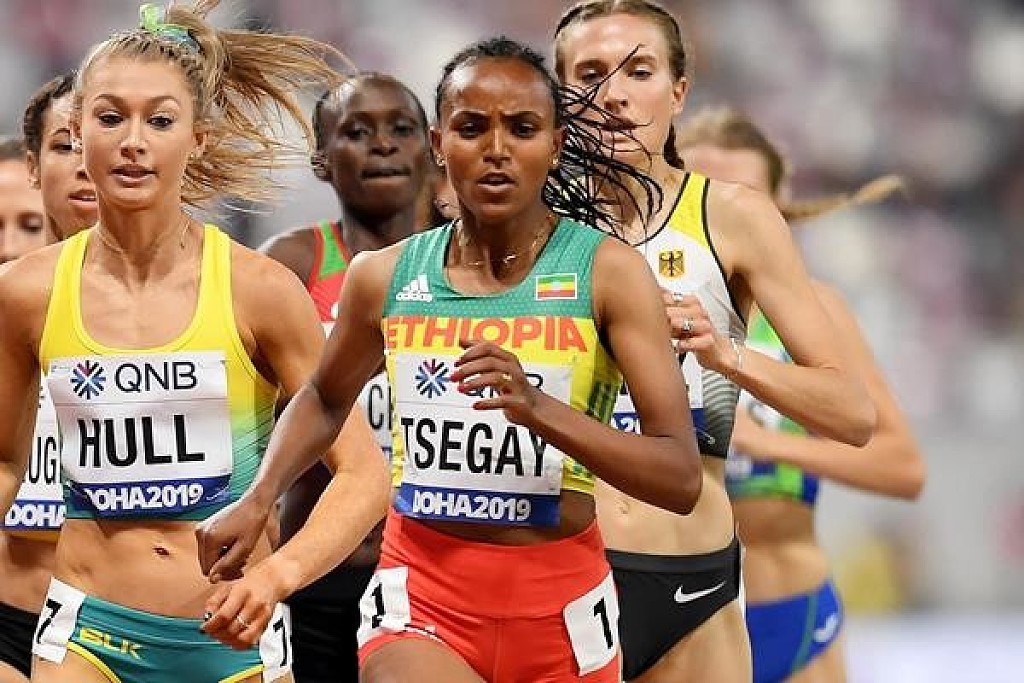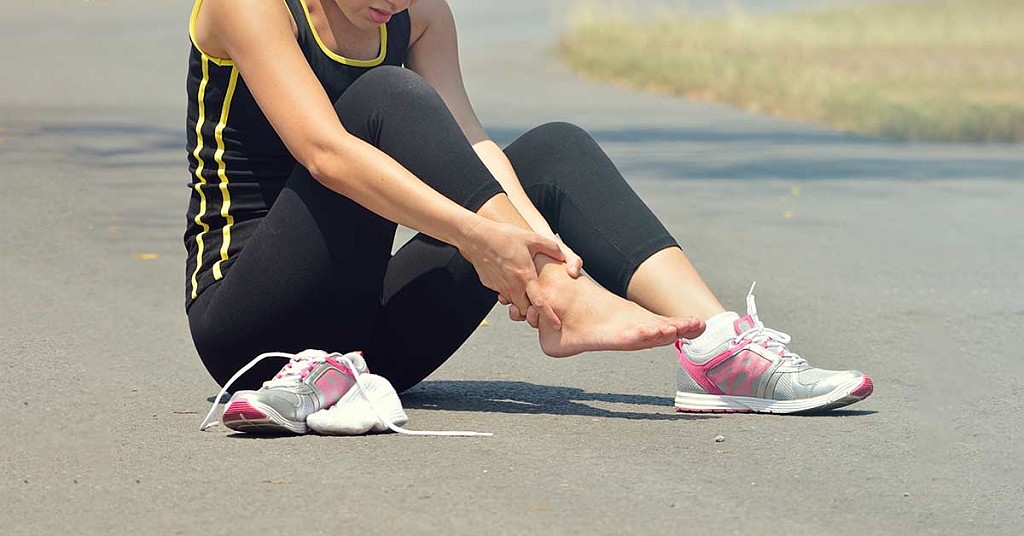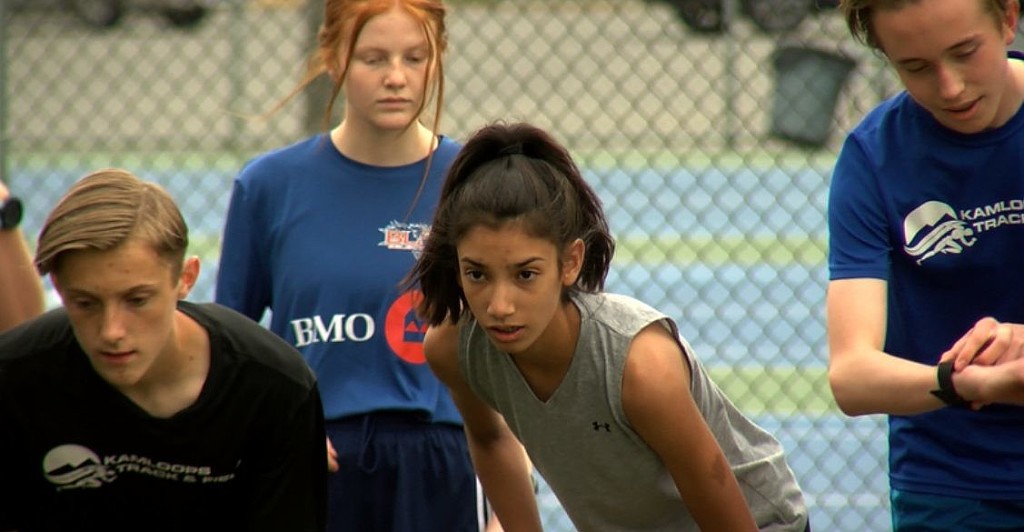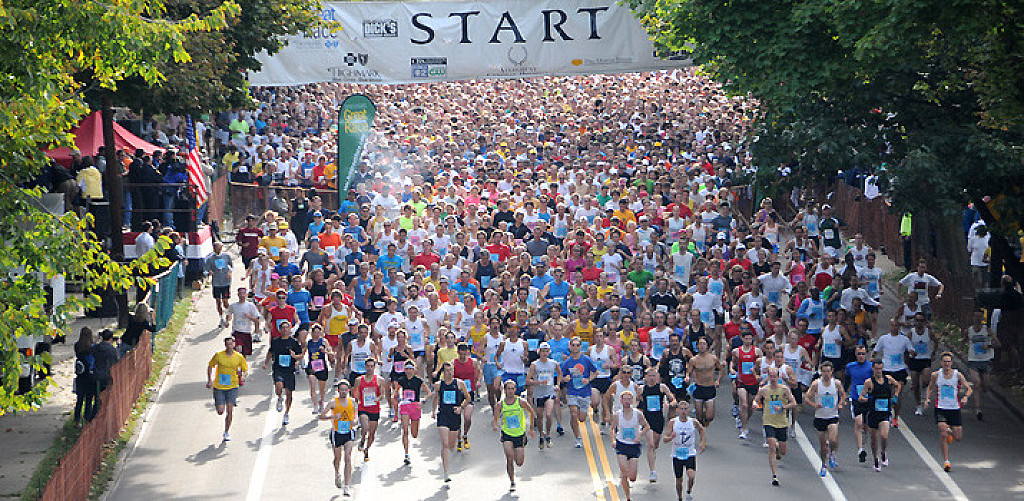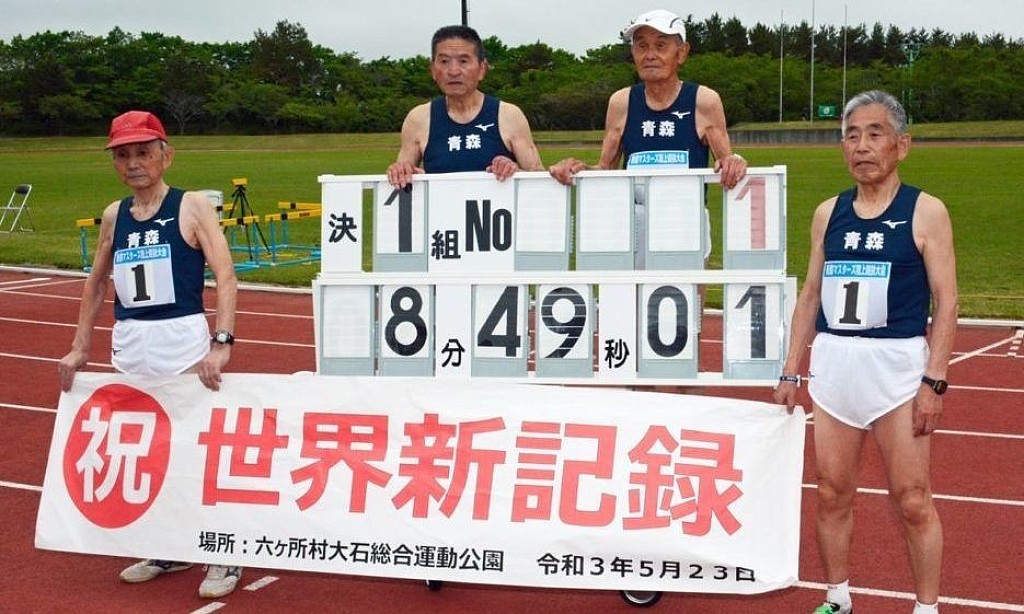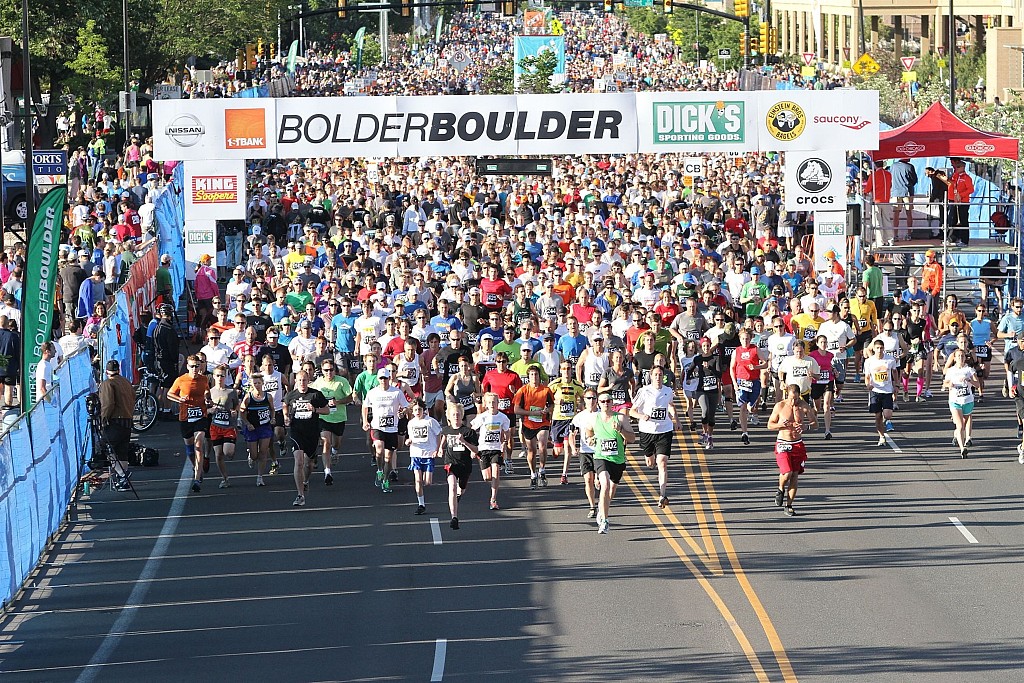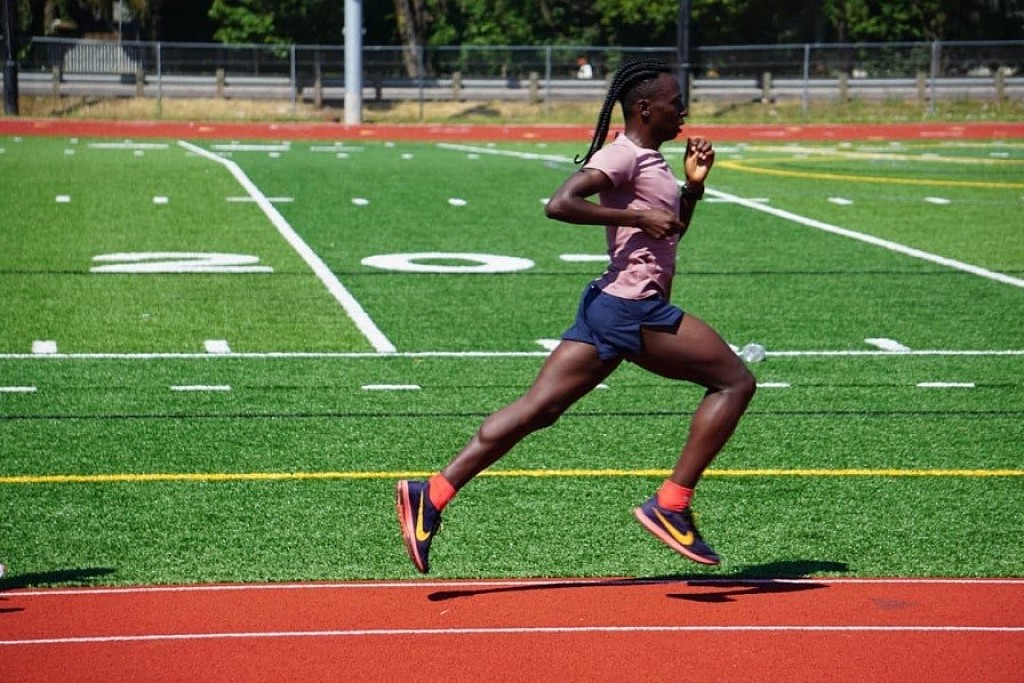Running News Daily
Running News Daily is edited by Bob Anderson in Mountain View, California USA and team in Thika Kenya, La Piedad Mexico, Bend Oregon, Chandler Arizona and Monforte da Beira Portugal. Send your news items to bob@mybestruns.com Advertising opportunities available. Over one million readers and growing. Train the Kenyan Way at KATA Running Retreat Kenya. (Kenyan Athletics Training Academy) in Thika Kenya. Opening in june 2024 KATA Running retreat Portugal. Learn more about Bob Anderson, MBR publisher and KATA director/owner, take a look at A Long Run the movie covering Bob's 50 race challenge.
Index to Daily Posts · Sign Up For Updates · Run The World Feed
Meet Chamonix's Trail Running Dog
Here's a lesser-known fact about Chamonix, France, one of the world's renowned trail running towns: it might just have the planet's highest density of tough mountain dogs. Here, there are dogs living at high mountain huts, guarding livestock, rescuing avalanche victims and even climbing ladders bolted to cliff sides. Dogs saunter along the pedestrian center of Chamonix, often unaccompanied, and wander into cafes and restaurants as if they own the places. And, in a sense, they do.
Into this mix, and reigning over the high northeast end of this 20-kilometer-long valley is the fluffy-but-tough Enzo Molinari Spasenoski Kotka, longtime trail-running partner to one of the world's strongest ultrarunners, Sweden's Mimmi Kotka.

Kotka, 39, though she lives a low-profile life with her husband Toni Spasenoski, is well known in the valley. Sponsored by La Sportiva, she has a litany of top finishes in the world's most competitive ultras. In Chamonix alone, she has won three races: the 90K in the Mont Blanc Marathon series, the Ultra-Trail du Mont-Blanc (UTMB) 101K CCC and the 119K UTMB TDS, during which she set a course record. Modest and easy-going, you will never hear Kotka brag about her successes. Well, almost never. Once, a few days after winning TDS, Kotka was stopped on a trail and got to deliver a line many dream of uttering. "Did you run one of the UTMB races?" a passerby asked. Kotka admitted that, why yes, in fact, she had. The questioning continued. "So, how did you do?" Kotka chuckled and beamed. "I won!"
Kotka, who has a Masters of Science in Molecular Nutrition and is a partner in Moonvalley, an organic sports food company, lives in the village of Le Tour, just below the Swiss border, with her husband Spasenoski, who works remotely as a high-tech project manager. And, rounding out the family, there is Enzo.
Spend more than a day or two on the quiet, rugged trails in this part of the valley and your paths will cross with Mimmi and Enzo. They are so often together, it's more common to hear Mimmiandenzo than the former without the latter.
Enzo, now 4, it must be said, is beautiful and highly photogenic. His thick, mottled coat of blue-gray, brown, black and white fur is perfectly suited for a life herding sheep high in Italy's Gran Paradiso region from where he came.
Kotka's trail-running partner seems to know just how gorgeous he is. "He's kind of a Diva," Kotka says. "He just wants attention. He'll lie down in front of onlookers, expecting to be admired and cuddled. We spoiled him, and we got the dog we deserve."
These days, Enzo is getting plenty of time in the limelight. Kotka's Instagram feed is filled with striking photos, taken by Spasenoski, of the two out in the mountains in all seasons. Spasenoski joins the two for runs, taking photos and struggling to maintain the pace. Enzo knows the drill, often climbing up to view points, puffing his chest like the Lion King surveying his kingdom. "He thinks he's a mountain guide, but really he's an influencer," Kotka laughs.
With or without the lens eye, however, Mimmiandendzo have a tight bond on the trail. Together, they have run to glaciers halfway up Mont Blanc and high-mountain huts like the Refuge Albert Premier perched on the jagged skyline high above their Le Tour home.
"Sometimes, when I'm running with him, I feel one energy." Kotka pauses, trying to explain the sensation. "I feel very connected to him." When she stumbles, she says, Enzo immediately runs back to her to make sure she's okay.
There are the inevitable bumps, of course. Herding is part of Enzo's DNA, and there's no off switch, either. Running high above their village, Enzo once spotted a sheep away from its flock.
"He went completely nuts," says Kotka. "He was barking like mad and not listening to me. At the time, I didn't understand the instincts of a shepherd dog." At other times, Enzo's been known to herd escaped sheep back to the right side of their fenced-in pastures.
For better or worse, those herding instincts apply when the animal has two legs, too-that can make for awkward moments when Kotka is running with friends and the group spreads out. "I feel sorry for the runner in the back," explains Kotka. "Enzo literally nibbles at their butt."
Like every mountain runner, Enzo has had his accident or two. Descending from the Possettes, a dramatic ridgeline that is part of the course of the Mont Blanc Marathon, he took a tumble over a cliff band. The two heard Enzo barking, far below. Early spring, he fortunately landed on a snowfield but had taken a long slide.
"He was OK, but frazzled," says Spasenoski. "I've done the same thing!" And a few winters ago, out with Kotka while she was ski mountaineering, Enzo injured his eye in a freak accident when he hit a metal object buried in the snowpack. An infection and cataracts ensued. To protect his eyes after the incident, their Italian adoptee received dog goggles for Christmas. They did not go over well.
"He wouldn't move. He was like a statue," says Spasnoski. "He was like, 'What the hell am I wearing?'" These days, Enzo takes a timeout during the rugged Alps winter season.
Along the thousands of kilometers of mountain trails they've shared together, Enzo has been a teacher as well. "I've learned a lot from Enzo," says Kotka. "I wasn't expecting that." [TK-any specific lessons?]
What other life lessons has their social media star imparted to the family? "Some days can be pretty crummy," says Spasnoski, "But then you see this guy," he says, gesturing downward. "And everything is OK."
"Enzo makes us a family," Kotka adds. "We have someone to care about. He's been good for our relationship. Besides, she adds, "He's such a character, and makes us laugh. And he has a good heart. Right, Enzo?"
The tail thumps once on the floor. Definitely.
Name: Named after Enzo Molinari, a character from Kotka and Spasenoski's favorite film, The Big Blue, about the world's greatest free diver. Before discovering trail running, Kotka had a brief obsession with free diving. All that remains are, she notes, a lifelong addiction to the film and a bad diver tattoo on her back. Molinari had a big personality and a kind heart.
Birthplace: Enzo was born at an organic honey farm in Valsavarenche, Italy, next to northern Italy's wild Gran Paradiso National Park. One of six pups, his mom is Australian Shepherd. His father has been narrowed down to one of three likely suspects, but has not come forward.
Age: Four, or 32 in dog years. Enzo turns 5 on June 12th.
Weight: 30 kilos, about 65 pounds.
Favorite animals: A very large, fat cat used to be part of the family, and to this day Enzo loves cats. (As a rule, they do not love him back.)
Running Routine: 10 to 20 kilometers a day. "Around here, that's a lot," says Kotka, alluding to the challenging nature of the terrain around Chamonix. Enzo avoids runs of more than a few hours, and during the warm summer months prefers to run in the early morning or later in the day ."He could easily go for 10 hours," says Kotka, who is cautious about the miles logged on Enzo's pads. "He loves riding lifts," she adds.
Longest Trail Run: The pair did a two-day reconnaissance of parts of UTMB's technical TDS course. "We went slowly," says Kotka, "and made plenty of stops."
Favorite food: Homemade cheese pizza. "Eating some of a pizza I made was the only time he didn't greet Mimmi," says Spasenoski. "He's Italian. What do you expect?"
When he's not trail running: Napping on cool surfaces and sniffing human butts.
House rules: Enzo's not allowed in the bed. "It's too hot for him, anyway," says Kotka. Instead, he sleeps near the drafty balcony door. After breakfast, he'll often sleep outside in the cool mountain air that blows off the nearby Le Tour glacier.
(06/06/2021) ⚡AMPby Trail Runner Magazine
What You Need To Know About Running Shoes And Injuries
At age 50, I have recently begun to wonder how my body will hold up for running (and life) over the long haul given that in the last decade, I have dealt with several lingering bouts of Achilles tendinitis, a painful stint of iliotibial (IT) band syndrome, a functional leg-length imbalance that led to an angry case of sciatica, a debilitating case of runner's knee, one frustrating case of shin splints, and an excruciating ruptured Achilles. Not all of those injuries were caused by running, but each one presented itself when I ran.
This has led me to think a lot more about the shoes I choose to wear and the marketing promises that accompany them. Can they really help me run longer, healthier, and injury-free? Conversely, might they be causing my problems?
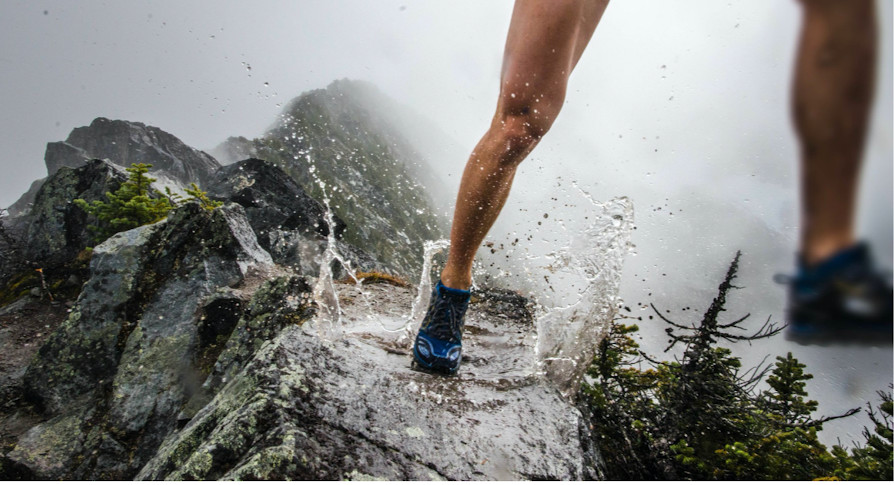
Despite the continued evolution of running shoes since the 1970s, the rate of injury among runners has remained high and, depending on which report you read, might even be climbing. Reports of annual injury rates vary widely, from 20 percent to 92 percent, but the average rate is somewhere around 50 to 60 percent. That means more than half of the running population gets dinged up in some fashion every year. Imagine that as every other runner in your local running group, or fully half of the 50,000 participants who line up to start the New York City Marathon every November.
It's a startling injury rate. Might shoes be the culprit? Absolutely not, says Jay Dicharry, who authored Running Rewired: Reinvent Your Run for Stability, Strength & Speed.
Dicharry has published numerous research studies about running mechanics, and he insists that running shoes don't cause injuries. "There are better and worse shoes for an individual runner based on their gait characteristics, but running shoes are not the cause of injuries," he says.
There has never been a correlative link between injuries and running shoes, he points out, which sounds like a convincing exoneration of shoes from where I sit, though it's important to note that there also haven't been many studies. In fact, in the only study that has remotely produced some interaction between running shoes and injury rates, 81 female runners were categorized by foot type (neutral, pronated, highly pronated) and randomly assigned neutral, stability, or motion-control shoes.
After basic information about their gaits was recorded, the runners were put through a 13-week half-marathon training program. Of the 194 training days missed by the test subjects due to pain or ailments, 79 were missed by runners wearing motion-control shoes, followed by 64 by neutral-shod runners, and 51 by stability-shoe wearers.
The neutral runners reported greater pain values while running in neutral shoes than in stability shoes; runners with pronated gaits reported greater pain values while running in stability shoes than in neutral shoes. No significant effects were reported for runners with highly pronated gaits. Ultimately, the study concluded that the "current approach of prescribing in-shoe pronation control systems on the basis of foot type is overly simplistic and potentially injurious." But the researchers admitted that the study was too small and didn't take into account enough factors to be conclusive.
Even with the advancements in kinesiology; the study of biomechanics, the human body, and materials science; and massive investment and vested interest from shoe companies, relatively little is known about how shoes actually impact our ability to run, no matter whether it is 100 meters, 100 miles, or somewhere in between.
There is no universal understanding of or agreement on how shoes should be designed and built to improve efficiency, maximize energy return, and reduce the risk of overuse injuries that, some research shows, may be caused by the repetitive motions of a running gait.
The Pronation Effect
In the 1970s, there was tremendous focus on stability and motion control. Despite the fact that at the time, there was little science related to human running mechanics, brands became obsessed with the notion that pronation could be harmful to a runner's heath.
Although high-speed video cameras and force-plate treadmills weren't yet available to analyze running gait, biomechanists, podiatrists, coaches, and shoe developers pointed to this inward rolling as one of the causes of common running injuries. As a result, the shoe war encountered a brand-new battlefield, one concerned with how to control the movement of a runner's feet-an idea that, although never grounded in science, has lingered into today. Science or no science, it has been a powerful marketing and sales tool.
In 1977, Brooks introduced several shoe models that supported the interior side of the heel with its Varus Wedge. The firm foam piece was engineered to provide greater stability, increase heel and foot protection, and improve running efficiency while decreasing muscle and tendon fatigue.
The Brooks Vantage was the first shoe designed to control the inward rotation of the foot, a motion that would soon be known by the industry-wide catchphrase "overpronation." Under the guidance of renowned podiatrist Steven Subotnick, who would later author Cures for Common Running Injuries, Brooks attempted to counter the rolling of the foot toward the medial side with a wedge that not-so-subtly canted the foot outward to the lateral side.
Brooks's innovation sparked dozens of imitators and eventually led to a whole new category of shoes based around stability and motion control. But it also led the industry down a misdirected path of self-help without compelling scientific evidence or quantifiable results. Soon every brand had its own feature designed to restrict overpronation-the most common being the medial post, a firmer-density midsole foam located under the arch of the foot. Worse yet, it also prompted the unsavory practice of brands hiring scientists and paying for the lab results they needed for their marketing programs that supported their new shoe models.
While innovation can be good-and even imperative at times-the problem was that a lot of the innovation was being fueled not by science but rather by marketing hype and copycat imitation, neither of which necessarily led to better performance or more efficient running, even if they decidedly did lead to selling more shoes and developing a vernacular to support three types of shoes (neutral, stability, and motion control). Worse, the new trend didn't reduce a growing epidemic among recreational runners: overuse injuries such as shin splits, Achilles tendinitis, plantar fasciitis, patellar tendinitis, and runner's knee.
Dicharry doesn't think shoe brands are really listening to what science-specifically kinesiology and anatomy-is telling them.
"For a long time, the running shoe industry has had a bias that suggests a running shoe has to stop parts of your body from moving and force something to move in a different way," he says. "That's based on unfounded ideas that evolved 40 or 50 years ago. Science shows that doesn't exist and never did. People are variable and move differently, and that's OK."
Dicharry says that until brands stop trying to control or limit movement, shoes will never fully move forward. "The foot is an adaptively controlled lever; it's not just one rigid thing that moves one way. It's all about adapting and conforming." His insights beg the question: If every runner has his or her own preferred path of movement based on specific anatomical variances and irregularities, is it even possible to mass-produce a commercial product that will actually improve performance and reduce injury risk for a wide range of runners?
Dicharry insists that it is possible, but "you would mostly have to scrap the model of how shoes are built and marketed." There is sufficient technology and understanding of how to do it, he says; however, mass production and an entire recategorization of running shoes are still significant inhibitors.
Until that happens-if indeed it ever does, at least for a wide audience- the biggest challenge facing running shoes may be that they're not keeping runners from being injured. Despite numerous advancements in outsole rubber, midsole foam, training philosophies, and understanding of how the body moves, there has yet to be a shoe that has shown the ability to reduce injuries. The incidence rate of common running injuries has remained constant since they began being monitored, with most surveys and studies showing an average of 50 to 60 percent of runners being injured every year.
An essential piece of the puzzle cannot be ignored: Running shoes are a commodity, and every running shoe company is in the business of designing and manufacturing shoes for the sake of selling as many as possible. The A-goal is not improving performance or reducing injuries-and perhaps with good, or at least justified, reasoning. Because while running shoes have both functional and aesthetic cues-along with loads of marketing hype-consumer purchasing surveys have shown that the color or aesthetics of a shoe often influences a runner's purchasing decision more than its perceived ability to help that individual run better.
Ultimately, it's not in the best interest of a shoe brand to really hone a message about training better, becoming stronger, and fixing one's mechanics because that proves that it's not about the shoes, or at least makes shoes a secondary factor in healthy running. Plus, it's too risky for a running shoe brand to make a claim even remotely suggesting that its running shoes can reduce the chance for injuries. Instead, it is in every brand's financial interest to make shoes that look good and feel good and come with a good marketing story.
Form & Fitness
When it comes to running's extraordinarily high annual injury rate, many people want to blame their shoes, but that's like blaming the tires on your car when the engine won't start, insists Reed Ferber, PhD, the founder and director of the Running Injury Clinic at the University of Calgary.
"Running shoes are definitely not the cause of injuries," he says, echoing Dicharry. "Shoes are a small piece of the puzzle that people have focused on as being the cause or salvation of running injuries, but that's just not the case."
Ferber says that the one thing the running research community agrees on is that the most common running injuries, especially those suffered by recreational runners, are caused by doing too much, too fast, too soon. In other words, overuse injuries such as shin splits, Achilles tendinitis, runner's knee, IT band syndrome, plantar fasciitis, and many types of stress fractures are caused by user error: running too many miles or running too hard during workouts without adequate aerobic fitness, leg and foot strength, or flexibility.
When it comes down to it, most recreational runners aren't nearly as aerobically fit or as functionally strong as they could be. "Not even close," says Mark Plaatjes, a Boulder, Colorado-based physical therapist, coach, and owner of In Motion Running, a running specialty store. The former world-class runner-and 1993 world champion in the marathon-points to the stark difference between how elite runners train and how the average runner trains.
Not only are elites leaner and stronger, he says, but they're also running higher-mileage weeks-thus becoming much more aerobically fit and efficient-and dedicating equal hours every week to strength training, form drills, therapeutic work, and recovery. The majority of recreational runners don't have the time or interest to do those things, he says, and they often pay the price through the resulting overuse injuries.
Plaatjes points out that this lack of comprehensive training is also the reason that the minimalist shoe revolution was a disaster for many people. The shoes weren't the problem, he insists. In fact, there were merits to the idea that minimally constructed shoes would help build foot strength and cue better running form. The trouble was that few people were willing to take the time to ease into wearing those kinds of shoes and do the considerable amount of work it would take to prepare their bodies to adapt.
While minimalist shoes weren't to blame for injuries, the movement simultaneously proved that running shoes couldn't prevent injuries, either. Yes, running shoes can be a tool to improve your running, but the most vivid takeaway from the minimalist revolution was the reminder that most runners need an ample amount of cushioning and protection between foot and ground, and that good running form (and the proper strength, posture, and flexibility that go with it), not newfangled running shoes, is the key to healthy, efficient running.
Doing core strength work, drills, and plyometric exercises can give you a general boost toward running better, more efficiently, and maybe even faster. But the only way to create a specific program for improving as a runner is to gain a detailed understanding of how the individual body operates as it runs-how it moves, where it is strong, where it is weak, where it is asymmetrical. These mechanics can be revealed through a high-tech gait analysis.
At his lab in Bend, Oregon, Dicharry uses state-of-the-art force-plate instrumented treadmills and high-speed cameras to analyze a runner's gait data in real time. He routinely tests fit and functionally strong runners who move efficiently and stabilize their body effectively but have a specific gait aspect that needs improvement. It might be subpar cadence, poor running posture, or a propensity to overstride. Postanalysis, Dicharry and his team of physical therapists and coaches provide exercises and drills to help cue improvement in those areas.
"Some issues have nothing to do with running," Dicharry says. "They might be lifestyle problems developed from everyday life, but they show up in running or other things you might do, whether it's walking or riding a bike or swimming."
The Shoe Factor
Generally speaking, Dicharry believes most runners can benefit from running in "less" shoe, especially models that don't inhibit the natural motion of a foot. But he cautions against making big changes-to a more minimally designed shoe or a shoe with a lower heel-toe offset-too quickly.
However, he points out, running in a variety of different kinds of shoes on a weekly basis is the best scenario for a runner, and there is science to back up that statement. A 2013 study conducted in Luxembourg showed that recreational runners who rotated among multiple models of shoes during a 22-week study had a 39 percent lower risk of running injury than those who almost always ran in the same shoes.
"Having a quiver of shoes exposes your body to different ways of interacting with running surfaces, different muscular responses, and different neurological reaction timings," Dicharry says. "Variability is a good thing, so switching up your running shoes several times a week is a very good thing."
Like Plaatjes, Ferber believes most runners can make headway by improving their overall fitness and functional strength to become less injury prone, but he doesn't necessarily believe in overhauling a runner's gait. Plaatjes, in contrast, is concerned about the industry-wide shift and strongly disagrees that most runners should be running in soft, flexible neutral shoes, insisting that many runners still need some support and stability, especially as they become fatigued during longer runs. The best way to provide that support, he says, is via stability shoes or after-market insoles.
"The answer to reducing injuries, enhancing comfort, and improving performance is not to change or fix a runner's 'flaws' but to work with the natural and highly individual motion paths of the joints," says Carson Caprara, senior director of global footwear product management at Brooks. "The focus then becomes keeping a runner in this path of least resistance for as long as possible during a run. For some runners, the variables of shoe geometries, midsole hardness, or excessive stabilizing technologies can push them outside of their preferred motion path. The task of modern running shoes should be to help these runners stay within their unique motion corridor at all times."
Brooks outlined a holistic approach to designing and fitting running shoes that would optimize efficiency, reduce injury, and enhance comfort. Instead of breaking down its shoes into neutral, stability, and motion-control categories that took into consideration one factor-the level of pronation at the ankle-it came up with new categories based on four biomechanical silos related to cushioning, energizing, connecting, and propelling a runner's experience. And it acknowledged that the individual's preference had a lot to do with what shoe would be best for that person. The brand concluded that shoes allowing runners to run in their natural preferred state on the path of least resistance, rather than attempting to correct perceived problems or deficiencies, would provide the best experience and be the most comfortable. Brooks became the first brand to ditch medial posts to control overpronation in favor of a new system of guiderails that offer just enough support for that particular runner's feet and gait style.
However, it has become increasingly clear that there is no magic bullet, and that ultimately, it is less about shoes and more about how a runner is training and taking care of his or her body on a daily basis.
Advances in footwear, training, and technology might have an effect on how a runner moves, but how and whether those changes will impact the rate of injuries remains a big question mark. In the end, running is both a very simple and an extremely complex activity, a polarizing set of parameters that leave it open and vulnerable to the interpretation, style, and experience of each individual runner. The key to healthy, efficient running has less to do with shoes than with the time, effort, care, and passion that each of us puts into it.
"Don't spend time opening your wallet; spend time opening your mind to making yourself a better athlete," Dicharry says. "There are multiple ways of improving as a runner and getting faster, and none of them require spending money on a piece of footwear. Make your body better and you'll run better."
(06/06/2021) ⚡AMPby Trail Runner Magazine
Gyms’ losses may be running’s gains in 2021
A recent survey found that only 15 percent of gym-goers think the gym is the best way to keep fit heading into the new year
Gyms have taken a massive hit this year as many have been closed at various times throughout the pandemic, and a recent study conducted by RunRepeat isn’t forecasting much of an improvement in 2021. The study surveyed 1,990 gym members from 120 countries, of whom only 15.18 percent say they think the gym is their best option for reaching their fitness goals in the coming year. Another RunRepeat study notes that 25 per cent of gyms are expected to close for good by the end of 2020. While this is bad news for gyms, it could be good news for the running community, as many former gym members say they plan on sticking with outdoor exercise to work on their fitness in 2021.
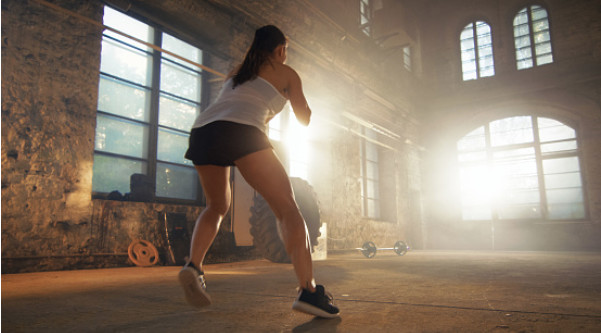
The lack of interest in working out at a gym makes perfect sense when considering the pandemic. Left with nowhere to exercise other than outside or at home, people all over the world took to running (causing a huge running boom in the spring) and bought fitness machines and equipment. Now that so many people have realized they can continue to progress toward their fitness goals without going to the gym (and therefore saving money by avoiding a monthly membership fee), they have no desire to return, even when it’s deemed completely safe.
At the start of the year, 63 percent of gym members said they thought the gym was their best fitness option. That dropped significantly as the year progressed, and now just 15 percent of gym members still hold that belief. Conversely, a whopping 49.9 percent say running and other outdoor activities provide the best opportunity for maintaining fitness and reaching goals in 2021. This is up from just 35 percent earlier in the year.
This is bleak news for the fitness community, but for the running world, it could be a good sign. We still have to wait to see if the spring’s running boom will lead to more long-term runners, but if the RunRepeat numbers are correct and many people don’t plan on returning to the gym, then we might see high rates of participation in races when in-person events eventually make a comeback.
Even though many people have turned to running in recent months, the running community and event organizers are still hurting. In-person racing will hopefully return soon, but for now, virtual events are our only option. It’s more important now than ever before to support our local organizers, or else many of them could suffer the same fate as many gyms and be forced to fold. Whether you’re a new runner or a seasoned veteran, consider adding some virtual races to your calendar. With this holding you accountable, it will be easier to convince yourself to train, which will help you reach your overall fitness goals.
(06/06/2021) ⚡AMPby Running Magazine
Canadian record-holders Levins, Elmore headline Canada's marathon team for Tokyo
Seventeen years after she last raced at the Olympics, distance runner Malindi Elmore has earned a spot on Canada's team for Tokyo, while Cam Levins will race at the Games after dipping under the qualifying mark with just a week to spare.
The two Canadian record-holders in the marathon highlighted Athletics Canada's team of long-distance runners and race walkers nominated on Friday.
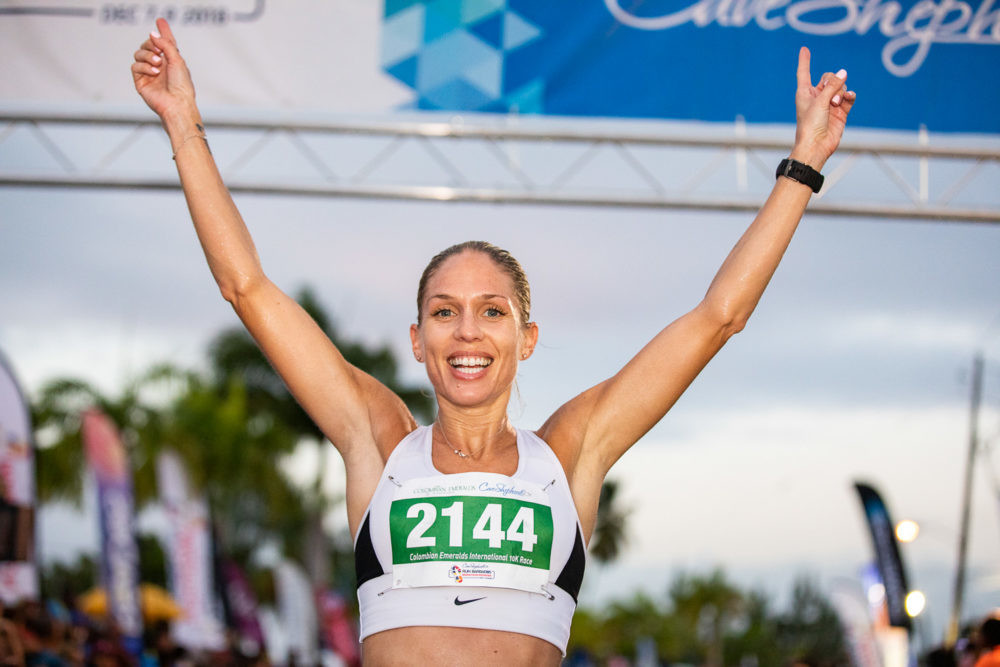
Nine Canadian marathoners had achieved the qualifying criteria in the marathon, but each country is allowed only three men and three women, leading to speculation about the squad in recent weeks, and posing a good problem for Athletics Canada with the depth of talent.
"Over the past few years, Canadian middle- and long-distance runners have accomplished great things on the track and on the road," Athletics Canada's head coach Glenroy Gilbert said in a statement. "In Tokyo, we'll see a new generation of marathoners who have broken Canadian records, established impressive personal bests on-demand in less-than-ideal conditions and made a name for themselves in the gruelling 42.195-kilometre event.
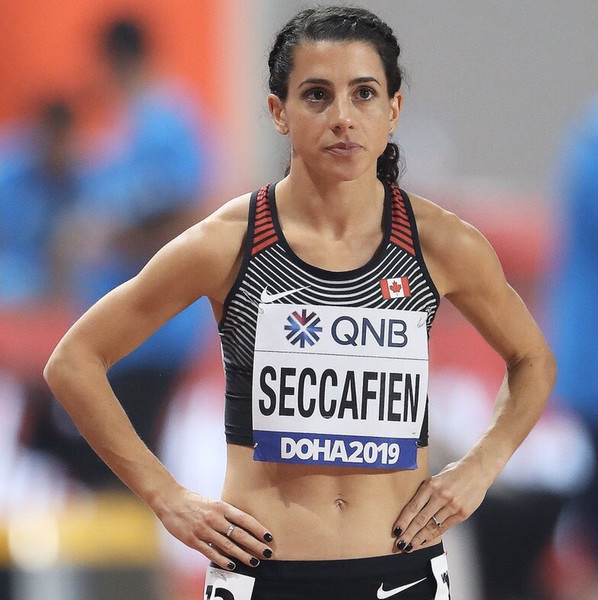
"We are excited to see what this group can do in Sapporo against the greatest athletes in the world, as they deserve to be there."
World bronze medallist Evan Dunfee tops the race-walk team, while Mohammed Ahmed and Andrea Secdafien earned spots in the 10,000 metres.
The rest of Canada's track and field team will be announced at a later date.
Dunfee had already clinched his spot on the team based on his bronze at the 2019 world championships, while Dayna Pidhoresky and Trevor Hofbauer had previously earned automatic berths after winning the women's and men's Canadian marathon titles.
Elmore is a terrific comeback story. The Kelowna, B.C., native ran the 1,500 at the 2004 Athens Olympics missing the semifinals by one spot, then retired from track in 2012 and became a world-class Ironman triathlete. Moving down to the marathon in 2019 — as a mom of two, she said it requires less training time than the Ironman — she broke the Canadian marathon record in January 2020.
Natasha Wodak, who's raced at three world championships in the 10,000 metres, is the third Canadian woman on the marathon team.
Levins, a finalist in the 5,000 and 10,000 at the 2012 London Olympics, shattered the Canadian record in his marathon debut in 2018. He fell short on two attempts over the past year to qualify for Tokyo, but the 32-year-old from Black Creek, B.C., finally dipped under the mark on May 23 — a week before the qualifying window closed — in Styria, Austria, despite running in rain and alone for the last 25 kilometres of the race.
Ben Preisner is the third men's marathoner nominated to the team.
"I am so pumped about this group of athletes," said Canada's chef de mission Marnie McBean. "They chose the 'suffer' events and make them look easy. Many of their recent results have been a beacon of light for the whole of Team Canada."
Mathieu Bilodeau joins Dunfee in the 50-kilometre race walk based on his world ranking.
The marathons and race walk events will be held in Sapporo due to Tokyo's heat, and because of COVID-19, athletes will be restricted to staying in Sapporo.
"Woohoo! Stellar Sapporo crew locked in," tweeted Dunfee, who was fourth at the 2016 Rio Olympics. "We'll be the only Team Canada teammates we see at the Olympics, sequestered 800km away, so I'm stoked that these people are all so lovely."
Mohammed Ahmed and Andrea Seccafien were nominated in the men's and women's 10,000. Ahmed owns the Canadian records in the 5,000 and 10,000 and won bronze in the 5,000 at the 2019 world championships. Seccafien broke the Canadian record in the 10,000 just three weeks ago.
The window to qualify in the 10,000 remains open for another month, so Canada could add runners in that distance based on either their world ranking or by achieving an automatic entry standard.
(06/05/2021) ⚡AMPby Canadian Press
Tokyo 2020 Olympic Games
Fifty-six years after having organized the Olympic Games, the Japanese capital will be hosting a Summer edition for the second time, originally scheduled from July 24 to August 9, 2020, the games were postponed due to coronavirus outbreak, the postponed Tokyo Olympics will be held from July 23 to August 8 in 2021, according to the International Olympic Committee decision. ...
more...There will be zero marathon runners from India at the Tokyo Olympics
Marathon races in the Olympic Games have been a permanent fixture in the men's roster since the inaugural Athens Games of 1896, while the women's event was first held 88 years later in Los Angeles. Ethiopian athletes have enjoyed the most successful in Olympic marathons, with men winning four golds; two of which came from Abebe Bikila in 1960 and 1964, who was the first athlete to win back-to-back golds (the only other athlete to win two golds in the marathon was East Germany's Waldemar Cierpinski in 1976 and 1980), and Ethiopian women have won two golds.
The Olympic records are 2:06:32 for men, set by Kenya's Samuel Wanjiru in 2008; and for women, it's 2:23:07 seconds, set by Tiki Gelana of Ethiopia in 2012.
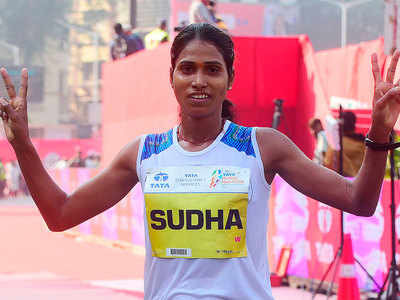
India's history at the marathon dates back to 1928 when Phadeppa (Pavananjey) Dareppa Chaugule became India's first Olympic marathon runner. He represented India in the 1920 Summer Olympics in Antwerp, Belgium, and finished 19th with a timing of 2 hours 50 minutes 45.2 seconds. He hails from the town of Belgaum (Now Belagavi) in Karnataka.
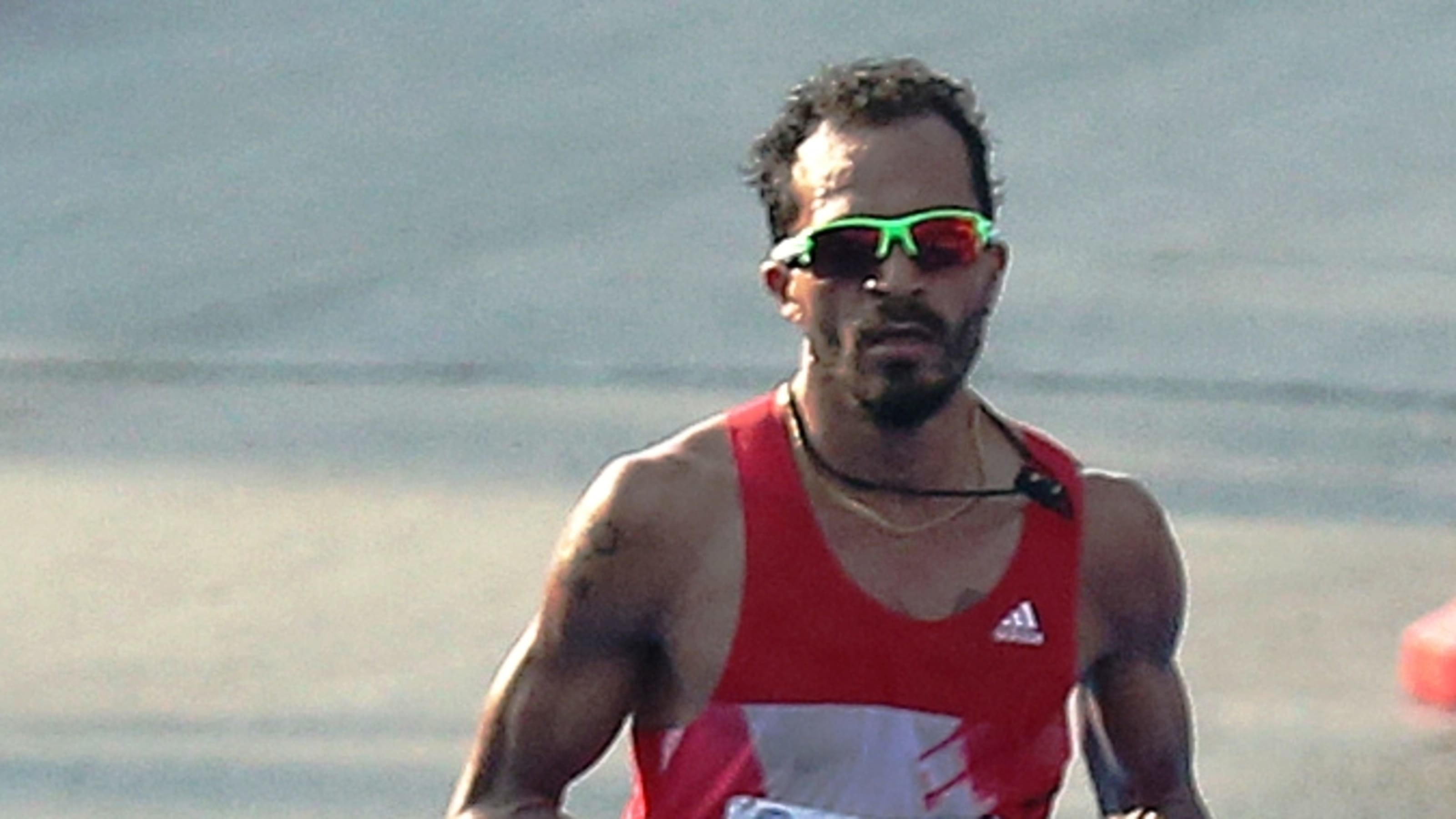
With the passage of time, many Indian marathon runners have taken part in the Olympics, with the 2016 Rio Olympics, having the highest number of five athletes - Thonakal Gopi, Kheta Ram, Nitendra Singh Rawat among the men, O.P. Jaisha and Kavita Raut among women. However, five years down the line nobody from India will be qualifying for Tokyo Olympics in the marathon.
Why did Indian athletes fail to qualify in marathons for Tokyo Olympics? To understand the reason one has to know the qualification process for the marathon at the Tokyo Olympics. The athletes in marathons (both men and women) can qualify by either entry standard or qualify by ranking during the qualifying period. The qualifying standard is 2:11:30 for men and 2:29:30 for women, while the qualifying period was originally from 1 January 2019 to 31 May 2020. Due to the COVID-19 pandemic, the period was suspended from 6 April 2020 to 30 November 2020, with the end date extended to 31 May 2021. The world rankings period start date was also changed from 1 January 2019 to 1 December 2018.
With so many runners qualifying by meeting the entry standard, there was no scope left for an athlete through the world ranking. Indian athletes' hopes were shattered mostly because of the coronavirus wreaking havoc without allowing the Athletics Federation of India (AFI) to conduct marathons at regular intervals since 2020. Though the date was extended to 31 May 2021, India hosted fewer marathons, and also the potential challengers for Tokyo Olympics took part in a few of them hoping to qualify through the marathons hosted in 2021. With the second wave of coronavirus hitting India hard again, many of the marathons got cancelled and as a result, India's best marathon hopefuls could not meet the qualifying standard. Among the men, the hopefuls were Nitender Singh Rawat, Srinu Bugatha and Rashpal Singh.
While Rawat attained a personal best of 2:15:52, Bugatha and Rashpal could attain 2:14:59 and 2:18:57 during the qualification period. Among women, Sudha Singh had a PB of 2:34:56, Jyoti Gawate a 2:45:48 and Swati Gadhwe 2:58:10. With nobody being able to meet the mark, India will have to go to the Tokyo Olympics without a marathoner.
(06/05/2021) ⚡AMPby The Bridge
Tokyo 2020 Olympic Games
Fifty-six years after having organized the Olympic Games, the Japanese capital will be hosting a Summer edition for the second time, originally scheduled from July 24 to August 9, 2020, the games were postponed due to coronavirus outbreak, the postponed Tokyo Olympics will be held from July 23 to August 8 in 2021, according to the International Olympic Committee decision. ...
more...PUMA to become the Official Footwear and Apparel Partner of the Boston 10K for Women
Conventures, Inc., organizers of the Boston 10K for Women, presented by REI, today proudly introduced PUMA as its official footwear and apparel partner. In further demonstrating its commitment to women’s running, the footwear and apparel company will provide pre-event activations, on-site engagements at Boston Common, and will become the title sponsor of the event’s elite athlete field. The Boston 10K for Women is the longest-running all-women’s sporting event in New England, and will return to the roads this October for its 45th running.
PUMA’s support of the event will put PUMA’s logo on the race bib number, PUMA footwear on race officials, and the “Elite Field, Powered by PUMA” will help support visibility for the event’s elite field. The new race partnership is the latest illustration of PUMA’s deep commitment to Boston, to running, and to women, and allows the company to align itself with the largest all-women’s race in New England for multiple years.
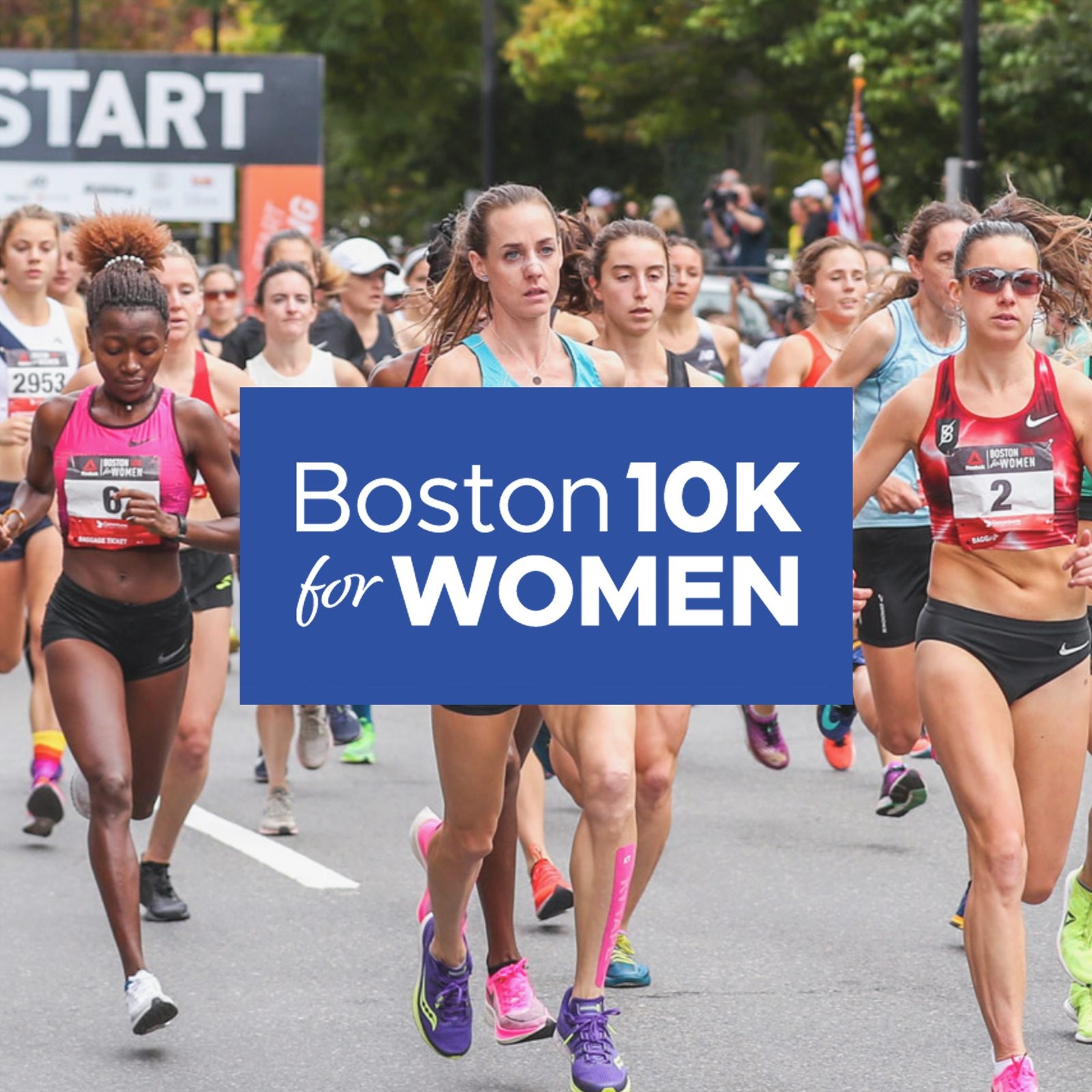
“When we recognized the opportunity to partner with such a historic and important race that supports female runners, we could not have been more excited to get involved,” said Erin Longin, Global Director of Running & Training at PUMA. “With PUMA Running we are looking to spark change in the running industry and champion female runners. The event brings out the best in women of all abilities, and it is a shining example of the sisterhood, compassion, and energy that unites us all. It’s a great day, and we can’t wait to be out there.”
“It’s a bounce back year for women’s running, and as runners reunite around the country, the sport needs companies like PUMA to lead, which is exactly what they’re doing,” said Dusty Rhodes, who founded the race in 1977. “A road race is where everyone can line up as equals, compete, have fun, and support each other. It’s a unifying phenomenon, and PUMA recognizes the power of race day.”
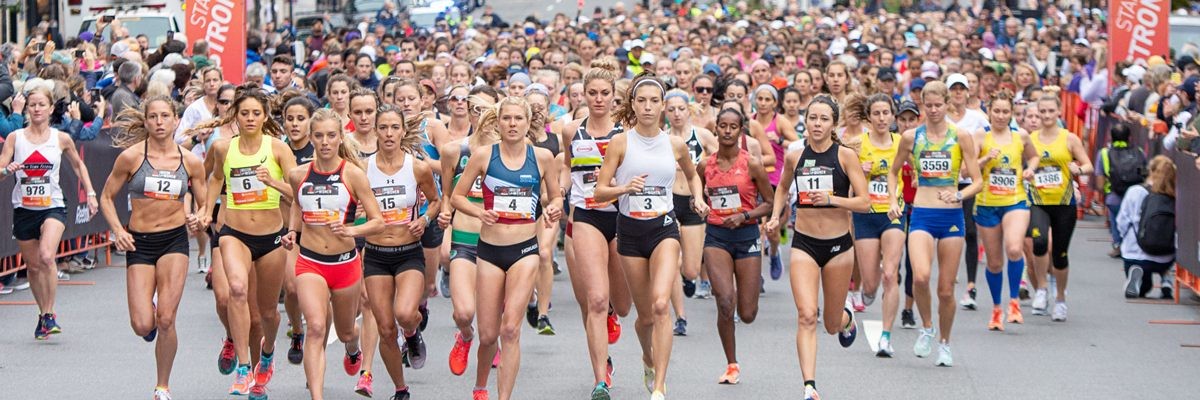
Held every year on the second Monday in October, race organizers yielded their traditional race date to accommodate the 125th Boston Marathon, scheduled for Monday, October 11, 2021. The race date for 2021 Boston 10K for Women will be announced shortly, and the event will accommodate as much of an in-person component as it prudently and safely can.
The event features hours of pre-race and post-race athletic and wellness programming to complement the flat and fast 6.2-mile course, where runners cheer for each other along stretches of the Charles River. The course features sweeping views of the Boston skyline, a few twists and turns, and comes to a dramatic finish at Boston Common. In 2020, the event converted to a six-day virtual event, where runners from 40 states and 10 countries took part in the 10K at a time and location of their choosing.
About Boston 10K for WomenEstablished in 1977 as the Bonne Bell Mini Marathon, the Boston 10K for Women is the longest-running all-women’s sporting event in New England. With thousands of runners and spectators each year, it’s New England’s largest all-women’s road race, and has been organized every year by Conventures, Inc. The race features a flat out-and-back course through Boston’s Back Bay neighborhood and scenic stretches of Memorial Drive in Cambridge. More than 183,000 women have raced in the event since its inception. For more information on the race please visit www.boston10kforwomen.com.
(06/05/2021) ⚡AMP
by Running USA
ASICS introduces tool to measure running’s effect on the mind
ASICS has launched a worldwide study on the effects of exercise on mental health and wellness, and everyone is invited to participate. The study employs a new online tool designed by the team at ASICS called the Mind Uplifter, and it uses facial recognition software and individual self-reports to analyze your mental state before and after exercise. The program announcement was timed to coincide with Global Running Day, and ASICS is hoping to reach one million minds in the coming months.
The Mind Uplifter

The Mind Uplifter takes users through several steps. First, it performs a facial scan, which the ASICS team says will read your emotional state. Once your scan is complete, you’ll be asked six quick questions about your current mental state, such as “How calm are you right now?” and “How confident are you feeling?” You respond on a scale from zero to 10.
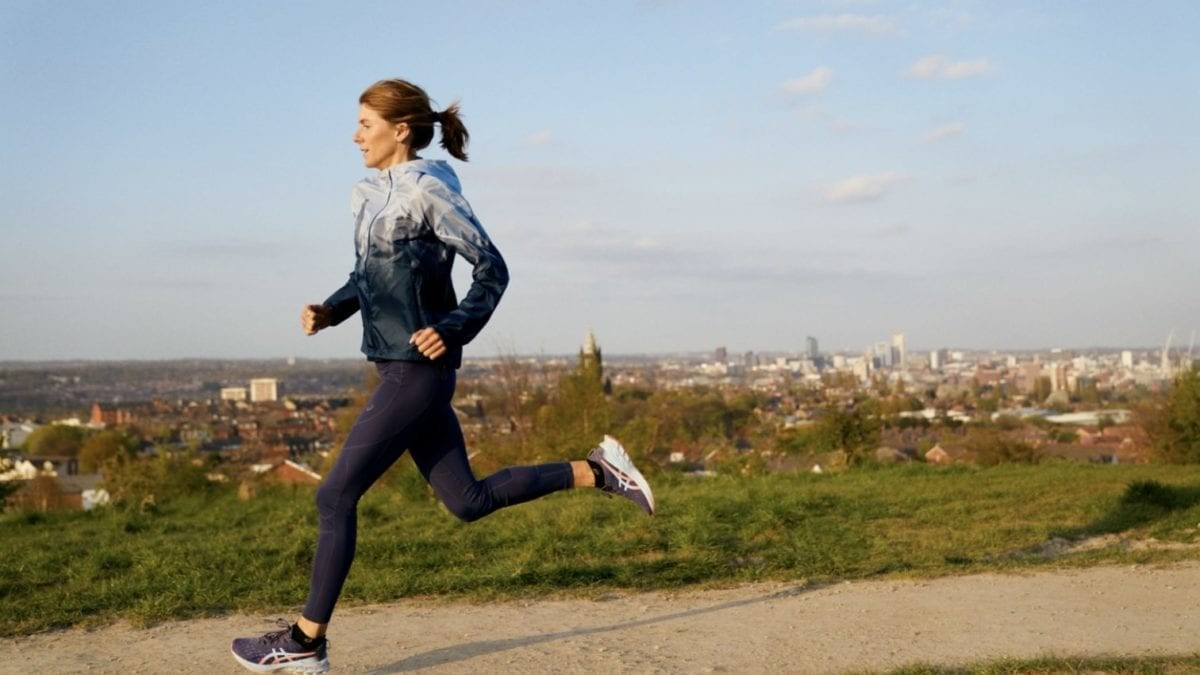
You then select the type of exercise you’re about to do (along with running, there are many other options), and you can head out to begin your workout. After your exercise, you return to the program, note how long you worked out, repeat the facial scan and answer the same questions as before.
Once complete, you will see “Your Mind Uplift,” which is an interactive and colorful cloud-looking graphic that illustrates your current mental state. You can compare that to your mental state before the workout, and the individual categories will be listed, showing how your mindset differed before and after you exercised.
The final stop on the program webpage is the World Uplift Map, which is not yet ready to view. By July 1, the team at ASICS hopes to release the map, which will be populated by the Mind Uplifts of people across the globe. Once it’s ready, you will not only be able to see how exercise affects people worldwide, but also specifically how it impacts people in your country and even in your city.
Exercise on the mind
As the team at ASICS notes (and as any runner knows), even a short 20 minutes of exercise can work wonders for your mind. In their preliminary research, the ASICS team looked at the effect of running for just 20 minutes, and the results were staggering. Researchers found that participants experienced a 13 percent increase in alertness, a close to 16 percent jump in calmness and that they were 14 percent more content and 13 percent more relaxed after their runs.
On average, those studied saw their overall cognitive scores (which are determined by the Mind Uplifter questions) jump by a whopping 17 percent, while their emotional scores (which are noted by the facial scan) rose by 12 percent. That’s after just 20 minutes of working out and in just one sport. Opening up the Mind Uplifter to athletes around the world will give ASICS – and exercisers – the chance to see how specific sports can affect the mind differently, and how the duration of exercise could impact one’s brain.
Mind Uplifter participation
To spread awareness of the Mind Uplifter, ASICS is asking participants to share their results on social media. The company is also offering a virtual event called the World Uplifting Minds Run, which will be open until June 30. This is a free event, and anyone interested can run or walk 5K or 10K and track it on the ASICS Runkeeper app.
In addition to the World Uplifting Minds Run, ASICS has said it will host a number of other sporting events over the course of the rest of the year to “encourage wider participation and demonstrate the power of all sports to uplift the mind.”
(06/05/2021) ⚡AMP
by Ben Snider-McGrath
Scottish middle-distance runner Josh Kerr runs fastest-ever 1,500m on U.S. soil at Stumptown Twilight
The Stumptown Twilight meet in Portland, Oregon on Thursday night saw several stellar performances, but it was Scottish middle-distance runner Josh Kerr who stole the show. The 23-year-old won the men’s 1,500m, blowing away the field by more than four seconds and crossing the line in 3:31.55. His time breaks the previous American soil record of 3:32.34, set by Rashid Ramzi of Bahrain in 2006.
His result is also the fastest time in Europe this season, and is the second-fastest 1,500m time this year in the world behind Kenya’s Timothy Cheruiyot, who ran 3:30.48 in Doha on May 28. This is a new personal best for Kerr, who set his previous PB of 3:32.52 at World’s in Doha in 2019, where he placed 6th overall.
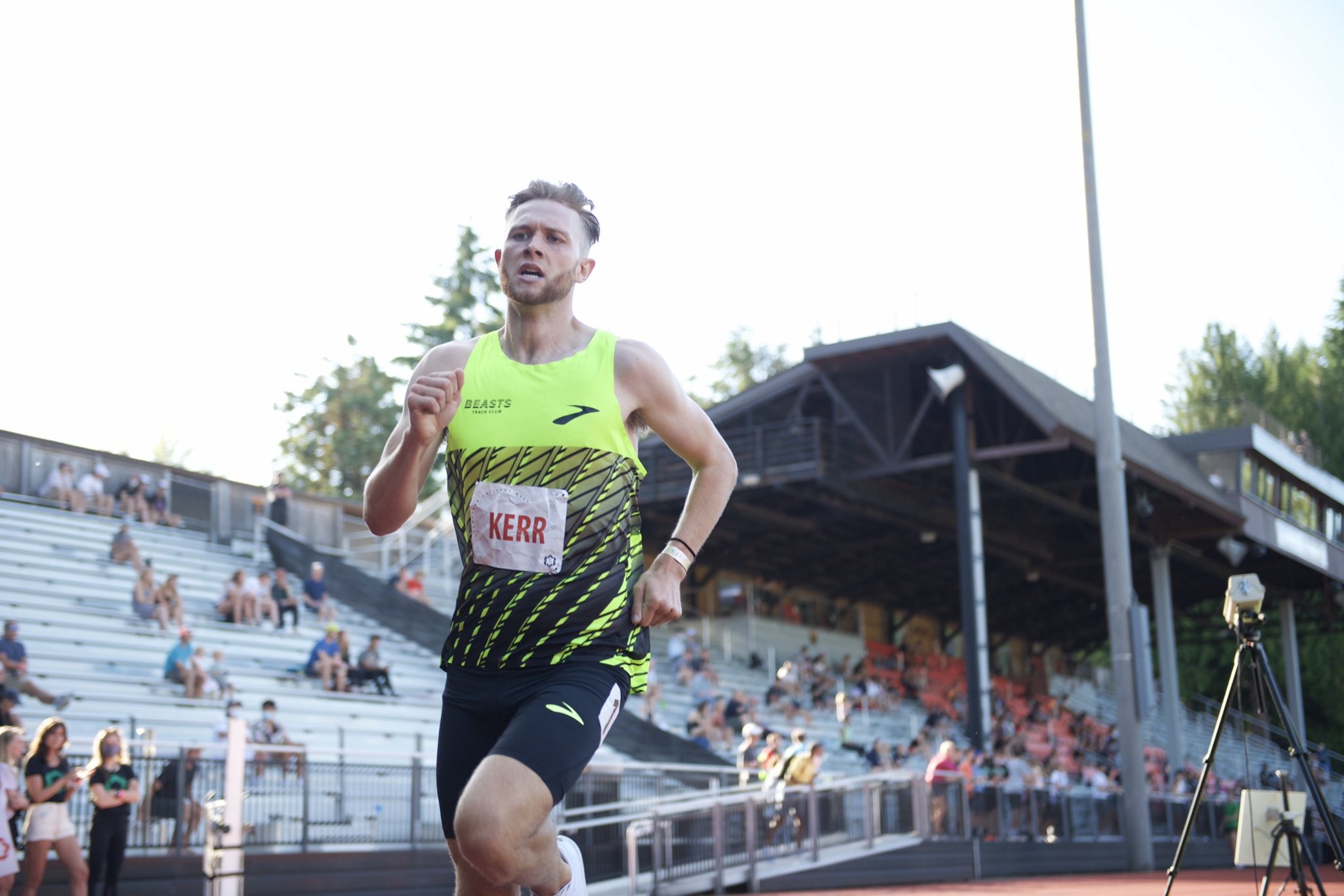
While Kerr originally hails from Edinburgh, Scotland, he competed for the University of New Mexico Lobos, where he set the men’s 1,500m NCAA record of 3:35.01 in 2017 (his record has since been broken by Notre Dame runner Yared Nuguse). The Olympic standard in the men’s 1,500m is 3:35.00, and considering he is currently the fastest athlete in Europe at the distance, Kerr has likely solidified his spot on Great Britain’s team headed to Tokyo this summer.
(06/04/2021) ⚡AMPby Brittany Hambleton
Why the first 10 minutes of running can be the worse for everyone
Ask anyone what the worse bit of their run is and chances are they will say the first 10 minutes or so. We all know it. That feeling of having your worst enemy on your shoulder, cruelly whispering ‘you can’t do this’: your breathing is all over the place and you wonder if indeed you did lace into concrete shoes instead of trainers.
Whilst we might not get as far as loving it, there are lots of things we can do to make it better. Why does it happen: Basically, all those physical and mental responses we get early on in any run, are our body’s way of saying, ‘what the hell are you asking me to do! You have got to be joking! when you ask it to go from ‘I’m very happy just existing’ to running.
To use the analogy of the car, you are asking your body to go from cold start, it’s not been used for a while, to 5th gear and speeding along the motorway without making any gear changes. A little bit of very simplified background…. (feel free to skip this and go straight to ‘what to do’) Our bodies are fuelled by various different energy systems, some which require oxygen (aerobic) and others that don’t (anaerobic) and whilst they operate in parallel, each is suited to a particular intensity of effort.
At the very top of the spectrum is the ‘Usain Bolt’ intensity, fuelled by a system which only lasts for around 10 seconds. It is no coincidence that the 100 m record is around this time. When it runs out, sprinters are relying on slowing down the least, rather than running faster. Very few of us will ever take part in a 100m sprint but this same energy system is present when we set off on those first few steps of a run, in fact when we go from resting to any activity. When this ‘B of the Bang’ source diminishes we switch to an energy system which uses stored glucose/glycogen but still doesn’t need oxygen and lasts for around 60 – 120 seconds.
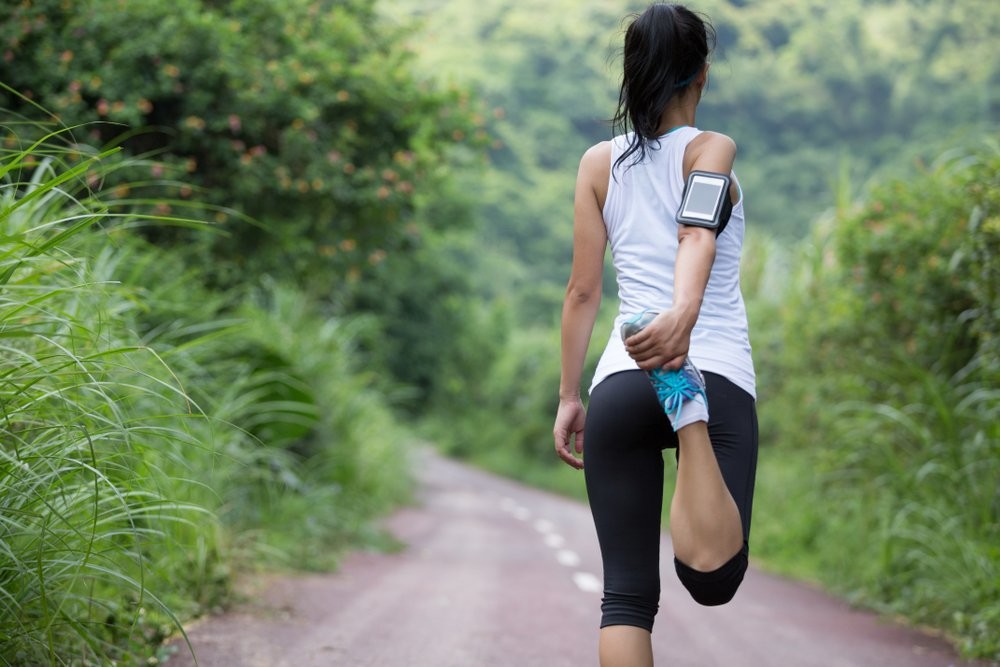
A by product of this is lactic acid: the stuff which makes our legs feel heavy, gives us shortness of breath (recognise any of these?). Beyond this we are left with the work horse, the aerobic energy system, which uses oxygen, carbohydrates, fats and proteins to create energy and if nurtured can go on indefinitely. So when we set off on that run our bodies use up the first 2 sources of energy in the first few minutes and then are left rapidly adjusting to use the 3rd. Pretty clever really. What we need to do is learn how to ease the transition.
What can you do to make it better WARM UP Getting your body and head ready for running is not a bolt on, nice to have. It does what it says on the tin and gets our heart, muscles and lungs ready and prepped for running.
Going back to the energy systems, warming up means we have already acclimatised the body to needing more oxygen and so it doesn’t spend the first few minutes bringing in huge lungs fulls and feeling generally pants. The warmer your joints and muscles are before your start the less effort and therefore the less energy, oxygen they need when you get going running.
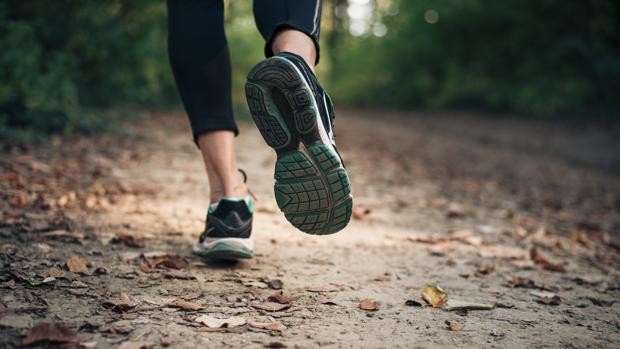
START OFF SLOW Even with a good warm up it pays to start off at a slower pace and work up to the effort you want to be putting in for the majority of the run. And I use the term ‘effort’ deliberately, as using the less techy RPE (Rate of Perceived Effort) to gauge your run is far more effective and easier than heart rate or pace. Aim for a ‘chatty’ kind of running: you can pretty much hold a conversation rather than feeling really out of breath. If 1 is sitting down watching TV and 10 is maximum effort, you feel sick, then aim for around 4-6. Even though it may feel super slow, this level of effort produces the best results in terms of your overall fitness. You will speed up as you get fitter but your effort levels will feel the same. It is very common for runners and in particular new runners to start off too fast and then come unstuck.
​DISTRACTION Listen to music, podcast and give your brain something else to tune into for the first few km or minutes. Alternatively run somewhere that keeps your eyes and brain occupied. FUEL Make sure you eat and drink regularly during the week. Those 10 minutes are a lot worse when you are dehydrated.
BREATHE Sounds obvious but take notice of your breathing. If it is short and shallow, try and focus on a calm, controlled out breathe and the in will follow. The more oxygen you take in the quicker the energy systems adapt. If after a few minutes you can't get it under control, then you are going too fast, slow down. You can do all these things but there will be times when the first 10 minutes really suck and so there is something about training your brain to tough it out and ignore the 'Stop!' voice in your head. Telling yourself that you know what is going on and that it will get better is a simple but useful technique. Kind of a, 'I have been here before and I have overcome it' type conversation with yourself. But equally importantly is listening to your body, stopping running and saving it for another day.So whilst you may never learn to love the first 10 minutes, there is plenty you can do to make the most of them.
(06/04/2021) ⚡AMPby Run Surrey Hills
Doping-Olympic champion Brianna McNeal banned for five years, CAS to hear appeal before Tokyo Games
American Olympic 100 meters hurdles champion Brianna McNeal has been banned for five years for an anti-doping rule violation (ADRV), the Athletics Integrity Unit (AIU) said on Friday, with her participation in the Tokyo Games in doubt until her appeal is heard.
McNeal, who had been charged and provisionally suspended for "tampering within the results management process" in January, was sanctioned by a Disciplinary Tribunal as it was her second violation of World Athletics' anti-doping rules.
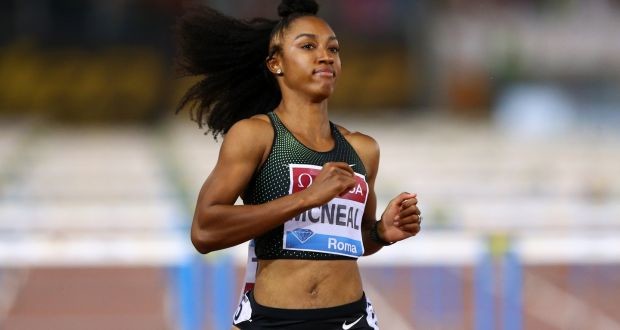
The ban is effective from Aug. 15, 2020. The AIU said McNeal has appealed against the decision to the Court of Arbitration for Sport (CAS), with the case set to be heard before the July 23-Aug. 8 Tokyo Olympics.
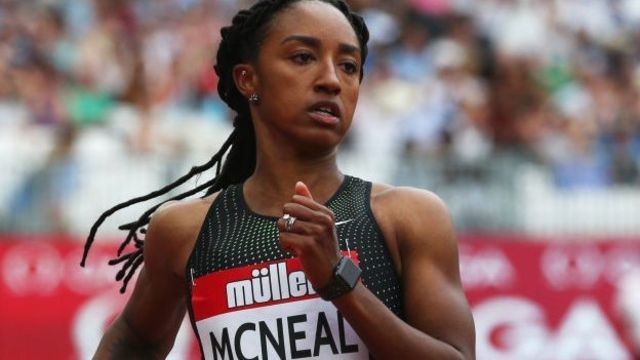
The AIU added that CAS had granted McNeal "provisional relief and temporarily stayed" the tribunal's decision so she can compete until the end of the U.S. Olympic trials on June 27.
The AIU did not elaborate on its decision for "confidentiality reasons".
McNeal, who won gold at the 2016 Rio Olympics and was world champion in 2013, had denied testing positive for any banned substance.
The 29-year-old led a U.S. clean sweep of the 100m hurdles podium at the 2016 Olympics but was banned for a year when she missed three out-of-competition drug tests, which constitutes an ADRV.
Her ban, which was applied for the 2017 season, resulted in her missing the World Championships that year.
(06/04/2021) ⚡AMPby Toby Davis
Tokyo 2020 Olympic Games
Fifty-six years after having organized the Olympic Games, the Japanese capital will be hosting a Summer edition for the second time, originally scheduled from July 24 to August 9, 2020, the games were postponed due to coronavirus outbreak, the postponed Tokyo Olympics will be held from July 23 to August 8 in 2021, according to the International Olympic Committee decision. ...
more...World record-holders ready to clash in Hengelo
Five world champions, four Olympic gold medallists and two world record-holders are set to compete at the FBK Games – a World Athletics Continental Tour Gold meeting – in Hengelo on Sunday (6).
Pole vault world record-holder Mondo Duplantis will be raring to go after his 23-meet winning streak came to an end at the Wanda Diamond League meeting in Gateshead at the end of last month. Battling tough conditions, the 21-year-old from Sweden gave the bar a slight nudge on his final attempt at 5.80m – what would have been a winning height – and it came down, meaning victory went to two-time world champion Sam Kendricks.
Kendricks won’t be in Hengelo, but Duplantis will have one eye on the US vaulter’s meeting record and Dutch all-comers’ record of 5.91m.
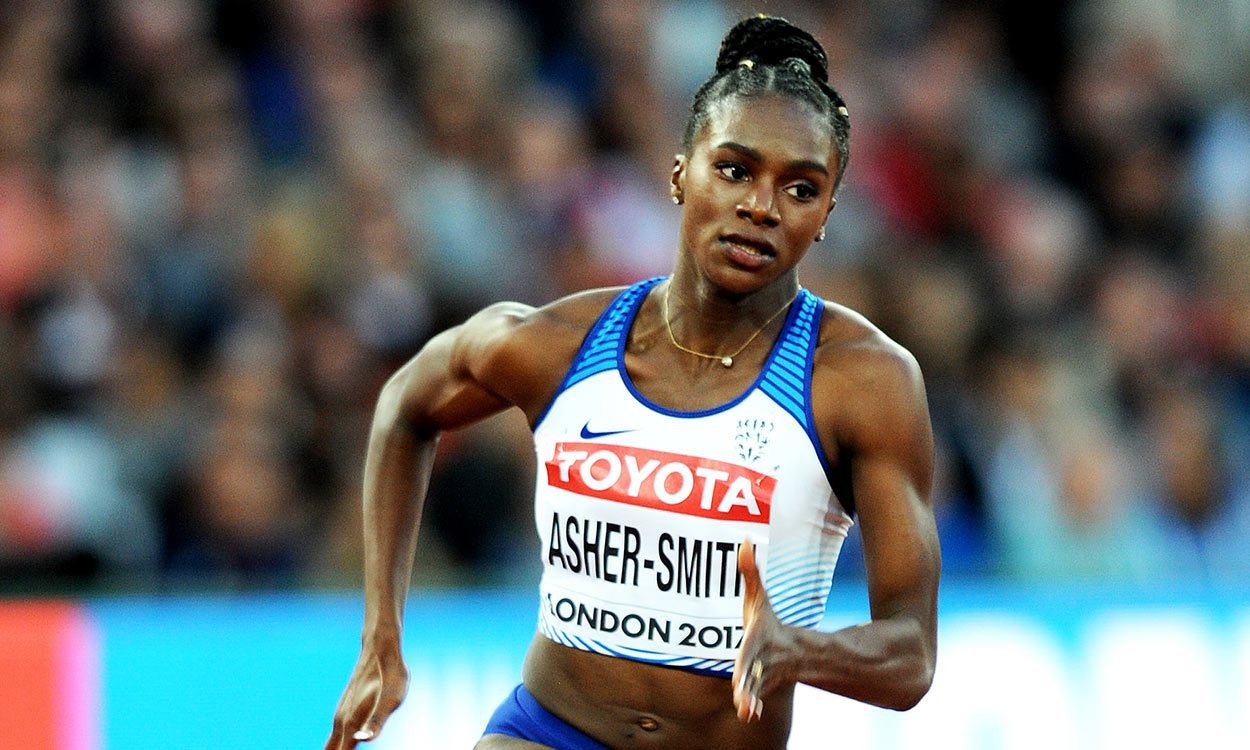
Olympic champion Thiago Braz and Dutch vaulter Menno Vloon, who set a national indoor record of 5.96m earlier this year, are also in the line-up.
Double world champion Sifan Hassan will return to the track on which she set a European 10,000m record of 29:36.67 last year and will again contest the 25-lap discpline. The Dutch distance runner has tested her form over a range of distances this year, clocking 8:33.62 for 3000m indoors, followed by 14:35.34 for 5000m and 2:01.54 for 800m outdoors.
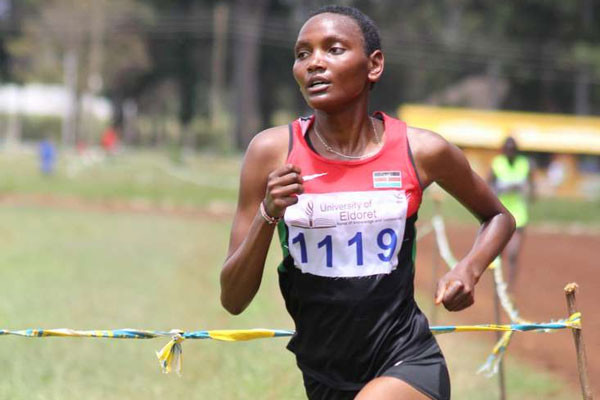
Kenya’s Daisy Cherotich, New Zealand’s world finalist Camille Buscomb and Canada’s Andrea Seccafien will all be hoping to emerge from the race with lifetime bests.
World 800m champion Halimah Nakaayi will open her 2021 campaign over her specialist distance. The Ugandan middle-distance runner takes on a quartet of Britons – Laura Muir, Kelly Hodgkinson, Jemma Reekie and Adelle Tracey – as well as Norway’s Hedda Hynne and France’s Renelle Lamote.
In the men’s event, indoor sensation Elliot Giles lines up for his first outdoor 800m of the year, taking on fellow Brits Max Burgin – who set a European U20 record of 1:44.14 in Ostrava last month – and Daniel Rowden. Tony van Diepen, one of the Netherlands’ top performers at the World Athletics Relays Silesia 21, is also in the field.
Recent Montreuil winner Abel Kipsang goes in the men’s 1500m where he’ll take on Uganda’s Ronald Musagala and Britain’s sub-3:30 performer Jake Wightman.
Asher-Smith, Kerley and McLeod set to produce sprint highlights
Although she has raced there only once before, world 200m champion Dina Asher-Smith has fond memories of racing in Hengelo.
It is where, as a teenager back in 2015, she set her first senior national record over 100m, clocking 11.02. Six years on from that performance, and having bagged many more records and medals, the world 200m champion will be hoping for a sub-11-second clocking to improve on the 11.35 season’s best she recorded when winning in Gateshead, running in heavy rain and into a -3.1m/s headwind.
Nigeria’s world and Olympic medallist Blessing Okagbare, who has a season’s best of 10.90, and two-time world 200m champion Dafne Schippers are also in the line-up.
World 4x400m champion Fred Kerley has so far this year produced his most impressive performances at 100m, clocking 9.91 and 9.96 in recent weeks. In Hengelo, however, he’ll step back up to his specialist 400m discipline and will aim to improve on the 44.60 season’s best he recorded in Doha last week.
(06/04/2021) ⚡AMPby World Athletics
Introducing the Country’s Fastest High Schooler
Hobbs Kessler is taking the running world by storm
Last February, Hobbs Kessler, a 17-year-old senior from Michigan who has committed to run for the University of Northern Arizona next fall, set a new high school record for the indoor mile. His time of 3:57.66 made him only the twelfth American high schooler to break the four-minute barrier since Jim Ryun first did it in 1964. The feat was all the more notable considering that Kessler’s mile PB coming into the race was a comparatively modest 4:08.4, which he ran last summer. As Track and Field News noted, Kessler’s record had come “seemingly out of nowhere.”
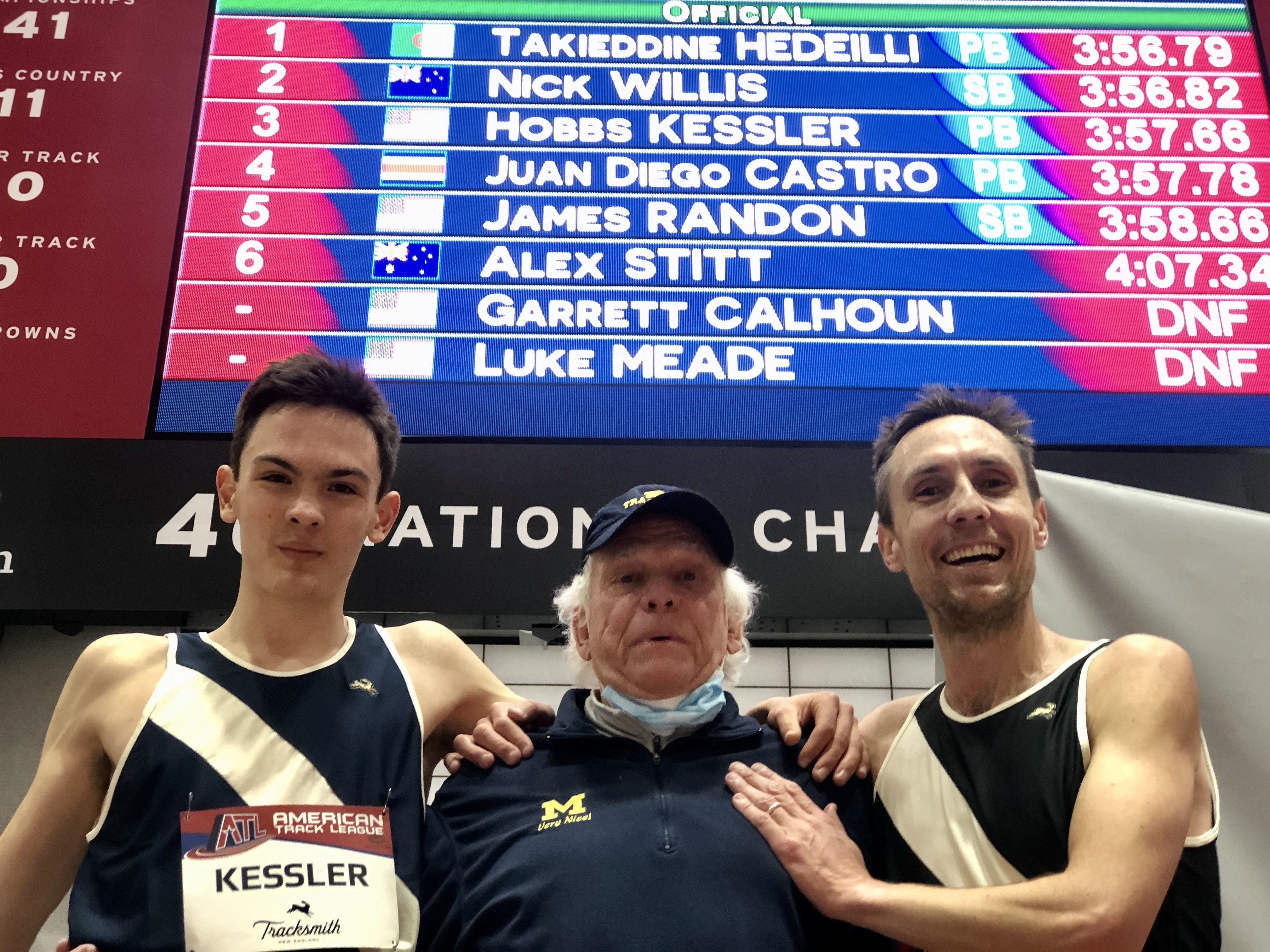
One explanation for Kessler’s sudden arrival into the upper ranks of American middle-distance running is that the pandemic has caused a number of rising stars to train in relative obscurity, with far fewer official meets to document the gradual progression of their talent. (Apparently, Kessler’s 4:08 mile last year was set in a time trial.) No wonder, then, that after his record-breaking run in February, the narrative around Kessler quickly morphed from Who is this guy? to What else is he capable of?
At last weekend’s Portland Track Festival, we found out. In the men’s 1,500-meters, Kessler, now 18, ran 3:34.36 to break Alan Webb’s 20-year-old high school record in the “metric mile” by almost four seconds—an eternity in such a short race. What’s more, Kessler’s time was also quicker than the men’s collegiate 1,500-meter record (3:34.68) and faster than the current Olympic standard (3:35.00). The guy few people had heard of six months ago was suddenly on the shortlist for the greatest U.S. high school runner, ever.
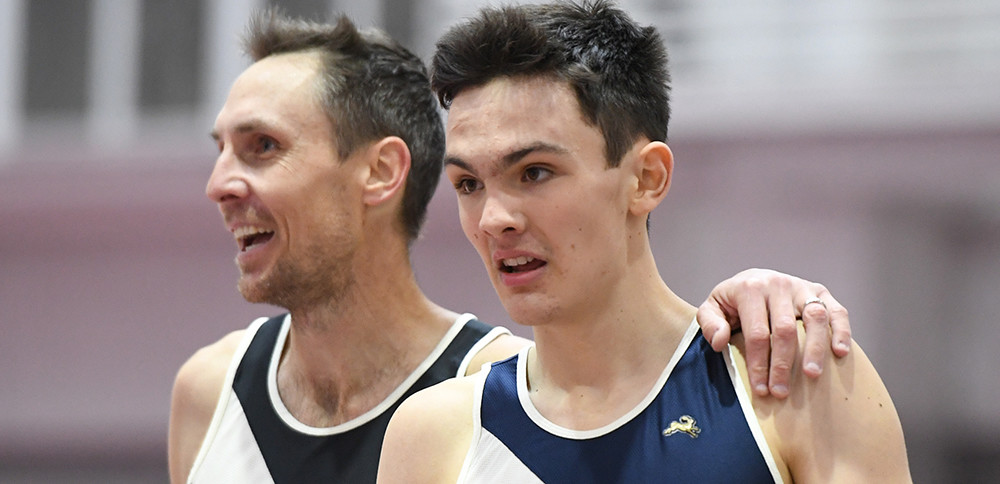
Until recently, track and field wasn’t even Kessler’s primary focus. In 2019, he represented the United States at the IFSC Climbing World Youth Championships. I caught up with Kessler to chat about the miraculous evolution of his young running career, choosing track over climbing, and his plans for the future.
OUTSIDE: Last summer, you cracked 4:10 in the mile for the first time. Less than a year later, you’ve run a 1,500 that converts to a 3:51. Are you shocked by how quickly you’ve progressed in such a short time? Can you still savor the moment?
KESSLER: In early 2020, I just wanted to run 4:13, indoors, in the mile. And then it kind of snowballed from there. I’ve gotten used to shifting my mindset on how I view myself as a runner. As I keep upping it, I always think, “OK, this is the last time,” but it hasn’t been so far. So, it’s been a little crazy in that regard, but I’m really enjoying it. I feel like I’ve been able to adapt my mindset really quickly—a lot faster than my folks. I think they’re still stuck six months back, which is pretty funny.
By “shift in mindset,” I’m guessing you mean a shift in expectations that you have for yourself. Are you worried that you might not be able to live up to your own standards, considering how quickly you’ve progressed?
I guess it can be a double-edged sword. In the winter, before I broke four for the first time, the 60-second-per-lap pace was everything, so that’s what we did all our workouts at. Now that I’m more fit, 57 is the new 60. But it’s all about not viewing it as fast. Because if I thought of 4:10 as fast, then I’d probably be running 4:10. So, you can control some of it with your mind. As far as not living up to expectations, I know that at some point I’m going to take a hit and not be running as well. But this season, I’ve been taking everything in stride and good things have been happening. I’ve never worried that I wasn’t going to run well.
There’s a theory that the bizarre circumstances of the pandemic might have helped some athletes nurture their talent by clearing their racing schedule. Is there any sense in which the events of last year changed your approach to training and racing?
As far as training goes, I would say the pandemic allowed me to just take a block from March 2020 to August to just get stronger. When the season got shut down, my dad switched me over to doing tempos on Tuesdays and hills on Fridays. But I was doing a lot of really fast strides because I wanted to develop my speed. Trying to work on my form. I’m a fairly fresh runner and haven’t been at it that long, so my running form is still very malleable. I didn’t have a race to worry about, so I just ran two big workouts a week and a big long run. I think people are realizing that racing less and training more can yield faster times. I’ve probably only gone all-out five times this year—but when I do decide to go all-out, I put a lot of emphasis on not wasting the opportunity.
I know that you are coached by your father, but also by Ron Warhurst—a legend in the coaching world, who is credited with “inventing” one of the sport’s most famous workouts. Do you have a favorite session that you like to do—perhaps something from Warhurst’s catalog of torture?
Both Ron and my dad have a lot of input in my training, but I’m more on Ron’s program now. I would say that my favorite workout of Ron’s has to be “Michigan,” because it’s his signature thing and you hit pretty much every pace and it can also be adjusted to wherever you’re at.
You’ve qualified for the Olympic Trials in the 1,500 as a high schooler. That’s nuts. But you’re also in a good spot in which there’s no pressure and where, presumably, you can just go and enjoy the experience. How do you plan to approach the Trials and do you have any other running goals for the summer?
After I broke four minutes in the mile, getting to the Trials was really the big goal. So I’m very excited about that race. Originally, I was just viewing it as a great experience where I could learn a lot so that, in three years, I might be in a position to compete for a spot on the team. But now that I’m one of the few people with the Olympic standard, my mindset has changed a bit. My thinking is that, if I’m there, I might as well have a run at the team. It’s a win-win because if I make the Olympic team that would be awesome, but if I don’t, I’m only 18 and will have a lot more attempts at it. I feel like I’m in a very cool spot where there’s no pressure, but I might as well give it a go.
You have an impressive climbing background, but it seems like you’ve decided to prioritize running for now. Was that decision based primarily on the fact that running is where you have the most talent, or was it something else?
I’m definitely prioritizing running, but I wouldn’t say it’s a conscious decision. That’s just the sport that I’ve drifted more towards in the past year or two and it’s what I’m more excited about. It’s not that I decided that I could be more successful at it, so much as that I’ve drifted towards it throughout high school.
Do you feel like the two sports complement each other in some way?
I think climbing really helps running, but running doesn’t really help climbing.
How so?
Well, the big carryover from both—and this does go either way—is that the mental stuff is the same. Race nerves in running and redpoint jitters in climbing. So there it’s the same stuff. In competitive climbing, I had to develop skills to deal with it, which translated directly to my running. But I think running destroys my coordination a little bit for climbing, so it’s hard to do both at the same time. I tried to be really good at both at the same time, but it just wasn’t possible because they started fighting each other a little bit. So I decided to let go of trying to be really good at climbing and to just do it because I enjoy the act of it.
You’ve now run a time that is faster than the NCAA 1,500-meter record. Unsurprisingly, this has fueled speculation that you might decide to go pro and skip college-level racing altogether. Do you think that early success can obscure the fact that running talent still needs to develop gradually?
When I was talking to colleges that was one of the biggest criteria I had. I wanted to make sure they developed me and weren’t just trying to get as much out of me while I was in school. So I’ve kind of had that view. Running aside, if I were to go pro, it would have to create a situation that would be worth missing out on the experience of being in college and being on a team. And I really want that experience. I’m not ready to be done being on a cross-country team. So going pro would have to outweigh that by a significant amount. Everything seems really immediate and important right now, but I have confidence it will even out. Whatever decision I make, I have confidence in the people who have been guiding me so far.
(06/04/2021) ⚡AMPby Outside Online
How to Mentally Pull Through a Tough Moment
Whether training or racing, you’re going to hit some challenges. Here’s how to motor on.
You may not be back to racing quite yet, but you’re likely starting to train for a fall goal. Whether it’s your first time prepping for a race or your first time back at hard practice after a break, it’s time to train your mind as well as your body. As Under Armour coach Tom Brumlik will tell you, “The mind leads the body.” That means putting in the work to get your brain tuned up along with your body. Here’s how.
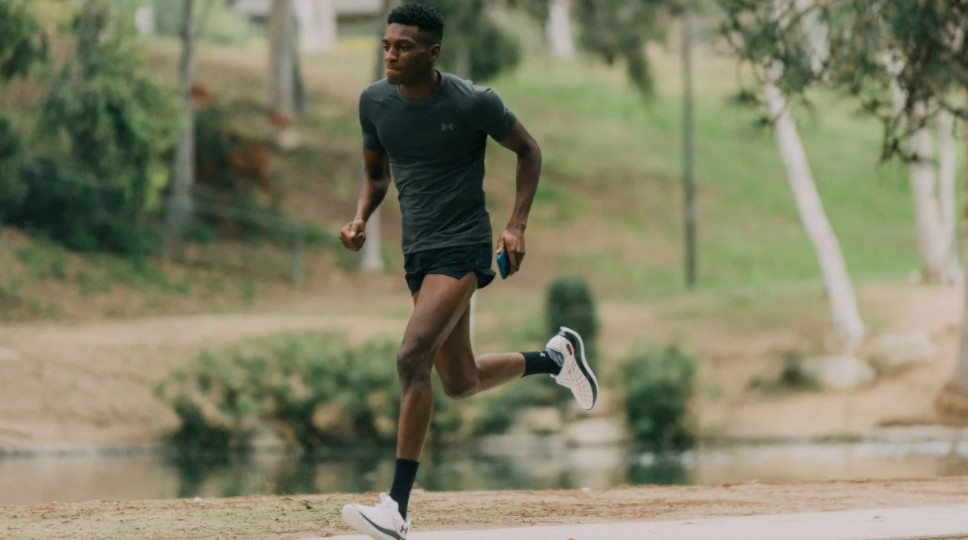
Tap into the Power of Affirmations
In order to set a baseline of positivity across all aspects of life, not just training, Brumlik recommends practicing positive self-talk. “I’m big on affirmations,” he says, short complete sentences you can state anytime. “I tell my athletes to practice ‘I am’ statements throughout the day, even when they’re not training or racing.” For instance, if you’re in the first stages of a giant project at work and feeling overwhelmed by how much of it lies ahead, tell yourself, “I am on my way.” When your alarm goes off at 0-dark-30 for a run, say, “I am a morning person.” Whatever the case may be, it’s the practice of “I am” statements that leads to the gains. “You can’t pull them out on race day alone,” says Brumlik. “The practice has to be ingrained.”
And Develop Some Mantras Too
In addition to finding some all-purpose affirmations that can apply to all facets of your life, you’ll also want to have some shorter, more running-specific mantras in your mental toolkit. Any training session or race can feel like a roller coaster, with highs and lows, twists and turns. One minute you’re feeling great, flying through the intervals, and the next you’re facing the biggest, steepest climb of your life. Knowing and embracing that fact—and having an automatic response—will help you push through.
Research shows that when you repeat a mantra whenever you hit a challenge, it can give you a mental and physical boost. The wording can be anything that reliably lifts your spirits. Think along the lines of “I am strong” or “I’ve got this,” for instance. Or repeat something that relates to the act of running, like “Swift and smooth,” “Light and fast,” or “I eat hills.” Other options include “Light it up” or “Go for it.” Whatever serves to motivate you, used on repeat, is what will get you through.
Focus on Your Breathing
You can put your breathing to use in a variety of racing and training scenarios. “I like to use breathing before a race or hard workout to calm my nerves,” says Brumlik. “You can also use it to relax and smooth things out during a race.” The quality of your breathing in the midst of a hard workout or race can also serve as a good indicator of your effort level. If you’re in the first mile of a race and find yourself breathing hard, it’s time to dial things back so you have something left for the end. “It’s very common to go out too hard, so pay attention to your breathing rate and breathe slowly and deeply to slow yourself down if needed,” Brumlik recommends. There are more than just physical upsides to using your breath as a barometer, as Brumlik suggests: in doing so, you're practicing mindfulness which can help you create focus, foster calmness, and, most importantly, reinforce that you are in control of your run.
Count Your Steps
If you find yourself in the pain cave during a workout, mentally settle into your cadence to take your mind away from the challenge. Have a look at the MapMyRun app to find your perfect cadence and then focus on the rhythm of your feet. Before long, you’ll forget the pain and fall into an easier, more efficient stride. “Think about light, quick steps, which will help your mechanics,” says Brumlik. “Think about driving your arms back and your foot straight down to get the most out of your stride.” Building mental skills is all about developing a positive mindset, says Brumlik. “Running can be a challenging sport,” he says. “Stay away from words like ‘I can’t’ and instead focus on positive practices until they become a habit.”
(06/04/2021) ⚡AMPby Outside Online
WHAT IS MINDFUL RUNNING — AND WHY YOU SHOULD GIVE IT A TRY
Is mindful running all about taking it easy and slow or can it actually help you run faster? Here’s what mindful running is along with a few reasons why you should give it a try.
With more technology than ever to track metrics, like heart rate, running power, lactate threshold, and VO2 max, it can be easy to slip into constantly eyeballing data during your runs.

Even if you do wait until after your runs to go over your data, a lot of runners choose other distractions like music, audio books, or even podcasts to get them through their workouts. While these things aren’t necessarily bad, one commonly neglected aspect of running is training the mind.
By taking a more mindful approach to running a few times per week (or even as part of a warm-up or cool-down), runners can improve mental conditioning that will in turn boost performance, recovery, and bring some of the joy back to the sport you love.
Let’s go with the flow and explore what mindful running is and why it’s beneficial for runners of all levels.
WHAT IS MINDFUL RUNNING?
The most basic definition of mindful running is to become mentally connected with your body during your runs.
While there are many different ways runners can practice this technique, the principal idea is to get rid of distractions while you run, concentrating on how you feel. Whether it’s looking at your metrics every minute, being overly concerned with how fast or far you have to go, or even thinking about that argument you had with a co-worker during a run, these things tend to take away from the mind-body connection and being in the moment.
Even though meditation and mindful running do have their differences, the two practices are often used together:
Meditation concentrates on removing the things in our life that cause stress or distraction in order to create calmness in the mind.
When you practice mindful running, you can use many of these same principles to not be distracted by things outside of your activity, focusing instead on embracing how you feel and being in tune with your body.
Being connected with your running often moves the focus towards things like your breathing, how your arms and legs are moving, or parts of the body that may be feeling tight or weak.
While some runners learn to ignore the pain or difficulty that running often inflicts, mindful running embraces everything going on within the body, from nutrition to how much sleep you’ve gotten the previous night, to create an awareness that puts you more in tune with your body.
CAN MINDFUL RUNNING HELP YOU RUN FASTER?
In the past, runners have typically focused on physiology and physical conditioning as a way to improve performance. Going further, adding intervals for speed, and doing strength training have become the common approaches, while mental conditioning is often an afterthought.
The problem is, always focusing on physical abilities without also training the mind can create a disconnect, causing negative thoughts and a higher perceived exertion when things aren’t going your way during an event.
While there have been limited studies on the subject in the past, Asics recently conducted an experiment with runners of varying ability levels to determine just how much running performance can be affected by psychological factors.
MINDFUL RUNNING EXPERIMENT PART 1
Participants were placed in a controlled environment (150-meter track, indoors) and asked to each run two separate 5Ks at different times.
During the first 5K, runners ran around a dark track with only a spotlight that allowed them to see a few feet ahead. There was no clear finish line, no music, and no metrics to monitor.
MINDFUL RUNNING EXPERIMENT PART 2
For the second 5K, participants were placed in a more race-like environment. There were lights, cheering fans, clocks, and gadgets to monitor metrics.
In the more psychologically difficult environment where runners were forced to focus only on their body, times were slower among experienced runners in the group by as much as 60 seconds, while less experienced runners slowed up to two minutes.
WHY PRACTICE MINDFUL RUNNING?
What the proponents of the blackout experiment actually show is that runners rely too much on outside factors during training and racing, and by training the mind regularly you can in fact improve performance.
When you think about it, it does make sense.
There will always be moments during a run when things get tough. It could be those times when you just can’t seem to maintain your pace, or that heavy feeling in your legs that suddenly becomes too difficult to ignore.
Maybe it’s that lonely spot on the course where there are no spectators, when none of the other participants are next to you, and the beeping on your watch isn’t enough to push you forward. This is the point when the psychological battle becomes bigger than the physical one, and if you haven’t spent enough time training the mind, it can be difficult to overcome.
One of the primary researchers of the Asics study, Professor Samuele Marcora of the University of Kent’s School of Sport and Exercise Sciences, had this to say about the experiment and overall importance of training the mind.
“We wanted to show the critical role the mind plays in athletic performance. The difference we saw between the experiment conditions in just one day is similar to the difference you would see after a four-week high intensity training program, so the mind shouldn’t be underestimated.”
FOR WHOM IS MINDFUL RUNNING USEFUL?
While practising the mind can certainly benefit those elite runners looking for an extra edge, mindful running can be useful for just about anyone.
Whether you’re completing a recovery run or are simply someone who uses running to relax and destress, practicing mindful running in order to better connect with the body can be a good way to achieve a balanced state of mind and find joy in your running.
Dr. Jo Corbett, another of the collaborators in the Asics blackout study, spoke about this connection.
“Despite the challenging conditions on the track, almost every runner said they felt a kind of euphoria at some point, which they referred to as ‘pure running.’ It shows the power of getting more in-tune with ourselves by occasionally shutting out the distractions.”
Whether it’s to be a happy runner or a faster one, mindful running is a technique worth practicing and including in your workout regimen. Just like strength training, yoga, or interval training, spending some time doing nothing but concentrating on the connection of body and mind will only make you a better runner.
(06/04/2021) ⚡AMPChina suspends all high-risk sports events after deadly mountain ultra-marathon
China has indefinitely suspended all ultra-marathons and trail-running events in the wake of a mountain race that saw 21 runners die in extreme weather last month.
The staggering death toll of the 100-kilometer (62-mile) ultra-marathon in Gansu province triggered a public outcry over lax industry standards and weak government regulation.
On Wednesday, China's General Administration of Sport said it is halting all high-risk sports events that lack a clear oversight body, established rules and safety standards, according to a statement on its website.
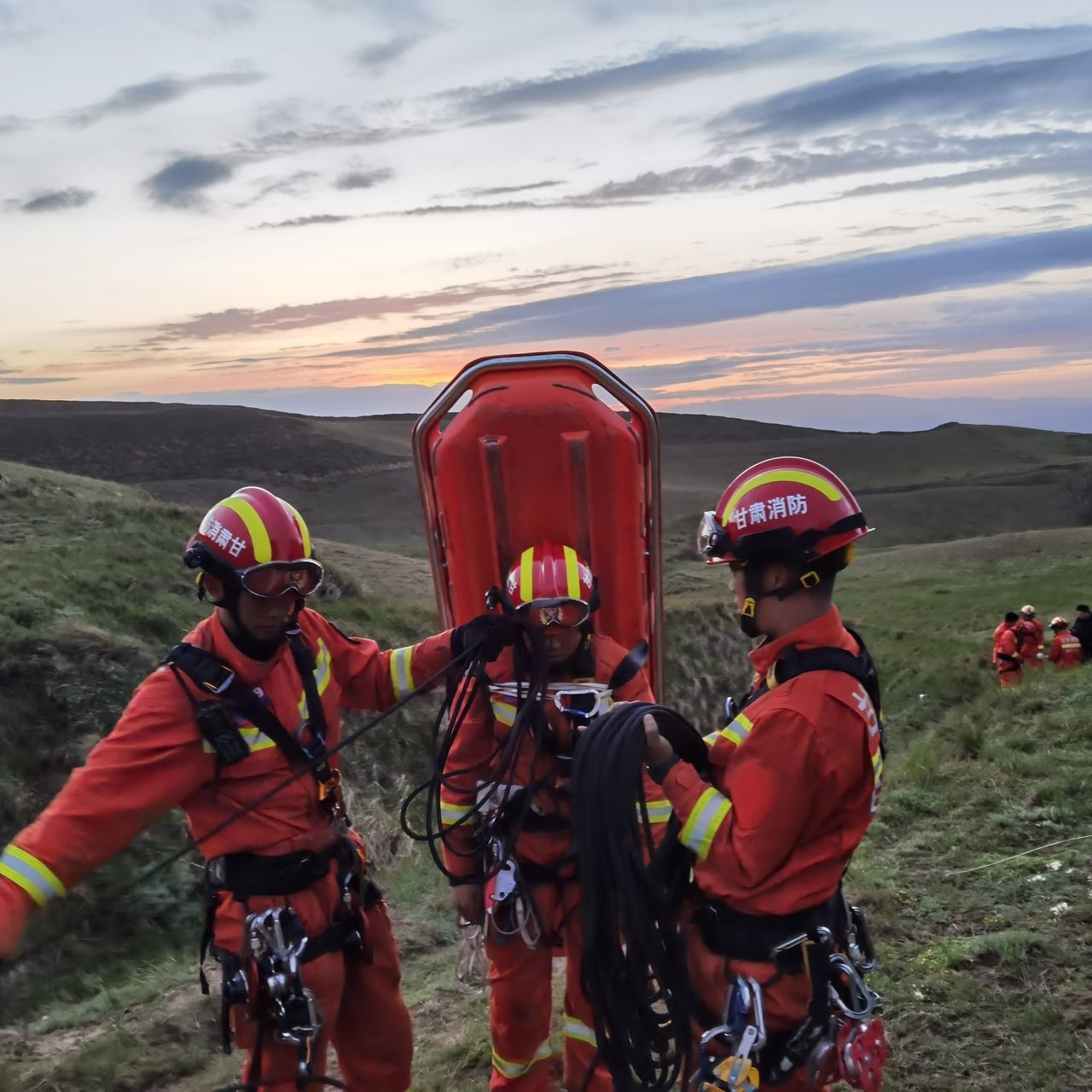
The sports suspended include mountain and desert trail running, wingsuit flying and ultra-long distance races, the statement said.
The administration did not specify how long the suspension would last, but said it is taking a detailed look into the country's sports events to improve regulatory systems, strengthen standards and rules, and enhance safety.

It also ordered local authorities "not to hold any sports competitions unless necessary" and call off any event with safety risks in the lead-up to the Chinese Communist Party's centenary, which falls on July 1.
Authorities didn't say how many races will be affected by the suspension. According to the Chinese Athletic Association, 481 trail races and 25 ultra-marathons were held in 2019 -- more than a quarter of all long-distance running events in the country.
Marathons and trail races have exploded in popularity as China's rising middle class picked up the running bug in recent years. But industry insiders say the races are often poorly organized, lacking safety measures and contingency planning -- and sometimes plagued by injuries and deaths.
Trail races are often held in far-flung parts of the country that lag behind in development and resources. The deadly mountain race on May 22 took place in the remote countryside of Gansu, one of the poorest regions in the country.
Most of the victims, including some of the country's best long-distance runners, were poorly equipped for cold weather and died of hypothermia -- a dangerous drop in body temperature caused by prolonged exposure to bitter cold.
The tragedy shocked China's running community and prompted public outrage, with many questioning whether organizers had planned the race properly or prepared participants for the extreme weather.
Even before the announcement on Thursday, dozens of marathons and trail-running races had been cancelled or postponed across the country in the past two weeks, according to state media.
(06/03/2021) ⚡AMPby Nectar Gan
2021 Royal Victoria Marathon eyes live return in October with half marathon, 8K
The first announced live in-person road race on the Island in more than a year and a half will take place Oct. 10 with an abbreviated version of the Royal Victoria Marathon.
The full marathon will not take place but half-marathon and 8K distances will be run. Instead of a water bottle half-empty, organizers say it’s a water bottle half-full for event-starved runners.
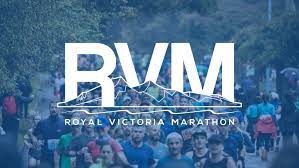
“Lots of people will be excited to lace-up their shoes and start training for their first in-person race for over 18 months,” said Jonathan Foweraker, president of the Victoria Marathon Society, in a statement.
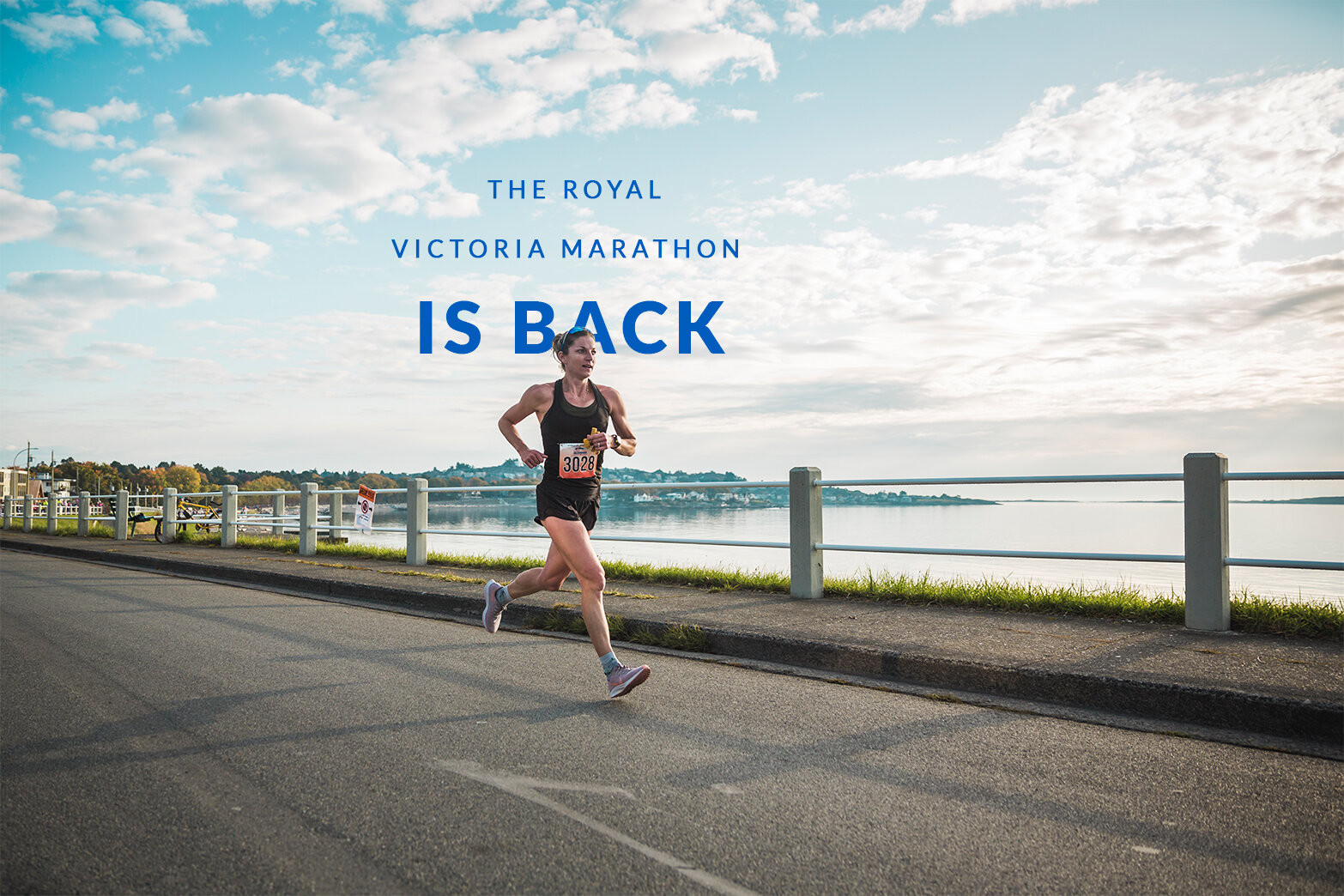
Race director Cathy Noel concurred: “It’s a great way to get back to a sense of normality in our community. Many of our enthusiastic volunteers are returning and will be cheering everyone throughout the race. We are very excited to return to an in-person race and know that runners will be equally thrilled to get to a start line and experience the excitement that builds prior to the gun going off.”
Despite the re-opening of sports, there are logistical reasons for not staging the full marathon distance, say the organizers.
“The marathon has traditionally attracted participants not only from Victoria and Vancouver but across Canada and abroad,” noted Foweraker.
“Not knowing exactly what travel will be like in the fall, we would prefer to stage the 41st Royal Victoria Marathon in 2022, when we can truly celebrate a return to running.”
Registration opens on Tuesday at runvictoriamarathon.com
(06/03/2021) ⚡AMPby Cleve Dheensaw
Royal Victoria Marathon
We are one of Canada's premier running event, offering athletes an unmatchable running experience on the pristine West Coast. Our world-class, record-breaking course is designed by runners, for runners. As the only Certified Boston Qualifier on Vancouver Island, come join us to compete, to conquer and to move from warm-up to reward. ...
more...Three former champions return to highlight 2021 Grandma's Marathon field
Kongin, Kiptoo, and Myers Could Join Prestigious Group of Repeat Winners at Duluth Race, former champions are expected to be on the starting line for the 2021 Grandma’s Marathon and will have the chance to join some very rare company if they can add another victory to their running resume.
Defending men’s champion Boniface Kongin is slated to return after outdueling the field in 2019, running a 2:11:56 to beat out four-time champion Elisha Barno and event record holder Dominic Ondoro. Kongin ran much of that 2019 race in record pace, but he was slowed in the final 10K as he dealt with severe cramping.
Not only will the Kenya native try to become the first back-to-back men’s winner at Grandma’s Marathon since Barno won the first two of his four titles in 2015-16, he would be just the seventh man to win multiple Grandma’s Marathons titles.
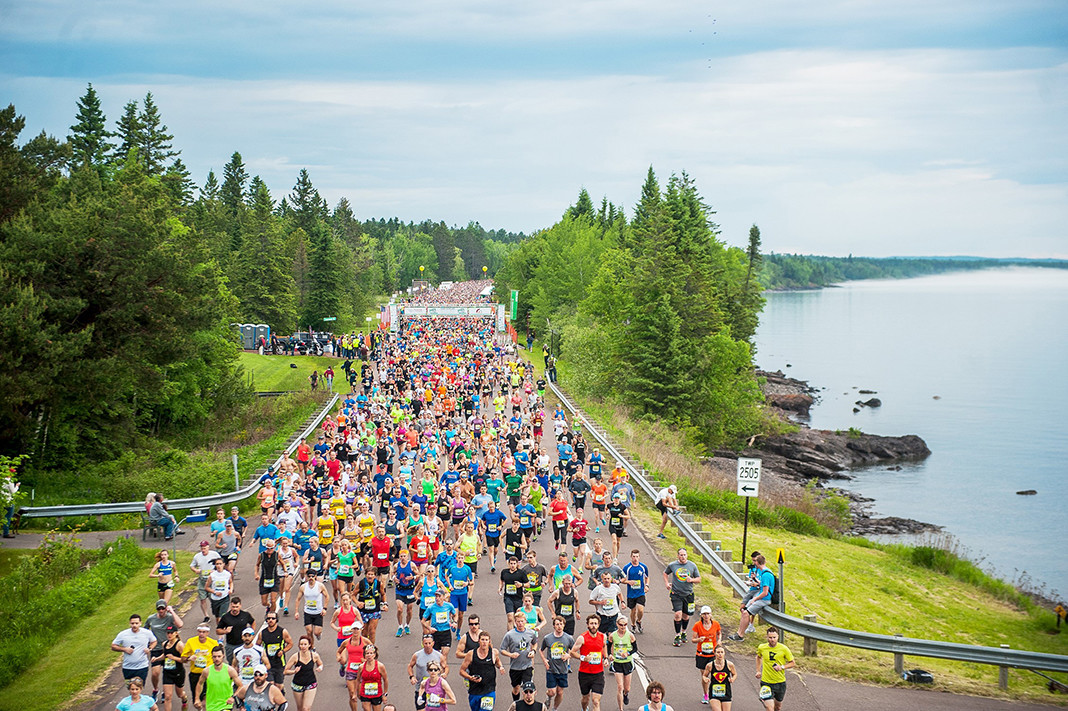
Sarah Kiptoo is also expected to return this year, and she will be trying to join Mary Akor (2007-09) and Lorraine Moller (1979-81) as the only three-time women’s winners of Grandma’s Marathon. The Kenya native won titles in 2013 and 2016 and also finished third in 2014 and 2015. She finished 10th the last time out on this course in 2019, finishing with a time of 2:38:46.
Kiptoo’s 2013 winning time of 2:26:32 was then an event record and only recently broken when Kellyn Taylor ran a 2:24:28 in 2018.

2014 champion Pasca Myers is also expected to compete in the women’s elite field, and she will be trying to become just the eighth woman to win at least two Grandma’s Marathon titles. She also ran here in 2019, finishing in eighth place with a time of 2:36:13.
With a reduced field for the 2021 Grandma’s Marathon, there are 29 men and 29 women expected to be in the elite field on Saturday, June. 19. The 45th annual Grandma’s Marathon is scheduled to start at 7:45 a.m. and can be followed live on our radio and TV partners, The Northland FAN 106.5 FM and WDIO-TV.
For more information, please call our office at (218) 727-0947 or visit grandmasmarathon.com.
(06/03/2021) ⚡AMPby Running USA
Grandmas Marathon
Grandma's Marathon began in 1977 when a group of local runners planned a scenic road race from Two Harbors to Duluth, Minnesota. There were just 150 participants that year, but organizers knew they had discovered something special. The marathon received its name from the Duluth-based group of famous Grandma's restaurants, its first major sponsor. The level of sponsorship with the...
more...2022 registration for Chevron Houston Marathon opens to all runners
Registration for the 2022 Houston Marathon Weekend of Events opens to all runners today, June 2.
The in-person race for the 50th Anniversary Celebration of the Chevron Houston Marathon and the 21st annual Aramco Houston Half Marathon will take place Sunday, Jan. 16, 2022. The We Are Houston 5K will take place on Saturday, Jan. 15, 2022.
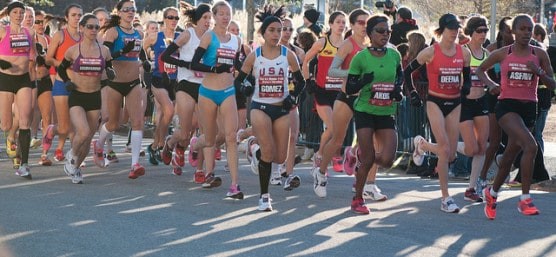
“Chevron is thrilled to be celebrating the 50th anniversary of the Houston Marathon alongside runners, volunteers, city officials and our own employees,” said Margaret Cooper, General Manager, Chevron Corporate Affairs, in a statement. “We look forward to seeing participants in January to commemorate this important milestone and the Chevron Houston Marathon’s incredible impact on our community.”
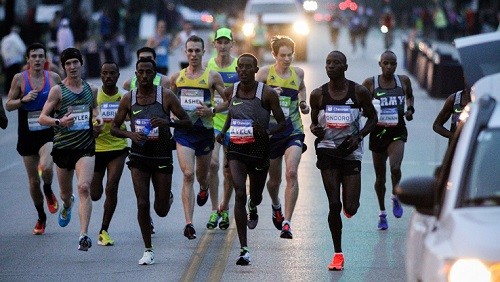
In addition to the in-person events, virtual registration options will also be offered at $75 for the marathon and $65 for the half marathon. Registration for the virtual events also open on June 2. The 2022 Virtual Houston Marathon Running Events will take place over race weekend Friday, Jan. 14 – Monday, Jan. 17.
“We are grateful for the continued support from our running community throughout the past year and look forward to safely welcoming back our runners to the road in Houston,” said Wade Morehead, Executive Director of the Houston Marathon Committee, in a statement.
“Through thoughtful planning alongside our city partners, we are confident that 2022 will be an event year that successfully celebrates the history and camaraderie of our runners, volunteers, race partners, and spectators - all who have made this event possible for the past 49 years.”
Additional details for the 2022 Houston Marathon can be found at chevronhoustonmarathon.com.
(06/02/2021) ⚡AMPby Briana Zamora-Nipper
Chevron Houston Marathon
The Chevron Houston Marathon offers participants a unique running experience in America's fourth largest city. The fast, flat, scenic single-loop course has been ranked as the "fastest winter marathon" and "second fastest marathon overall" by Ultimate Guide To Marathons. Additionally, with more than 200,000 spectators annually, the Chevron Houston Marathon enjoys tremendous crowd support. Established in 1972, the Houston Marathon...
more...Research reveals running boom during Covid-19 pandemic
More people have taken up running during the Covid-19 pandemic, and all of those intend to maintain their newfound passion for the sport once the pandemic is over.
The power of running during this time has been revealed on Global Running Day, with new findings from Nielsen – the official research and intelligence supplier to World Athletics – highlighting how runners have increased their participation and the health benefits they gain from it.
Across 10 surveyed countries, four in 10 people consider themselves to be runners and 30 per cent of those run at least once a week. Distinct from many other participation sports, recreational running has an equal participation split. Of all runners, 53% are men and 47% are women. More than a fifth of all runners reveal that they run more often than they did previously as a result of Covid-19 and most in that group say they will continue to run more often once the pandemic is over.
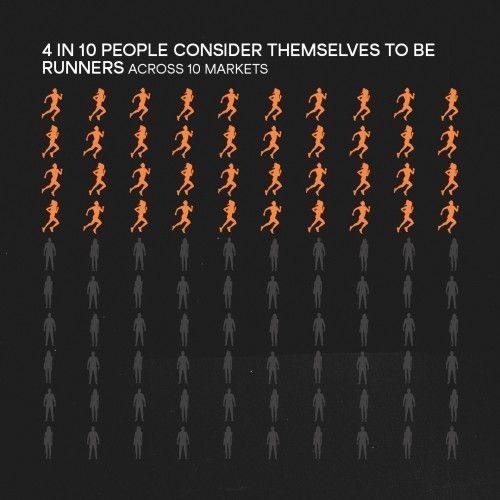
Among the many benefits of running is the chance to experience the ‘runner’s high’. “It begins with this peace of mind and then a greater ease of movement, a sense of power and confidence, optimism and hope, and you will often hear runners describe feeling loving and connected to everyone and everything,” explained Kelly McGonigal, a psychologist, educator and author of The Joy of Movement, during a recent World Athletics 'Run Anywhere' Webinar in collaboration with Mass Participation World.
The survey reflects this, with three quarters of all runners agreeing that ‘running is good for my mind as well as my body’.
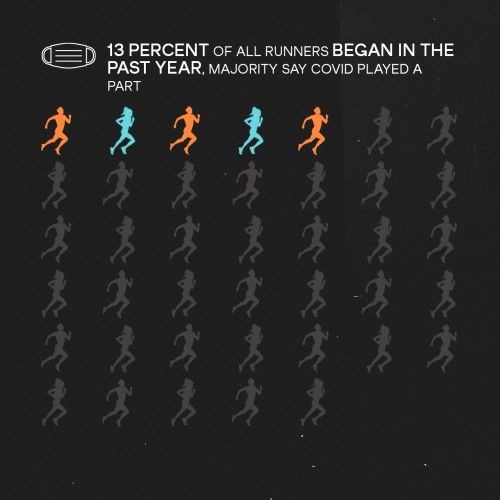
Those aged 25-34 are most likely to be passionate about running, with 50 per cent agreeing that it is a part of who they are. Runners are more likely to consider themselves to be warm and friendly, family oriented, optimistic and passionate, showing greater confidence to associate themselves with positive personality characteristics.
For current runners, the biggest factors in the decision to run are health reasons, the ability to go at your own pace and not needing much equipment. Recent research by runrepeat.com also identified the growing popularity of running, supporting the findings of the Nielsen study.So, what are you waiting for? Why not mark Global Running Day by discovering the power of running for yourself?Further findings are available in the World Athletics and Nielsen Sports 'Recreational running consumer research study'.
(06/02/2021) ⚡AMPby World Athletics
Beatrice Chebet from Kenya sets meet record in France
World Under-20 5,000m champion Beatrice Chebet continued to cement her status at senior level with a meet record victory in the women's 5,000m race at the Montreuil International Track and Field Meeting in France on Tuesday.
Chebet, who days earlier stormed to victory in Doha, won in Montreuil in 14 minutes and 52.06 seconds to edge out Kalimantan Gezahegne from Bahrain in 14:52.92.
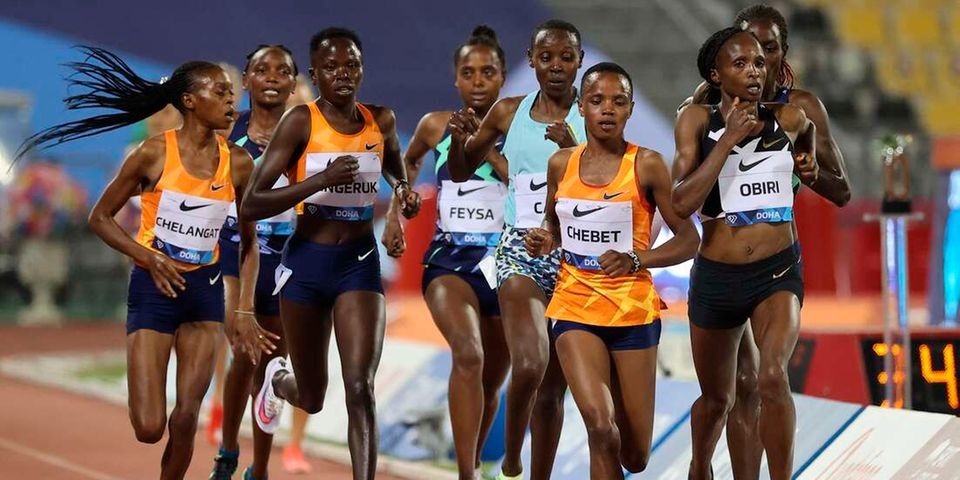
Chebet’s compatriot, former Africa 5,000m champion, Sheila Chepkirui settled for second place in 14:54.06, followed by Burundian Francine Nyonsaba, who ran within the Tokyo Olympics qualifying time and a personal best of 14:54.38.
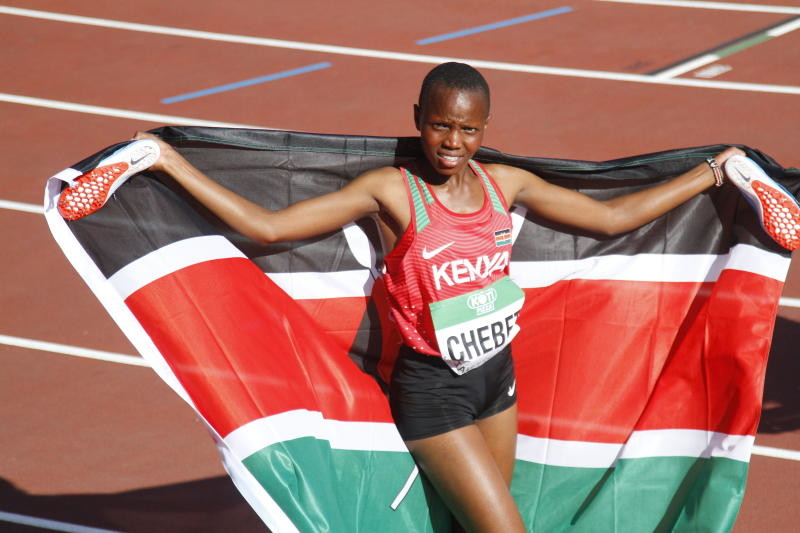
Chebet, who is also the reigning World Cross Country Under-20 champion, had on May 28 shocked a strong field that included defending champion Hellen Obiri, who is also the World 5,000m champion, to win the 3,000m race at the Doha Diamond League.
Chebet clocked a personal best and world lead of 8:27.49 for her maiden Diamond League victory.
Also to glide to a meet record victory at Montreuil was Abel Kipsang of Kenya, winning the men's 1,500m in a personal best of 3:33.99 after.
(06/02/2021) ⚡AMPby Ayumba Ayodi
Burundi's Francine Niyonsaba, who changed events due to testosterone rule, runs Olympic qualifier
She ran a time of 14 minutes 54.38, which is also a new national record, as she finished fourth in the race to easily better the Olympic qualifying time of 15:10.00.
It was just her second race over the distance having just missed out on the qualifying standard when she ran 15:12.08 at a meeting in Spain last month.
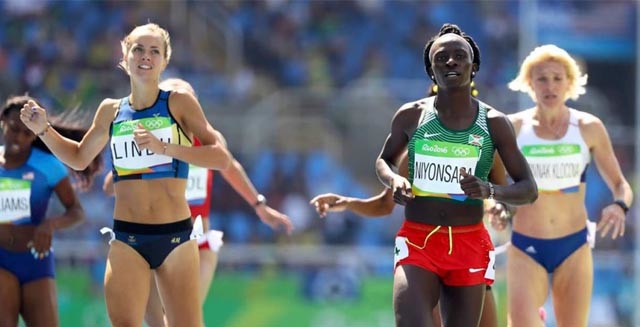
"A challenge is not a barrier. It's an opportunity to do better. Heading to Tokyo with a great qualifying time," she posted on Twitter.
The race was won by Kenya's Beatrice Chebet, who finished just over two seconds ahead of Niyonsaba.
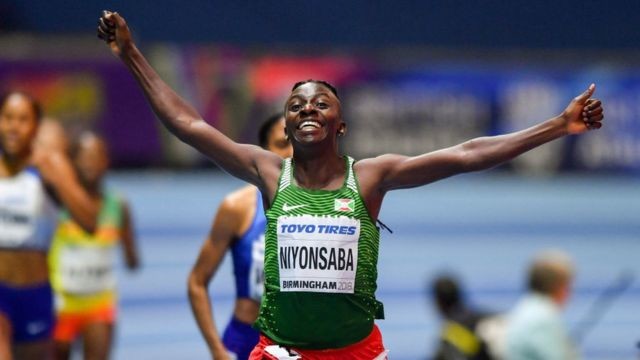
The 28-year-old, who won silver over 800m at the 2016 Games in Rio, has decided to move up to the long distance event rather than taking testosterone-reducing drugs.
Under the latest World Athletics regulations Niyonsaba is classified as having 'Differences of Sexual Development' - or 'DSD' - and so is not allowed to compete in events between 400m and a mile without taking testosterone-reducing drugs.
At the same meeting on the outskirts of Paris Burkina Faso's Hugues Fabrice Zango continued his good form with another win on the triple jump with a leap of 17.67 metres.
Ivory Coast's Marie Josee Ta Lou won the women's 100m in a time of 11.06 seconds just ahead of The Gambia's Gina Bass in 11.30.
Ta Lou's compatriot Arthur Cisse was victorious in the men's event clocking a time of 10.11 seconds.
Kenya's Abel Kipsang was the other African winner on the night in the men's 1500m as he finished ahead of compatriot Charles Simotwo, with Morocco's Brahim Kaazouzi in third place.
On Friday South Africa's Caster Semenya, Niyonsaba's great rival over 800m and another athlete classified as DSD, finished outside the qualifying mark for the 5,000m.
The 30-year-old finished in 15 minutes 32.15 seconds at meeting in Durban - 22.15secs outside the qualifying time.
It was her second bid to qualify for the 2020 Tokyo Olympics.
(06/02/2021) ⚡AMPby Sport Africa
Tokyo 2020 Olympic Games
Fifty-six years after having organized the Olympic Games, the Japanese capital will be hosting a Summer edition for the second time, originally scheduled from July 24 to August 9, 2020, the games were postponed due to coronavirus outbreak, the postponed Tokyo Olympics will be held from July 23 to August 8 in 2021, according to the International Olympic Committee decision. ...
more...Mo Farah is set to race at European 10,000m cup
The European 10,000m cup is taking place this Saturday, June 5 in Birmingham, U.K. According to European Athletics, 111 athletes from 26 countries will be competing, including an Athlete Refugee team in the men’s race. The highlight of the meet for track fans will be the return of Mo Farah, who will be running his first 10,000m since the 2017 World Athletics Championships in London.
38-year-old Farah will be aiming to hit the Olympic standard of 27:28 on Saturday, which shouldn’t be a problem for the 4-time Olympic gold medalist (twice in the 10,000m, twice in the 5,000m), whose PB at the distance is 26:46.57, set in 2011. He will be toeing the line with other strong British runners, including Marc Scott and Sam Atkin. Both men have already run Olympic qualifying times at the distance with 27:10.41 for Scott and 27:26.58 for Atkin, which should make for an exciting race.
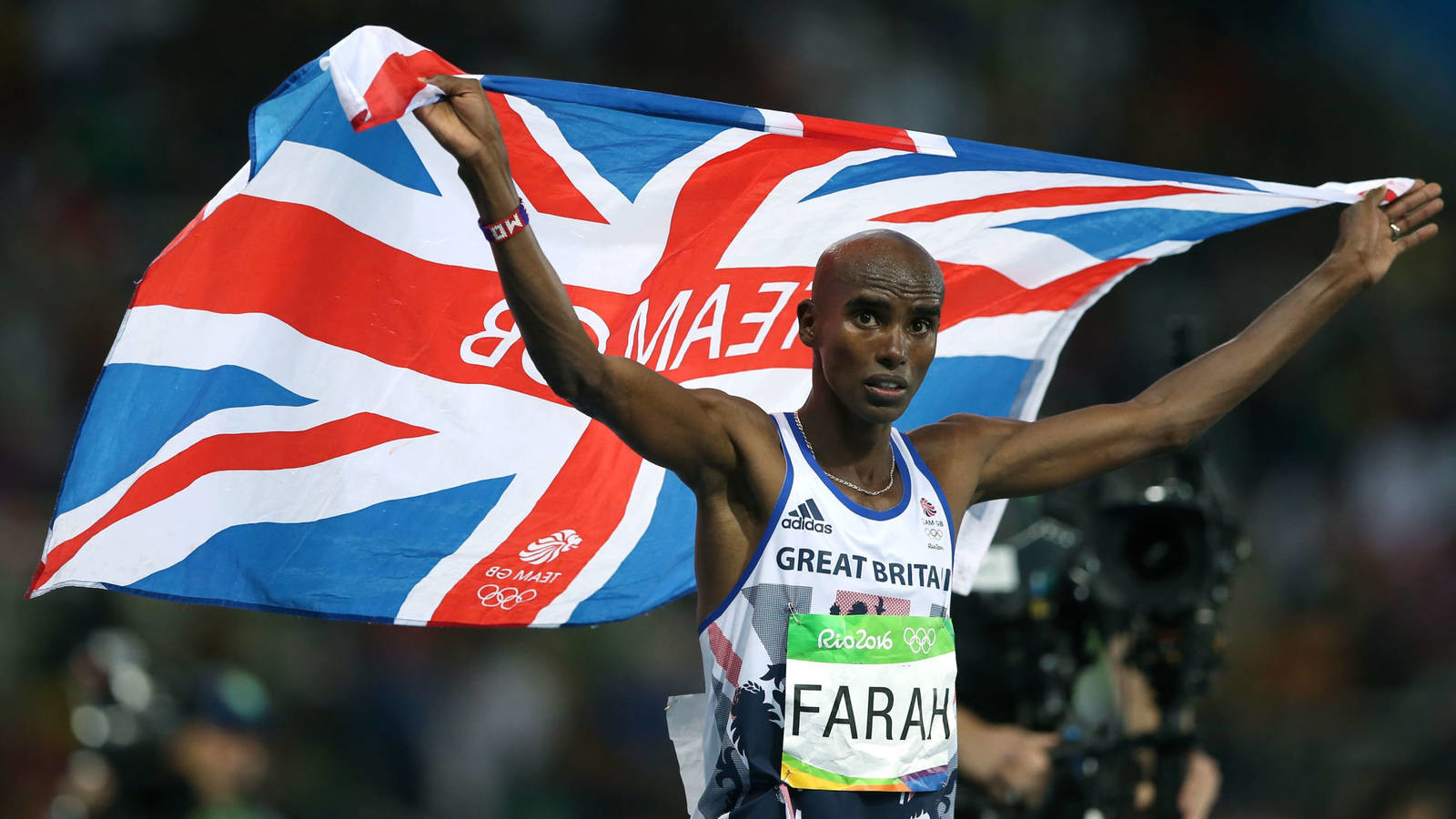
Other notable athletes set to compete in Birmingham include reigning European 10,000m champion Morhad Amdouni from France and European 10,000m silver medallist Bashir Abdi from Belgium. Abdi is one of Farah’s main training partners.
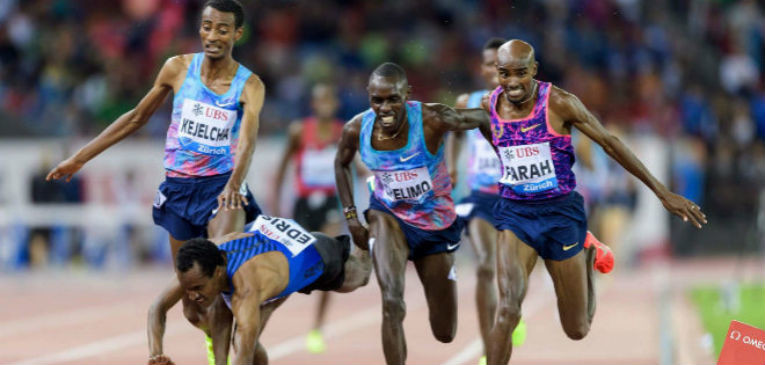
European 5000m silver medallist Eilish McColgan will be the fastest seed on the women’s side, with a recent personal best at the 10,000m of 30:58.94. Several other women are within striking distance of McColgan, however, and with many of them yet to hit the Olympic qualifying standard, we are likely to see some fast racing on Saturday.
(06/01/2021) ⚡AMPby Brittany Hambleton
17-year-old Erriyon Knighton breaks Bolt’s world U18 200m best with 20.11 in Jacksonville
After a string of 200m victories and some swift – albeit wind-assisted – times over 100m in the past two months, 17-year-old Erriyon Knighton finally entered the record books with his 20.11 200m win at the Duval County Challenge, a World Athletics Continental Tour Bronze meeting, in Jacksonville on Monday (31).
Knighton, who hails from Tampa in Florida, turned professional at the start of this year and has been mixing it with the world’s best during the outdoor season. He clocked a wind-assisted 9.99 over 100m in Clermont at the start of May and followed it with a 200m PB of 20.30 at the World Athletics Continental Tour Gold meeting at Mt SAC. More recently, he won the future stars 100m race at the Continental Tour Gold meeting in Boston, clocking 10.16.
In Jacksonville, however, Knighton made another step up in class, taking on some of the world’s biggest sprint stars.
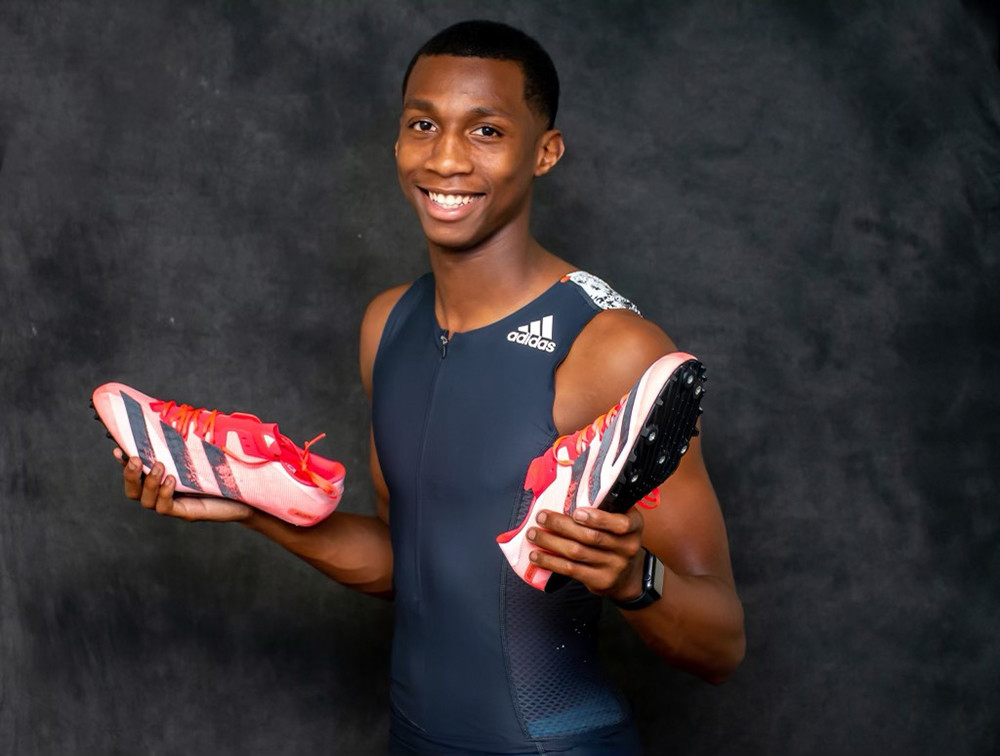
Drawn in lane three, Knighton got off to a solid start and trailed European champion Zharnel Hughes and 2016 world indoor 60m champion Trayvon Bromell as they entered the straight.
Bromell briefly edged in front while Hughes faded slightly, then Knighton held his form well to take the lead, crossing the line in 20.11 (1.6m/s) to take 0.02 from the world U18 best set by Usain Bolt back in 2003.
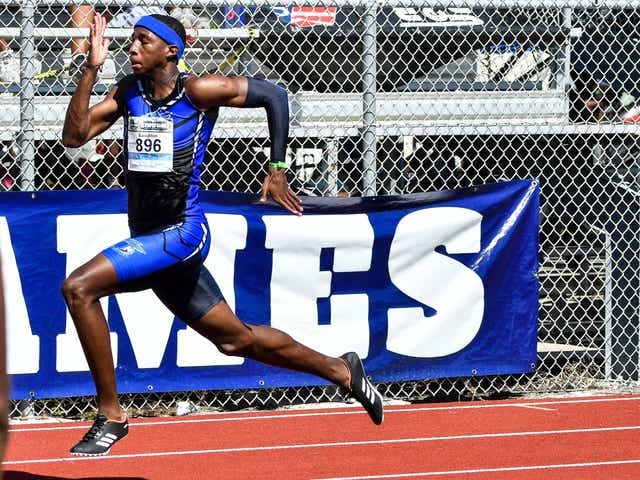
Bromell finished second in 20.20, his fastest time for five years, while Hughes was third in 20.30.
World silver medallist Brittany Brown won the women’s 200m in 22.43 (1.0m/s), beating Dezera Bryant (22.47) and Kyra Jefferson (22.63).
Shamier Little improved her own world-leading 400m hurdles mark by more than half a second, dominating the race to win in 53.12 – the second-fastest time of her career.
Jamaica’s Ronda Whyte was a distant second in 54.33. Dalilah Muhammad, competing in a separate heat, clocked 55.01 in what was her first hurdles race since breaking the world record to win the world title in 2019.
World champion Grant Holloway notched up another convincing 110m hurdles win, clocking 13.10 (1.1m/s) to finish ahead of Devon Allen (13.22) and Daniel Roberts (13.23).
Jamaica’s Brittany Anderson came out on top of a strong 100m hurdles field, winning in 12.59 (0.7m/s). World indoor silver medallist Christina Clemons was second in 12.64, just 0.01 ahead of 2015 world champion Danielle Williams.
Elsewhere, world U20 champion Brianna Williams won the women’s 100m in 10.98 (1.0m/s), from Mikiah Brisco (11.09). World indoor bronze medallist Ronnie Baker took the men’s race in 9.99 (1.3m/s) after clocking a wind-assisted 9.91 in the heats.
(06/01/2021) ⚡AMPby World Athletics
How does running strengthen your bones?
When it comes to running, the benefits for your body, mind, and soul are relatively endless. In essence, that’s why it’s one of the most popular sports in the world.
People of all ages, cultures, and walks of life enjoy it. Studies have linked running to everything from boosting your mood (that good-old “runner’s high!”), treating depression, enhancing brain health, increasing memory, reducing the risk of cardiovascular disease, lowering blood pressure and much more.
Another lesser-known benefit of running is that it helps build bone strength and mass. Plus, it can help slow the aging process related to bone loss (this is great for elderly exercisers).
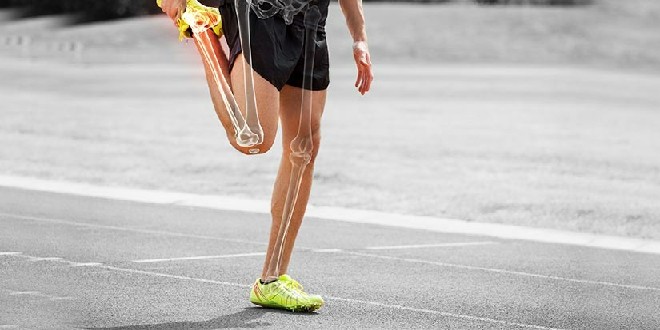
Wondering how? We’re here to explain. Aaptiv asked top running professionals to deep dive into the science of running and how it’s able to rebuild and strengthen our bones.
The Running and Bone Relationship
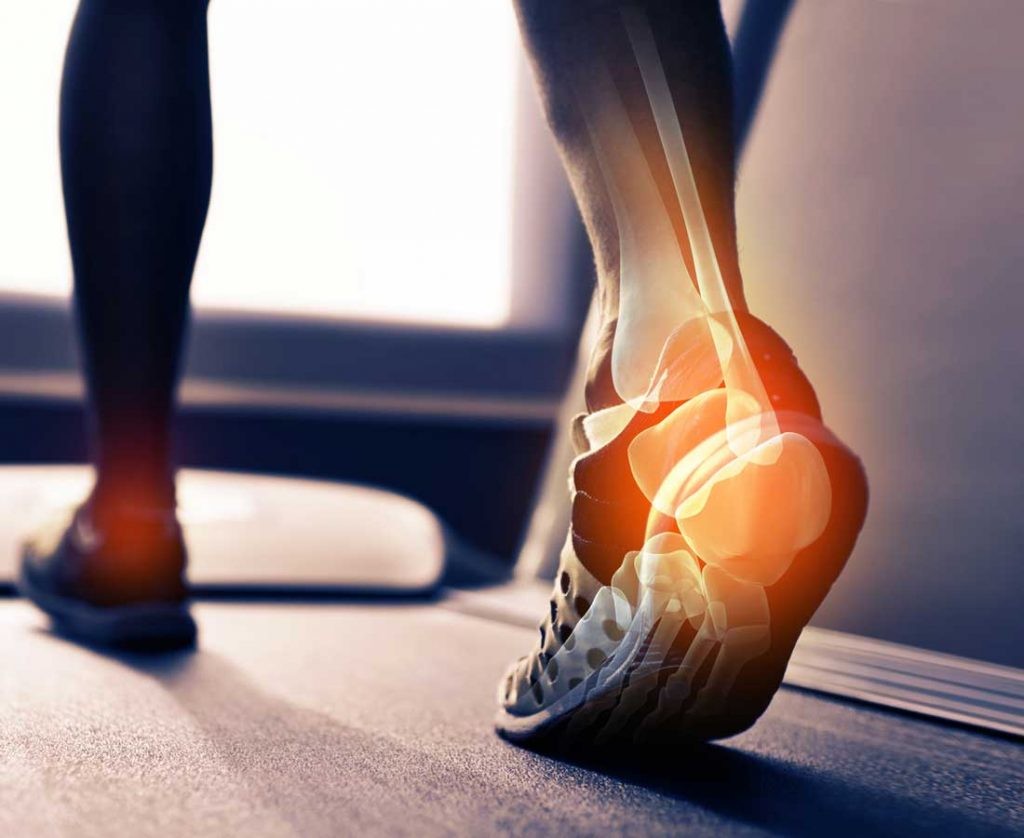
In its essence, running is a weight-bearing or endurance exercise. This in and of itself indicates that it has the potential to build and repair bone strength, according to Alexandria Williams, Road Runners Club of America’s certified running coach and director on the board of the National Black Marathoners Association.
“When a person runs actively, this motion causes new bone tissue to form, and thus helps bones [become] stronger,” she says. “With running, there is more impact, thus every time you run and push off your legs, the muscle contract[s] back and forth.” This motion, she explains, impacts not only the bones, but also blood flow, which all help in building healthy and strong bones.
The Role of the Foot Strike
Another reason you are able to build bone density when running is due in part to the fact that it is an open-chain exercise. This is where your foot comes off the ground and strikes it again. Closed-chain exercises, on the other hand, include cycling, swimming, and operating many exercise machines.
“The science of this is rather straightforward. When your foot strikes the pavement, your long bones in your shin and femur actually ionize. This causes your bones to pull more calcium and other essential nutrients from the blood and leads to greater bone density,” explains Roger E. Adams, Ph.D., personal trainer, doctor of nutrition, and owner of eatrightfitness. “Additionally, the force of the muscles pulling against the bones as you run stimulates some of this ionization as well.”
Any weight-bearing exercise will help, but running, with the extra stress of the foot strike, seems to have an increased ability to create the ionization in the bones, according to Dr. Adams.
However, it’s worth pointing out that the only skeletal bones that will benefit, or become stronger, from the act of running are those that experience increased stress from the weight-bearing activity. This tends to not include the upper body, as it hardly moves during a run.
The Downside
While the benefit of building bone strength from running is exciting, Dr. Adams points out that long distance runners may actually lose bone if they’re not careful. “The open-chain aspect to running does ionize and help the bones mineralize better. However, stress fractures can be a common ailment with long distance runners,” he says. “Researchers believe this is primarily due to diet restrictions or [a] too [little] caloric intake.”
Additionally, he points out that many elite or serious long distance runners carefully control their weight, which may mean that they’re not eating enough calories, especially calcium-rich dairy, to sustain healthy bones.
Besides the potentially favorable effects on bone density, running is associated with improved muscle profiles, as well. “Hamstring, quadriceps, and calf strength are beneficiaries of running workouts. However, what is unique about running, versus a less intense cardio activity such as walking, is the profound increased activity of the gluteal muscles in runners,” says Michael B. Gerhardt, M.D., sports medicine specialist and orthopedic surgeon at Cedars-Sinai Kerlan-Jobe Institute in Los Angeles, California and team physician for the U.S. Soccer Men’s National Team.
If you aim to run moderately—20 to 30 miles a week—you can expect to reap the bone-building and strengthening benefits of running.
Additionally, you can expect to strengthen the muscles attached to these bones in your lower body. “Running can make weak areas stronger. And [it] can actually increase mobility in joints, like the ankle, that tend to get stiff from not moving enough,” adds Dr. Adams.
(06/01/2021) ⚡AMPby Jenn Sinrich
After cancelling its April event due to COVID-19, the St. Jude Rock n’ Roll Marathon has been rescheduled for November 20
St. Jude Rock n’ Roll Marathon has been rescheduled for November 20, 2021.
Sharing in a release, “After assessing all event scenarios, we are pleased to share the 2021 St. Jude Rock ‘n’ Roll Nashville Marathon & ½ Marathon, has been rescheduled for November 20, 2021.”
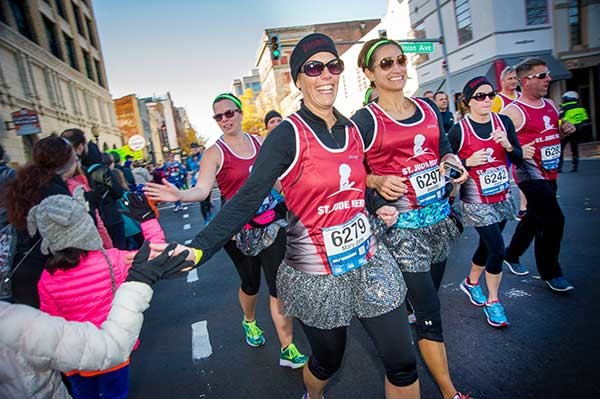
“We thank our participants for their commitment and look forward to providing them with an exceptional event experience later this year as they continue to pursue their goals,” continued the release.
No further updates have been shared in regards to entertainment. In addition, there’s no news on if the Health Expo Center will be available at Music City Center as was previously announced.
(06/01/2021) ⚡AMPby Donna Vissman
St. Jude Rock N Roll Nashville Marathon & 1/2 Marathon
The St. Jude Rock ‘n’ Roll Nashville Marathon & 1/2 Marathon (formerly St. Jude Country Music Marathon & 1/2 Marathon) gives you the opportunity to enjoy an up close and personal tour of Music City, one of the New York Times’ top destinations in the world! Run through the Honky Tonks of Lower Broadway and take a musical tour through...
more...Japan will consider limited spectators for Tokyo Olympics
The Tokyo Organizing Committee will decide the specific number of spectators for various venues by late June. A ticket lottery is under consideration.
The Japanese government and the Tokyo Organizing Committee have begun to consider the feasibility of allowing spectators into the venues for the Tokyo Olympic and Paralympic Games, The Sankei Shimbun learned on May 28.
This shift in thinking is based on the fact that currently a maximum of 5,000 spectators are allowed at large events, even though Tokyo and some other regions are under an extended state of emergency until June 20.
The Tokyo Organizing Committee is forging ahead with the task of redesigning the system for selecting spectators by holding a drawing from among the tickets that have earlier been sold. It plans to decide the specific number of spectators for various venues by late June.

Debate Over Spectators
A decision has already been made to exclude overseas visitors from the audience for the 2020 Games. As for residents of Japan, however, a final decision will come later in June, along with the planned expiration of the current state of emergency, according to Seiko Hashimoto, president of the Tokyo Organizing Committee, who spoke at a news conference on May 28.
“We have to think about the issue in line with limits [on spectators] that the national government has come out with,” she said. “What is important is to take into account the medical and scientific basis.”
Some sectors advocate the cancelation of the Games, anxious about people from around the country traveling to Tokyo for the Olympics. Dr. Haruo Ozaki, chair of the Tokyo Medical Association, recently said, “The Games, if held, should at the very least be without spectators.”

The government relaxed restrictions on spectators at large events on May 12, when it extended to other areas some state of emergency provisions covering Tokyo. While acknowledging the need for caps on spectators, the government set the limits for large events at “less than half of capacity” up to “a maximum 5,000,” instead of the previous regulation calling for no spectators at all.
Since then, large events, such as professional baseball games, have been held with spectators in Tokyo, but there have been no clusters of COVID-19 infections.
Government officials say large events can be held safely “with scientifically valid permissible levels of the number of visitors by requiring them thoroughly to wear face masks and avoid overcrowding when entering and exiting the venues.”
In a press conference on May 28, Prime Minister Yoshihide Suga cited a number of pro baseball and J. League professional soccer matches in Japan, noting he believes the “numbers of spectators [at the Olympics] can be set in reference to these examples.”
Tokyo 2020 president Seiko Hashimoto told reporters, “There have been calls from many [Olympic] ticket holders who want to watch the Games at the venues to the extent possible.”
A Fair Ticket System — Unless COVID Surges
The number of tickets considered to be in play for the Games is estimated at approximately half the capacity of each venue, if tickets sold abroad and those canceled after the decision on last year’s delay are factored out. The organizing committee is designing a new ticketing system that keeps group ticket applications intact as they prepare for a new ticket lottery.
Nevertheless, the option remains available to hold the Games without spectators in the event of a recurrence of COVID-19 infections.
Dr. Shigeru Omi, chairman of the government advisory expert panel on the coronavirus crisis, told a session of the Health, Labor and Welfare Committee of the House of Representatives on May 28, “The COVID-19 infection risks can be controllable for athletes and the others at the stadiums [of the Tokyo Games].”
However, he warned, “There is also a risk of the infections increasing because of the number of people moving around during the Games.” His remarks suggested that the government could change its decision just before the event and hold the Games without spectators, depending on the severity of infections.
(05/31/2021) ⚡AMPby The Sankei Shimbun
Tokyo 2020 Olympic Games
Fifty-six years after having organized the Olympic Games, the Japanese capital will be hosting a Summer edition for the second time, originally scheduled from July 24 to August 9, 2020, the games were postponed due to coronavirus outbreak, the postponed Tokyo Olympics will be held from July 23 to August 8 in 2021, according to the International Olympic Committee decision. ...
more...Great Britain´s Lee Thompson continues charge towards Tokyo Olympics with back-to-back wins
The 24-year-old, who trains at City of Sheffield and Dearne Athletic Club, finished first in two individual Men’s 400 Meters races in Manchester last week with times close to his personal best, according to trainer John Henson.
He is set to compete in the first fixture of the National Athletics League Premier division season on Sunday (June 6) before the Olympic trials on June 26 and 27. Both events will be held in Manchester.
"Things are going quite well at the moment,” John said.

"We’re entering quite a heavily competitive period leading up to the trials so we are looking forward to it.”
Worksop-based Lee, who specializes in 400 M but has begun competing in 200 M events to improve his race times, was scheduled to head to Switzerland for the Geneva International athletics meeting but quarantine restrictions mean that will no longer be possible.
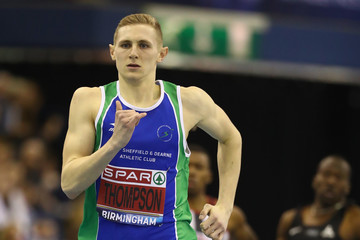
“It’s a pity because he could have done with a couple of good European races to finalize his preparation but it is what it is,” said John.
"He’s very confident and the last couple of races have given him that extra bit of boost.”
Lee balances a full-time career as an accountant with athletics and earlier this month helped Great Britain and Northern Ireland’s mixed 4 x 400M relay team secured a historic Olympic qualification.
This summer will be the first time a mixed relay event will be held at an Olympics.
The delayed Games are scheduled to take place between July 23 and August 8.
(05/31/2021) ⚡AMPby Steve Jones
Tokyo 2020 Olympic Games
Fifty-six years after having organized the Olympic Games, the Japanese capital will be hosting a Summer edition for the second time, originally scheduled from July 24 to August 9, 2020, the games were postponed due to coronavirus outbreak, the postponed Tokyo Olympics will be held from July 23 to August 8 in 2021, according to the International Olympic Committee decision. ...
more...Run with 4x U.S. Olympian Meb Keflezighi on Global Running Day
Imagine arriving at the starting line of your race and getting some last minute advice from running legend Meb Keflezighi before the race begins.
Better yet, imagine Meb in your ear coaching you the entire way.
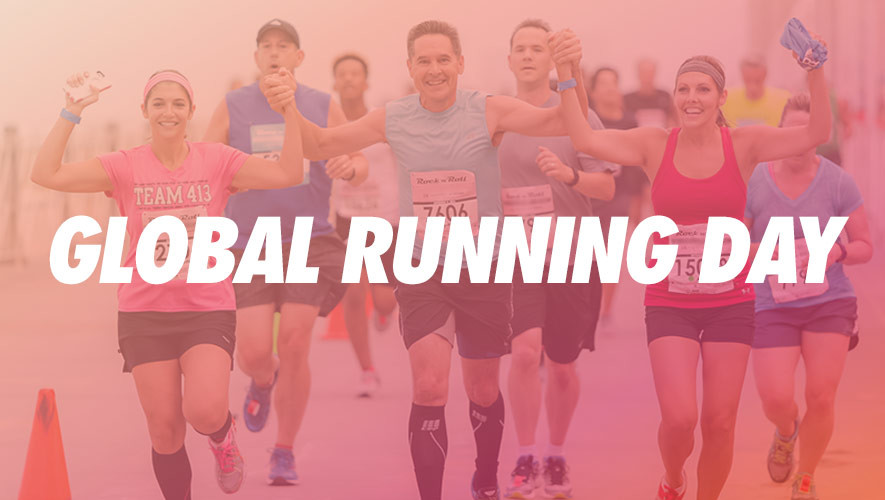
UCAN and Charge Running are partnering to create a one-of-a-kind virtual experience for runners with The Global Running Day 5K, poised to be the largest virtual 5k during this year’s annual celebration of running. The live event takes place Wednesday, June 2nd from 7-8 PM ET.
Meb will be featured on the mic alongside podcaster Ali Feller to motivate and entertain runners throughout their virtual 5K route.
“Running has given me so much opportunity in my life,” says Meb, a pastwinner of the Boston and NYC Marathons. “It’s an honor to be able to inspire others to get out there and chase their personal best or just enjoy being active on Global Running Day.”
The Global Running Day 5K will be hosted on the Charge Running app, which gives runners the feeling of an in-person road race with a live leaderboard, chat rooms and a live race announcer.
The entire experience is virtual which encourages participation from people all over the word.
“Partnering with UCAN on Global Running Day is an opportunity for Charge Running to do what it does best - Bring runners together from all over the world, in an engaging way and celebrate the love of running,” Said Julie Wallock, co-founder of the Charge Running App.
As part of the experience, a number of Olympic Trials qualifiers on Team UCAN will also be running the virtual race, so participants can test themselves against some of the fastest runners in the country.
“Our passion as a company is to enhance everyone’s pursuit of fitness,” says Shoba Murali, CEO of UCAN. “Combining the engaging technology of Charge Running with the innovative nutrition offered by UCAN is a great way for runners to take control of their fitness and health.”
For more information and to register for “The Global Running Day 5K, visit ucan.co/charge
About UCAN
Based in the US, UCAN is a company obsessed with the science of health and performance. UCAN enables athletes to gain confidence in their inherent abilities to surpass their performance by unlocking their body’s full potential through smart nutrition. UCAN products utilize SuperStarch®, a patented, slow-releasing complex carbohydrate that delivers steady, long-lasting energy without triggering an insulin response. Originally created for a child with a rare metabolic disorder, UCAN Energy Pouches, Powders, Energy Mix and Energy Bars are trusted by over 80 colleges, 40 pro teams, Olympic marathoners, elite triathletes, cyclists, group fitness coaches, thought leaders in health and performance, boxers, and recreational athletes for foundational nutrition to unlock performance. Learn more at ucan.co, and get the latest news in the UCAN world by following @GenUCAN on Facebook, Instagram and Twitter.
UCAN nutrition products are currently available in powder, pre-mixed, energy mix, and bar formats, in a variety of flavors, at 350+ specialty run, bike and tri stores around the country, Lifetime gyms, and can be purchased online at ucan.co or on Amazon.
About Charge Running
Charge Running is a mobile fitness app that provides LIVE coach-guided runs and races. With real-time coaches taking you through your workout, runners get updates on their current pace, average pace, distance, and more all while being ranked on a live leaderboard with other runners from all over the world.
(05/31/2021) ⚡AMPHow to exercise safely in hot weather?
With global warming, runners are more likely to be training and competing in unusually hot weather. To effectively reduce the risk of exertional heat stroke (and death), runners should allow 10 to 14 days to acclimatize to exercising in hot weather. During acclimatization, your body adapts to dissipate more heat, thereby enabling you to run better in hot conditions. Most physiological adaptations occur between days 4 to 8 of heat exposure.
During the first week of being exposed to heat, you should have only one training session per day; no double workouts! Ideally, you will have access to cool fluids during exercise—more likely to be consumed—and you will frequently take small swigs of fluid throughout exercise, as opposed to gulping a large bolus of fluid all at once.
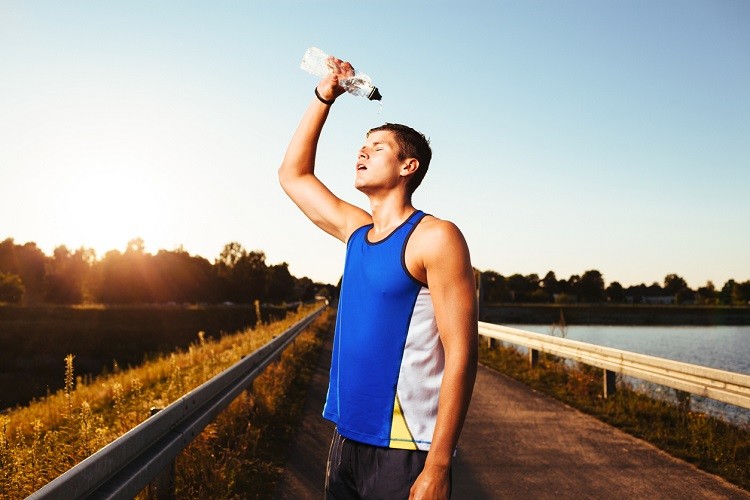
When exercising in the heat, you want to monitor your urine for color and quantity, and think WUT:
Weight: Is my morning weight lower than the day before?
Urine: Is my urine dark and concentrated?
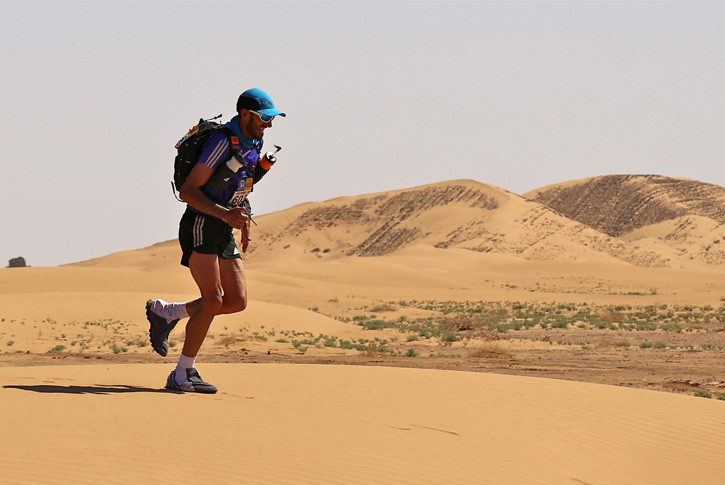
Thirst: Am I thirsty upon awakening?
Yes answers signal you are starting the day underhydrated.
In terms of health risks, being adequately hydrated is more important than being heat-acclimatized (though being well hydrated and heat-acclimatized is ideal for maximizing thermoregulation). An adaptation to heat acclimatization is reduced sodium in sweat. Despite that adaptation, endurance runners who do extended exercise in the heat often fail to replace adequate sodium. Salty sweaters (who have gritty sodium crystals on their skin) should purposefully consume sodium-rich foods and fluids.
Some runners salt-load for a day or two before an event, but researchers advise against doing that. The kidneys do a good job of excreting excess sodium via urine. The additional urine loss can be counter-productive and hurt, not enhance, performance.
Runners should try to replace 70% to 80% of sodium and fluid lost during sweaty exercise. Knowing your sweat rate (by comparing pre- and post-exercise body weight) can reduce your risk of over- or under-hydrating. Drinking too much water is dangerous, because it dilutes the body’s sodium level and can lead to life-threatening hyponatremia (low sodium).
Of all electrolytes, sodium is the biggest concern. Endurance runners need to figure out how to replace sodium losses. Through trial and error, you can learn which salty foods taste good, settle well, and “work” for you. Pickle juice, bouillon (cubes), mustard on soft pretzels, soy sauce (on rice) and beef jerky are popular options that can be consumed both right before, during, and/or after long runs.
(05/31/2021) ⚡AMPby Colorado Runner
Women’s world marathon record holder Brigid Kosgei says she is fit and healthy again as she eyes Olympics
Brigid Kosgei says she is firmly focused on adding Olympic gold to her medal collection after fully recovering from a slight leg injury.
The 26-year old tested herself at last month’s Istanbul Half Marathon where she clocked 1:16:01 to finish a disappointing fifth, in a race won by compatriot and fellow Olympics-bound, world marathon champion Ruth Chepng’etich in a world record time of 1:04:02.
"I had some minor injury when I competed in Istanbul but now I’m back fully fit and I will concentrate all my training at Kapsait until departure to Olympics,” she said.
The marathoner said an Olympic gold would be a dream-come-true for her having spent most of her childhood and teenage years wishing for an opportunity to represent Kenya at the quadrennial event.
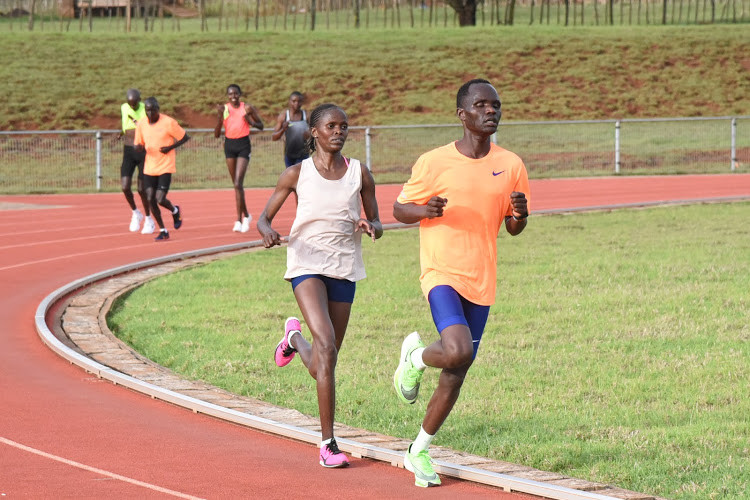
“While I was in Standard Eight, I watched the Olympic Games on television and I told myself ‘one day I’d also like to represent Kenya too. My home (Kapsowar) was quite a distance from school (10 kilometers) and I never wanted to be late that’s why I used to run quite a bit,’” she said in an earlier interview.
Kosgei has been hard at work in training, going through her paces at her Kapsait Training Camp in Elgeyo Marakwet under the watchful eye of her coach, former Honolulu Marathon champion Eric Kimaiyo.
Hers is a holistic training regime, which must take into account Kosgei's diet that hasn't changed much even in the build-up to Tokyo.
“My diet is the same and I haven’t changed anything. My body feels good and I want to push it to the limits and see how it responds on race day. We are mixing endurance and speed work with long runs," she said.
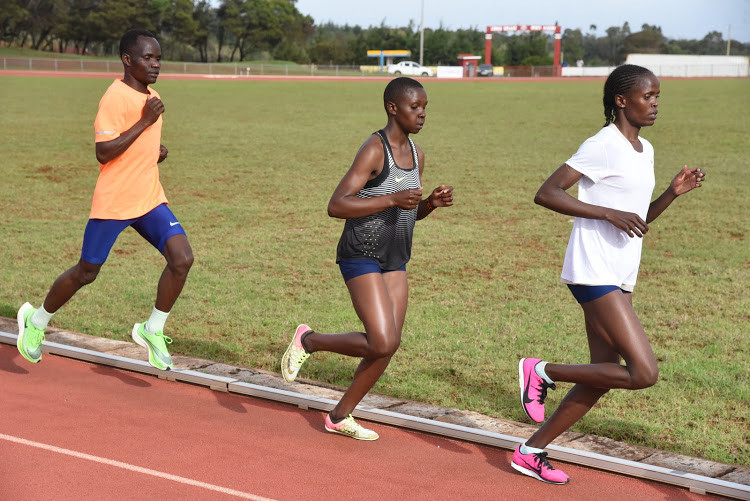
Kosgei, who is managed by the Italy-based Rosa Associati stable, has also been training in sunny conditions to ensure she acclimatises to the hot Japanese weather when she graces the Olympics.
She has responded perfectly to a recovery regimen that included sessions with Italian physiotherapist Sebastiano Erbi who spent some time monitoring her progress.
"The weather in Kapsait is good. Even when it rains, we still train, and even when it's cold, we also train; we are used to any weather condition here. We are also aware of the heat in Japan and that’s why we have some sessions at 4 pm when the sun is still out", Kosgei explains.
At times, the training group — which includes pacemakers — drive for close to two hours to Iten to access quality track sessions at the Lornah Kiplagat Academy and Stadium.
Kosgei has signed up with Stanbic Bank Kenya as ambassador in the bank’s new brand campaign dubbed "It Can Be."
The “It Can Be” campaign seeks to empower young men and women to achieve their big dreams with the world marathon record holder being used as an ambassador to motivate them.
(05/30/2021) ⚡AMPby Omondi Onyatta
Tokyo 2020 Olympic Games
Fifty-six years after having organized the Olympic Games, the Japanese capital will be hosting a Summer edition for the second time, originally scheduled from July 24 to August 9, 2020, the games were postponed due to coronavirus outbreak, the postponed Tokyo Olympics will be held from July 23 to August 8 in 2021, according to the International Olympic Committee decision. ...
more...Pro tips for hitting the trails this spring
Emma Neigel, member of Team Canada at the World Moutain Running Championships, offers her advice for transitioning from the track and roads to the trails
Canadian summer is officially on its way, and so is trail season. Now is the perfect time to swap out pavement and sidewalks for dirt paths and turn your run into an adventure. If you’re new to trail running and you’re feeling hesitant, we’ve got you covered. We spoke with Emma Neigel, a trackie-turned trail runner who was one of Canada’s top finishers at the 2019 World Mountain Running Championships for her best advice on making the transition from the roads and track to the trails.

Neigel’s advice for hitting the trails
For runners who are making the transition from the roads or track to the trails, Neigel’s first piece of advice is to invest in a good pair of trail shoes, since road running shoes lack the grip you need when navigating more difficult terrain, and provide little help when you hit a patch of mud. Her second piece of advice is to take the time to enjoy the trail. She suggests leaving the tech at home and simply taking in the sights and sounds of nature.

“Trail running is a great escape from the everyday hustle and bustle,” she adds.
Finally, she reminds runners not to forget why they enjoy the sport, and encourages them to run new routes, find running friends and to take advantage of the good weather.
“The hardest part about running is getting your foot out of the door,” she says, “so stay motivated by keeping things fun.”
(05/30/2021) ⚡AMPby Running Magazine
Runner wears Crocs in 5,000m race, flies to 14:47 finish
Who needs super spikes when Crocs are available?
Arunner named Benjamin Pachev raced a 5,000m in Portland on Saturday, running to a quick 14:47.62 finish. His time was good enough for 12th place, and although he didn’t win the race, he attracted a lot of attention during and after his run, which he completed in a pair of Crocs. That’s right, while his competitors were lacing up their spikes, Pachev tossed on his foam clogs, and he ended up beating about half of the field.
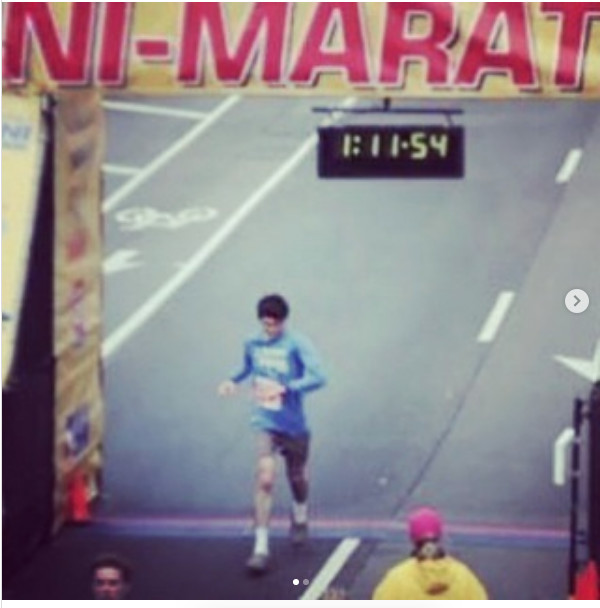
This is not the first time that Pachev has raced in Crocs. In 2017, he took his unique shoes to the Mini-Marathon in Indianapolis, where he raced a half-marathon with his father, Sasha. The younger Pachev ran to a mind-boggling time of 1:11:53, finishing in 16th place. His father, also wearing Crocs, crossed the line just a few minutes later, posting a time of 1:17:26 and finishing 44th out of more than 20,000 runners.
Pachev’s sister, Jennifer, ran the 5K at the event, and like her father and brother, she wore Crocs, the family’s apparent preferred choice of footwear. She finished in ninth overall and crossed the line as the second female runner, posting a time of 19:56.
On Saturday, Pachev recreated that Crocs magic, blazing to a sub-15-minute finish in Portland. His final time works out to 2:57 per kilometre, which is a pace most people would struggle to hit even if they were decked out in the fastest spikes on the market.
t’s clear that these shoes work for Pachev, but the question still remains: why Crocs? According to an article from the Indy Star that was published after the Pachevs’ runs at the Mini-Marathon, Sasha made the change from normal running shoes to Crocs after he saw his kids run in them.
“I was trying to figure out if there was a better way to run than in regular running shoes,” Sasha said. “I was experimenting with different things.” When his kids insisted on running in Crocs one day, he noticed that their form was better than it was in other shoes, so he tried them out for himself.
“I really liked the feeling, and I’ve run in them ever since,” he said. “They’re really not that much different, speed-wise, from racing flats.” Sasha’s kids followed his lead, and the shoes are now the go-to footwear for the family. The Pachevs certainly look peculiar walking up to the start line at races in their Crocs, but they have proven that these shoes work well for them, so it’s likely that the running world will hear more stories from the speedy Crocs-supporting family in the future.
(05/30/2021) ⚡AMPby Running Magazine
Ethiopian runner sets men’s 50K world record with 2:42:07 run in South Africa
Ketema Negasa broke the men's world record and South Africa's Irvette Van Zyl ran the second-fastest women's 50K in history
Ethiopia’s Ketema Negasa broke the men’s 50K world record on Sunday, running 2:42:07 at the Nedbank Runified race in South Africa. Negasa led the way as he and three other runners beat American CJ Albertson‘s previous record of 2:42:30. In the women’s race, Des Linden‘s recent 2:59:54 world record remained unbeaten, but South Africa’s Irvette Van Zyl ran a national record of 3:04:23, which is the second-fastest women’s result in history.
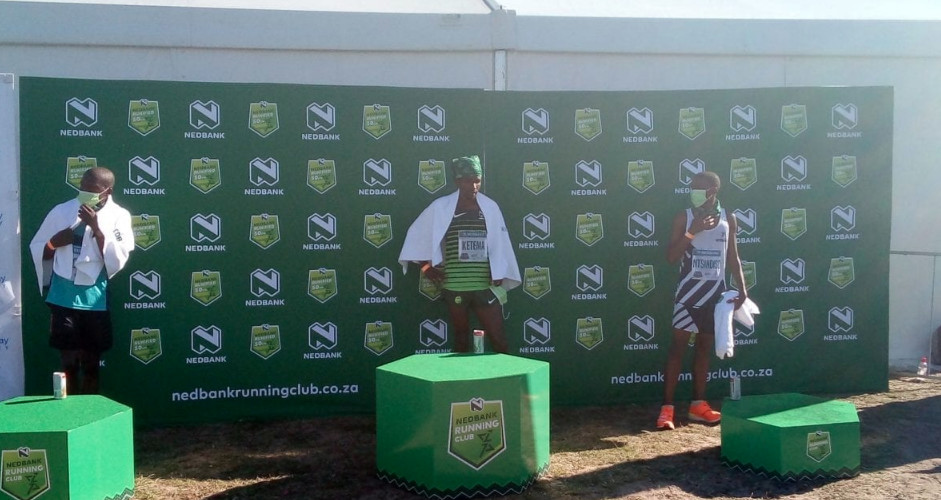
Negasa’s record
Negasa is primarily a marathoner, but he has never been able to match the necessary times to shine in Ethiopia. He owns a marathon PB of 2:11:07, a time that would rank him in the top 10 all-time among Canadian runners but isn’t even in the top 250 results in Ethiopian history. After his run on Sunday, though, it looks like ultras may be his forte.
It’s important to note that Albertson’s world record, which he set in November 2020, came on a track, while Negasa’s run on Sunday was on the road. Ultrarunning world bests are unique in this sense, because while Albertson and Negasa ran on completely different surfaces, their runs count in the same category of the 50K in general, as the International Association of Ultrarunners introduced a rule that eliminated surface-specific records in 2014. In other World Athletics-sanctioned events, the surface comes into play. For example, the 5K and 5,000m world records both belong to Uganda’s Joshua Cheptegei, but they’re two different times.
Negasa’s run worked out to an average per-kilometre pace of 3:15 for the full 50K, which helped him top Albertson’s result by 23 seconds. He crossed the line in first place, and he was followed closely by Machele Jonas, who also beat Albertson’s record with a 2:42:15 run. Third went to Mphakathi Ntsindiso in 2:42:18, and in fourth place was Kiptoo Kimaiyo Shedrack, who just beat Albertson’s record in 2:42:29.
Irvette Van Zyl run
Had the Nedbank Runified race been held a couple of months earlier, Van Zyl would have broken the women’s 50K world record. Since the race took place in late May, though, Van Zyl was late to the party, and her time is second-best to Linden’s. When she ran her race in Oregon, Linden became the first woman to break three hours over 50K, and she smashed Aly Dixon‘s previous record of 3:07:20.
While Van Zyl didn’t manage to beat Linden, she did crush Dixon’s result with her 3:04:23 finish, which is the new South African 50K record. Behind Van Zyl was Lilian Jepkorir Chemweno, who finished in second place in 3:05:00, which is now the third-fastest 50K in history.
(05/30/2021) ⚡AMPby Running Magazine
Hobbs Kessler Breaks Alan Webb’s Legendary High School 1500m Record
Runs 3:34.36 to Get Under Olympic Qualifying Standard
In one of the most incredible runs ever by an American high schooler, 18-year-old Hobbs Kessler ran a 3:34.36 1,500m at the Portland Track Festival tonight to obliterate the US high school record. The previous record, 3:38.26, was set by Alan Webb as a 1500 split en route to his legendary 3:53.43 high school mile record at the 2001 Prefontaine Classic.
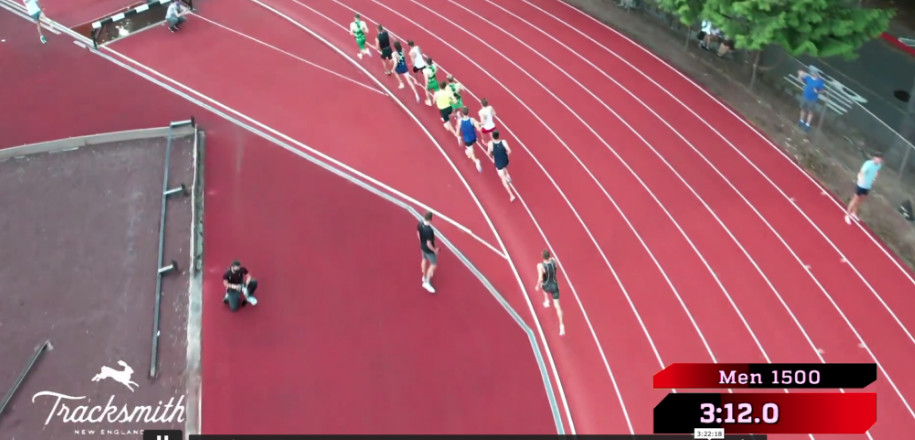
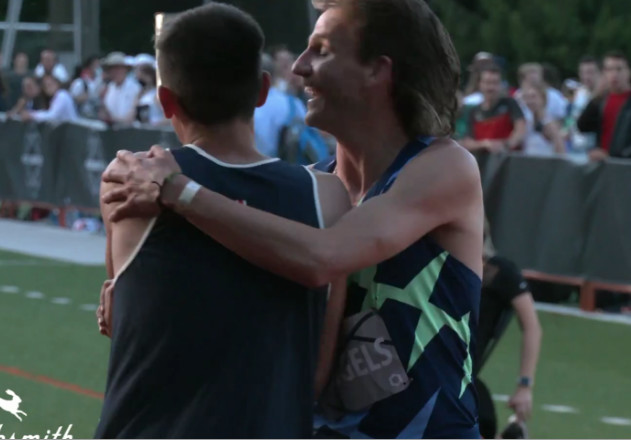
Webb’s 3:53.43 has gone unchallenged for two decades, but according to World Athletics’ scoring tables, Kessler’s 1500 tonight was the superior performance; converting to 3:51.34 for the mile (Webb’s 3:53.43 mile converts to 3:36.30 for 1500). Kessler’s time is also faster than Jim Ryun‘s US U20 1,500 record of 3:36.1 which had stood since 1966.
Kessler, who was last in the lead pack of ten with 200m to go, moved up well the final 100 meters, and threw up his hands just before the finish line as he saw the clock and finished 5th in a race won by reigning US champ Craig Engels in a personal best of 3:33.64. Engels, the 2019 US indoor/outdoor champion and a World Championship finalist, entered tonight with a pb of 3:34.04 — barely faster than what Kessler ran.
Kessler, a senior at Community High School in Ann Arbor, Mich., was already a high school record holder after running 3:57.66 in February to take down the indoor mile record. Now he is, quite simply, one of the best milers in the United States, regardless of age. His time was the third-best by an American in 2021 — only the winner Engels and fourth-placer Henry Wynne (3:34.08) have run faster this year.
How incredible was Kessler’s run? He didn’t just break the US high school record by almost four seconds; he also ran faster than the collegiate record of 3:34.68 set by Notre Dame’s Yared Nuguse two weeks ago. He also hit the Olympic standard of 3:35.00 — one of just seven Americans to have done so during the qualification period.
Kessler’s run was so much faster than any other high schooler has run for 1500 that it is hard to even make comparisons. Webb’s 3:53.43 at Prefontaine, which celebrated its 20th anniversary on Thursday, is the obvious one. Just like Webb, Kessler finished 5th in a field of pros, and just like Webb, Kessler was mowing them down over the final 100 meters.
As impressive as Kessler’s run was tonight, it was not the greatest ever performance by an American U20 athlete. That remains Jim Ryun’s 3:51.3 mile in July 1966 — a world record at the time that would stand for eight years. Ryun was just 19 years old at the time of that race, which came after his freshman year of college.
Kessler is a high school senior. His sometimes training partner, Nick Willis, an Olympic 1500m silver and bronze medallist, was in this race and tried to put it in perspective on the broadcast afterwards, “I became a spectator to the greatest performance ever by a high school miler,” said Willis, noting he himself went out at the pace prescribed for the rabbits for 800, yet was in last place. “It’s like Jim Ryun reincarnated again…He’s such a rookie in terms of running…. He’s so raw.”
(05/30/2021) ⚡AMPby Let’s Run
World 200m champion Dina Asher-Smith returns as Diamond League goes back to Gateshead
Asher-Smith will fine-tune her preparations for the Olympic Games when she races in Gateshead on 13 July, following confirmation that the Wanda Diamond League series will be returning to the North East of England for the Muller British Grand Prix.
The Diamond League season opener had been scheduled for Rabat on 23 May but moved to the Gateshead International Stadium due to ongoing coronavirus restrictions. At that meeting Asher-Smith battled the rain and wind to win the 100m and in July she will contest the 200m on that same track.
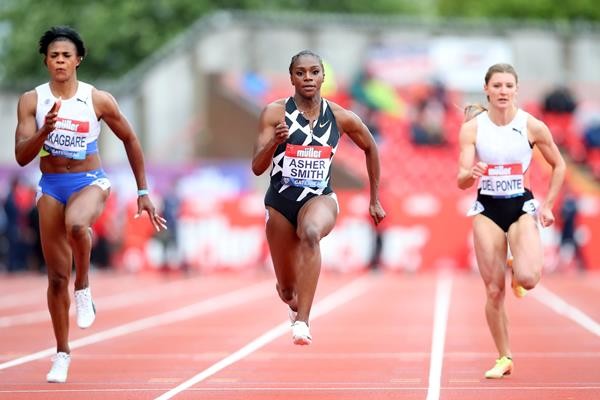
“My first 100m of 2021 last weekend was against some tough opposition and I’m expecting it to be another exciting race when I go back there in a few weeks’ time,” said Asher-Smith, who triumphed ahead of Sha’Carri Richardson, Marie-Josee Ta Lou and Shelly-Ann Fraser-Pryce.
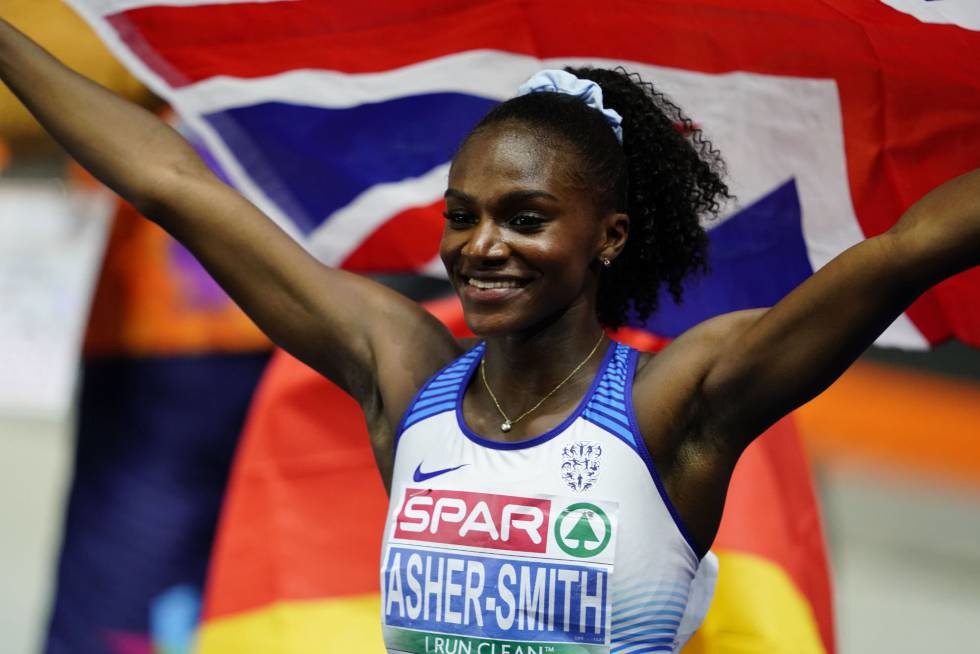
“Hopefully we will be allowed to have more fans in the stadium and the athletes will get a great send off before they go to the Olympic Games in Tokyo.”
The event on 13 July was originally due to be held at the London Stadium but has been moved to Gateshead due to the repercussions of the pandemic and after an agreement was reached between UK Athletics and the London Legacy Development Corporation.
After successfully welcoming back 2,000 spectators at the Muller Grand Prix Gateshead, British Athletics hopes that more fans will be able to safely return to the stadium for the Muller British Grand Prix.
(05/29/2021) ⚡AMPby World Athletics
South African Caster Semenya runs PB, misses 5,000m Olympic standard by 22 seconds
Olympic and world 800m champion Caster Semenya raced a 5,000m on Friday at a race in her home country of South Africa, and while her 15:32.15 run was a 20-second PB, it was still well off the Olympic standard of 15:10.00.
A 2019 World Athletics ruling bars Semenya, who is an athlete with DSD (differences of sexual development), from competing in races from the 400m up to the mile, so she has set her sights on the 5,000m for the upcoming Tokyo Games.
Since the WA ruling blocked Semenya and other DSD athletes (who have higher-than-normal levels of testosterone) from competing in anything from the 400m to the mile, it gave her a couple of options: drop down to sprint races or jump up to longer runs. A third option offered by WA was for DSD athletes to take medications to lower their testosterone, but Semenya refused to do so.
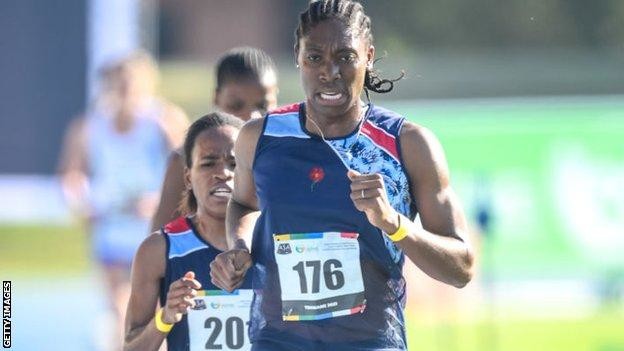
At first, Semenya dabbled in sprints, and in 2020, she got her 200m PB down to 23.49 seconds. This was still well off the Olympic 200m standard of 22.80, though, and Semenya shifted gears once more, this time jumping up to the 5,000m (which is the next-shortest race available to her and other DSD athletes in the Olympic program). She has raced the 5,000m three times in 2021, improving with each run.
First, she ran 16:14.43 in March, finishing more than a minute off Olympic standard. A few weeks later, she broke 16 minutes for the first time in her career, posting a huge PB of 15:52.28. Unfortunately for Semenya, despite the big step toward Olympic standard, this time was still 42 seconds slower than she needed to run. On Friday, she got closer to standard, but she still sits well away from 15:10.00. The Olympic qualifying window closes at the end of June.
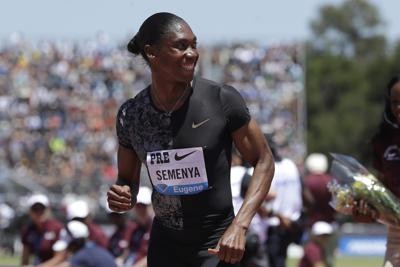
One piece of good news for Semenya is the fact that only one South African woman has hit Olympic standard during this current qualifying period. Dominique Scott ran 14:59.08 at a race in the U.K. in July 2019, which gives her by far the best result among South African women since the qualifying window opened in May of that same year.
This is good for Semenya because it means she doesn’t have to compete with other South African Olympic hopefuls. Each country can only send three men and three women per event to the Olympics, and if three South African women had already hit standard, it would likely mean that Semenya would have to not only run under 15:10.00, but also beat the slowest of those athletes.
Semenya is not the only DSD athlete looking to make the Tokyo Games in the 5,000m — Burundi’s Francine Niyonsaba has also made the jump up in distance. Niyonsaba won silver behind Semenya in the 800m at the Rio Olympics in 2016 and the 2017 world championships. While Semenya was the stronger of the two in the 800m, it looks like Niyonsaba is better at the 5,000m, as she recently ran a Burundian national record of 15:12.08. This time won’t get her into the Olympics, but seeing as she’s just two seconds off standard, she appears to have a much better shot at making it to Tokyo than Semenya does.
(05/29/2021) ⚡AMP
by Ben Snider-McGrath
Mastering the Long Run
The long run garners more attention than any other component of marathon training. It has become a status symbol among runners in training, a measure by which one compares oneself against his or her running counterparts. It is surprising, then, to discover that much of the existing advice on running long is misguided. After relatively low-mileage weeks, some training plans suggest backbreaking long runs that are more akin to running misadventures than productive training.
A 20-mile long run at the end of a three-day-a-week running program can be both demoralizing and physically injurious. The long run has become a big question mark, something you aren't sure you'll survive, but you subject yourself to the suffering nonetheless. Despite plenty of anecdotal and academic evidence against such training tactics, advice to reach (or go beyond) the 20-mile long run has persisted. It has become the magic number for marathoners, without consideration for individual differences in abilities and goals.
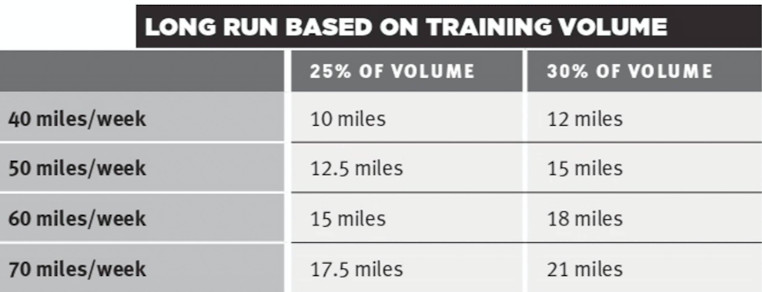
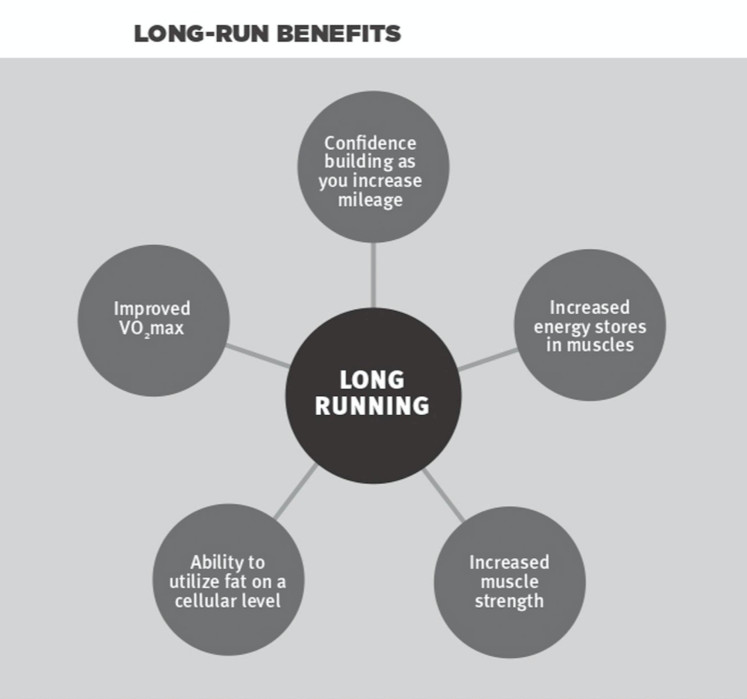
While countless marathoners have made it to the finish line using these programs, I believe in a different approach. Not only will it make training more enjoyable, it will also help you cover 26.2 more efficiently.
While my long-run approach may sound radical, it is deeply rooted in results from inside the lab and outside on the roads. As I read through the exercise science literature, coached the elite squad with Kevin and Keith Hanson, and tested theories in my own training, I realized that revisions to long-held beliefs about marathon training, and in particular long runs, were necessary. As a result, a 16-mile long run is the longest training day for my standard program.
But there's a hitch: One of Kevin and Keith's favorite sayings about the long run is, "It's not like running the first 16 miles of the marathon, but the last 16 miles!"
What they mean is that a training plan should simulate the cumulative fatigue that is experienced during a marathon, without completely zapping your legs. Rather than spending the entire week recovering from the previous long run, you should be building a base for the forthcoming long effort.
For example, if you have a 16-mile Sunday long run on your schedule, leading up to it, you should do a tempo run on Thursday and easier short runs on Friday and Saturday. Don't take a day completely off before a long run because recovery occurs on the easy running days. Since no single workout has totally diminished your energy stores and left your legs feeling wrecked, you'll feel the effects of fatigue accumulating over time. This allows for partial recovery, but it is designed to keep you from feeling completely fresh going into a long run. Following the Sunday long run, try an easy day of running on Monday and a strength workout Tuesday.
This may initially appear to be too much, but if your long run's pace and mileage are tailored to your ability and experience, less recovery is necessary.
The Physiology of Long Runs
Long runs bring with them a laundry list of psychological and physiological benefits, many of which correlate with the profits of easy running. Mentally, long runs during marathon training help you gradually build confidence as you increase your mileage from one week to the next.
They help you develop the coping skills necessary to complete any endurance event. They also teach you how to persist even when you are not feeling 100 percent. Since you never know what is going to happen on marathon day, this can be a real asset. Most notable, however, are the physiological adaptations that occur as a result of long runs. Improved VO2max, increased capillary growth, and a stronger heart are among the benefits. Long runs also help to train your body to utilize fat as fuel on a cellular level. By training your body to run long, you let it adapt and learn to store more glycogen, thereby allowing it to go farther before becoming exhausted.
In addition to improving the energy stores in your muscles, long runs also increase muscle strength. Although your body first exploits the slow-twitch muscle fibers during a long run, it eventually begins to recruit the fast-twitch fibers as the slow-twitch fibers fatigue.
The only way to train those fast-twitch fibers is to run long enough to tire the slow-twitch fibers first. By strengthening all of the fibers, you'll avoid bonking on race day. By now the majority of these adaptations are probably starting to sound familiar. You can expect many of the same benefits reaped from easier work from long runs too.
Long-Run Guidelines
Advice from renowned running researcher and coach Dr. Jack Daniels provides a basis for our long-run marathon training philosophy. He instructs runners never to exceed 25-30 percent of their weekly mileage in a long run, whether they are training for a 5K or a marathon. He adds that a 2:30-3:00-hour time limit should be enforced, suggesting that exceeding those guidelines offers no physiological benefit and may lead to overtraining, injuries, and burnout.
Dr. Dave Martin, running researcher at Georgia State University and a consultant to Team USA, goes one step further, recommending that long runs be between 90 minutes and 2 hours long. While he proposes 18-25-mile long runs for high-level marathoners, one must take into consideration that a runner of this caliber can finish a 25-mile run in under 3 hours.
This highlights the importance of accounting for a runner's long-run pace. Dr. Joe Vigil, a Team USA coach and scientist, further supports this notion, advising that long runs be increased gradually until the athlete hits 2:00-3:00 hours. Certainly a 25-mile run completed in less than 3 hours by an elite runner will provide different physiological adaptations than a 25-mile run that takes a less experienced runner 3:30 hours or more.
According to legendary South African researcher and author Dr. Tim Noakes, a continual, easy-to-moderate run at 70-85 percent VO2max that is sustained for 2 hours or more will lead to the greatest glycogen depletion. Exercise physiologist Dr. David Costill has also noted that a 2-hour bout of running reduces muscle glycogen by as much as 50 percent. While this rate of glycogen depletion is acceptable on race day, it is counterproductive in the middle of a training cycle, as it takes as many as 72 hours to bounce back.
When you diminish those energy stores, you can end up benched by fatigue, missing out on important training, or training on tired legs and potentially hurting yourself. Instead of risking diminishing returns and doing an arbitrary 20-mile run, look at your percentage of mileage and total time spent running. (I often suggest a maximum of 16 miles, but we are more concerned with determining your long run based on your weekly total mileage and your pace for that long run.)
It may sound unconventional, but you'll find that it isn't random; these suggestions are all firmly based in science with proven results. As stipulated by Dr. Noakes, it is widely accepted among coaches that long runs shouldn't exceed 25-30 percent of weekly mileage. Even so, that guideline manages to get lost in many marathon-training programs in the effort to cram in mileage. For instance, a beginning program that peaks at 40-50 miles per week and recommends a 20-mile long run is violating the cardinal rule. Although the epic journey is usually sandwiched between an easy day and a rest day, there is no getting around the fact that it accounts for around 50 percent of the runner's weekly mileage. Looking at the table below, you can see how far your long run should be based on your total mileage for the week.
The numbers illustrate that marathon training is a significant undertaking and should not be approached with randomness or bravado. They also make apparent the fact that many training programs miss the mark on the long run. If you are a beginning or low-mileage runner, your long runs must be adjusted accordingly. What is right for an 80-mile-a-week runner is not right for one who puts in 40 miles a week.
In addition to running the optimal number of miles on each long run, you must also adhere to a certain pace to get the most benefit. Since we don't all cover the same distance in the same amount of time, it makes sense to adjust a long run depending on how fast you'll be traveling. The research tells us that 2:00-3:00 hours is the optimal window for development in terms of long runs. Beyond that, muscle breakdown begins to occur. Look at the table below to see how long it takes to complete the 16- and 20-mile distances based on pace. The table demonstrates that a runner covering 16 miles at a 7-minute pace will finish in just under 2 hours, while a runner traveling at an 11-minute pace will take nearly 3 hours to finish that same distance. It then becomes clear that anyone planning on running slower than a 9-minute pace should avoid the 20-mile trek.
At what pace should I do my long run?
We generally coach runners to hold an easy-to-moderate pace throughout a long run. Instead of viewing your long run as a high volume easy day, think of it as a long workout. If you are new to marathoning, err on the easy side of pacing as you become accustomed to the longer distances. More advanced runners should maintain a moderate pace as their muscles have adapted to the stress of such feats of endurance. In the long run (literally and figuratively), when you avoid overdoing these lengthy workouts, you reap more benefits and avoid the potential downfalls of overtraining.
(05/29/2021) ⚡AMPby Trail Runner Magazine
11 Snacks to Eat After a Run That’ll Help You Refuel and Recover Faster
Whether you’re short on time or your stomach can’t handle much food after your miles, these options will do the trick.
Although it’s often overlooked, the post-run recovery meal or snack is one of the most crucial elements of your fueling plan. You may think that what you eat before a run is all that matters, but good postrun recovery nutrition also plays an important role in your overall performance.
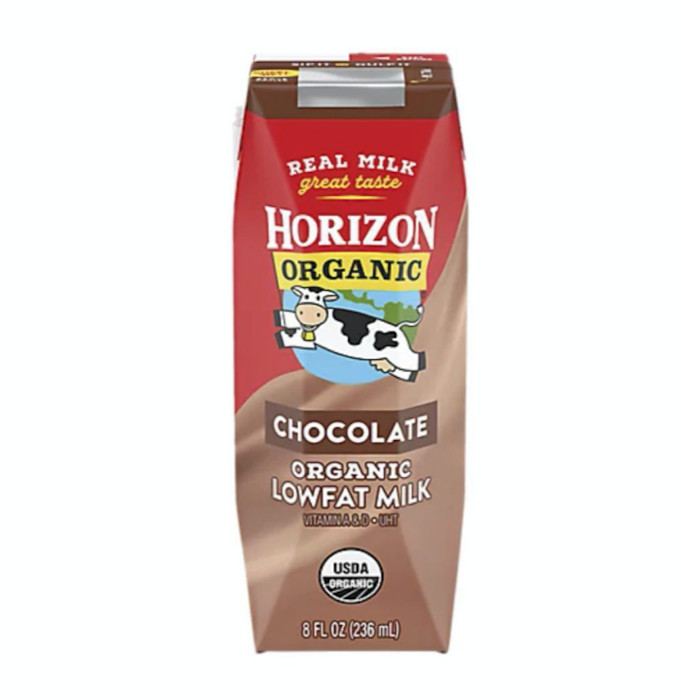

During a run, your body utilizes glycogen (your body’s source of stored carbs) for energy, and your muscles experience tiny little tears. To replace the glycogen stores and aid in muscle recovery, you want to eat foods that have a combination of carbs and protein. Ideally, a 3:1 carb-to-protein ratio has been shown to be most beneficial for post-workout recovery. In other words, a food should have 1 gram of protein for every 3 grams of carbs.
Whether you’re short on time or your stomach can’t handle much food after a run, eating a full recovery meal isn’t always doable. But there are a wide range of snacks that fit the post-run criteria. We’ve compiled a list of some of our favorite healthy packaged snacks, so you can quickly recover after logging your miles.
1 Chocolate Milk
These 8-ounce containers of chocolate milk contain the classic 3:1 carb-to-protein ratio, with 23 grams of carbs and 8 grams of protein. If you have a sensitive stomach and can’t get down food after a run, you may find it easier to drink a carton of chocolate milk. Plus, milk has nine essential vitamins and minerals, including vitamin D and calcium for bone health.
2 Maple Oats
RX is taking oatmeal up a notch with the addition of egg whites, nuts, and dates. Made with simple ingredients, RX oatmeal is ready in minutes with hot water and a microwave, and it has 35 grams of carbs and 12 grams protein. If you prefer something cold after a run, fill it with water and stick it in the fridge before you head out the door for post-run overnight oats.
3 Classic Hummus and Pretzels
If you’re craving a savory snack after a run, reach for a conveniently packaged serving of hummus and pretzels. With 10 grams of protein and 40 grams of carbs, this snack comes close to the 3:1 ratio. And it also includes sodium—an important electrolyte lost in sweat—as well as fiber, which helps keep you fuller for longer.
4 Bada Bean Bada Boom Crunchy Broad Beans
Otherwise known as fava or field beans, roasted broad beans are the newest crunchy snack to rival chips. Packed with protein and fiber, not to mention they are naturally vegan and gluten-free, roasted broad beans are a healthier option than many other crispy snacks. A 1-ounce serving has 15 grams of carbs and 7 grams of protein, so pair it with a piece of fruit for an extra carb boost.
5 Peanut Butter Chocolate Chip Organic Vegan Protein Bar
There are a ton of protein bars on the market, but only few offer a short list of recognizable ingredients with a 3:1 carb to protein ratio. GoMacro does a good job of using real ingredients—such as nuts, puffed brown rice, and pea protein—and each protein bars have 11 grams of protein with 36 grams of carbs.
6 Strawberry Chia Organic Cottage Cheese
Whether you love or hate it, cottage cheese is packed with protein and bone-building calcium. Add in fruit, and you’re on your way to a post-run recovery snack. Since a container of Good Culture’s strawberry cottage cheese has more protein than carbs (17 grams of protein and 10 grams of carbs), slather it onto a piece of whole grain bread to make sure you replace glycogen stores.
7 Organic Crunchy Chickpeas
Chickpeas are naturally rich in both protein and carbohydrates, and roasted chickpeas are a delectable and crunchy post-run snack. Whether you throw them on salad or eat them straight out of the bag, you’ll get 6 grams of protein and 18 grams of carbs for every 1/4-cup serving. Not to mention, Saffron Road has tasty flavors, such as Buffalo, Bombay Spice, Chipotle, Falafel, and Korean BBQ.
8 Sea Salt Dry Roasted Edamame
This sushi night staple is a protein powerhouse and easy to store in the freezer. But on days when you don’t feel like microwaving, Seapoint Farms makes a dry roasted edamame with just soy beans and salt. Dried edamame is higher in protein than carbs, so grab a handful with a piece of fruit, bread, or whole grain crackers.
9 SunSeed Butter Chocolate Protein Bites
If you’ve got a sweet tooth, Enjoy Life protein bites are a tasty combo of chocolate and other delicious flavors, such as mint, banana, raspberry, and sunseed butter. Three bites have 6 grams of protein and 18 grams of carbs, and they are so easy to pop into your mouth directly after a run.
10 S’Mores Flip Greek Yogurt
Greek yogurt is packed with natural protein, and Chobani has added a sprinkle of other ingredients, such as nuts, pretzels, graham crackers, and toffee to give you a hint of sweetness while also replacing glycogen stores. Each Flip has around 9 grams of protein and 25 grams of carbs. Chobani Flip’s other flavors and mix-ins include banana cream pie, cookie dough, brownie bliss, and cookies and cream.
11 White Cheddar Cheese, Sea Salted Roasted Almonds, and Dried Cranberries
Cheese, nuts, and dried fruit come together in these Sargento Balanced Breaks to offer post-run protein, healthy fats, and carbs. With different types of nuts, cheese, and dried fruit, you can choose the variety that speaks to you. The perfectly portioned snack has 7 grams of protein and 12 grams of carbs, so pair it with a handful of granola.
(05/29/2021) ⚡AMPby Runners World
Ron Hill, former British marathon runner dies at age 82
Every day between 1964 and 2017 the renowned British athlete Ron Hill ran at least a mile, setting a world record streak of 52 years and 39 days that still stands – even after snapping his sternum in a car accident in 1993.
Yet that was one of many achievements in a glorious career. For Hill, who has died at the age of 82, was also an Olympian, inventor, innovator and undoubtedly one of the country’s greatest marathon runners.
In 1970 he became the first Briton to win the Boston Marathon, breaking the course record, and won Commonwealth gold the same year in a time of 2hr 9min 28sec – becoming only the second man to ever go under 2hr 10min.
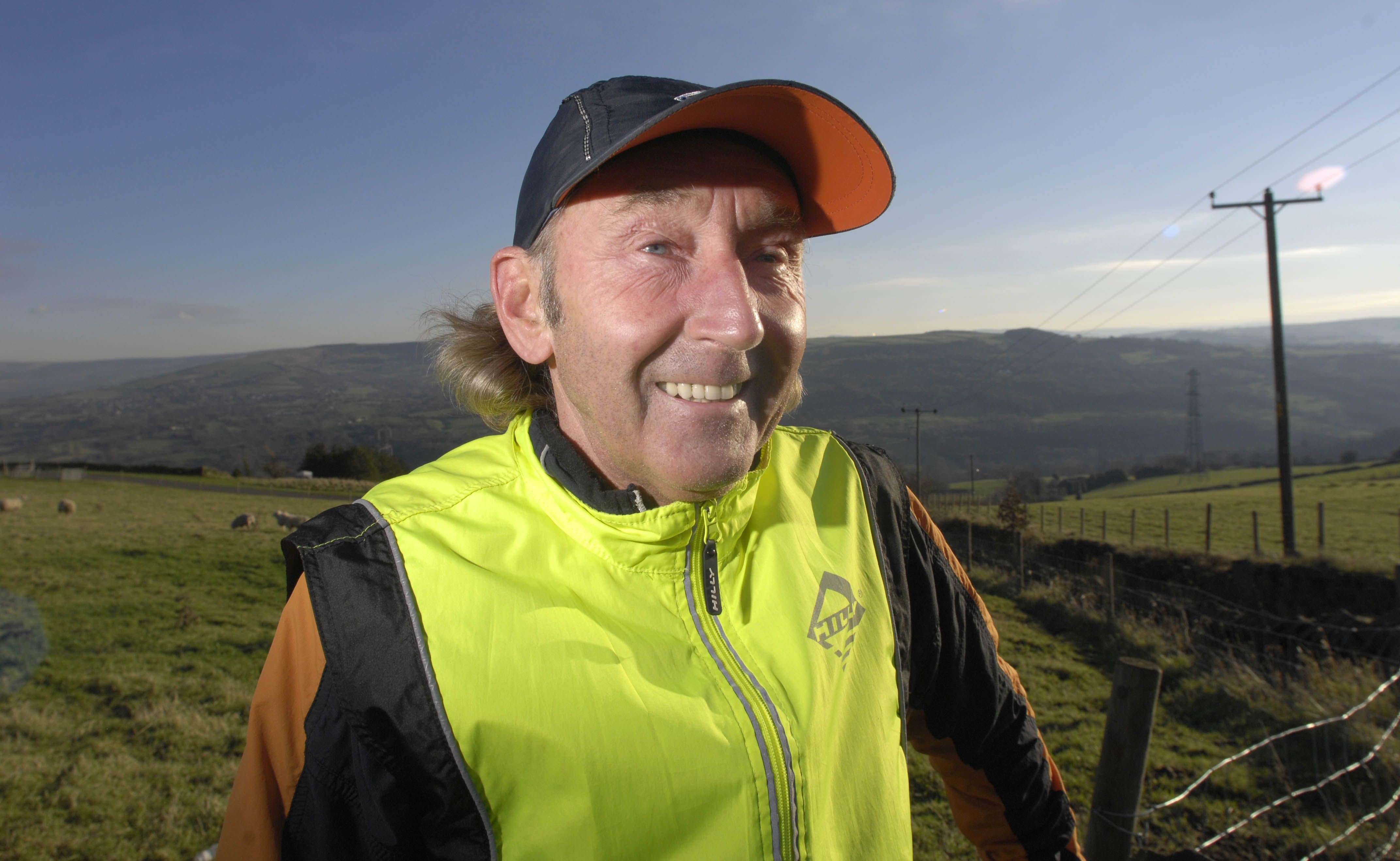
Hill also competed at the Olympics three times, finishing seventh in the Mexico 1968 Games despite running barefoot, and sixth in Munich four years later.
He was one of the pioneers of “carbo-loading” before a marathon to increase glycogen stores. And he used his PhD in textile engineering to good effect to invent and then race in breathable mesh vests to keep cool – a huge innovation at the time. His company Ron Hill Sports also led the way with their “trackster” tights before the lycra boom in the 1980s and 90s.
The tributes to Hill were led by Dave Bedford, the former 10,000m world record holder, who said Hill was “a great man, a great athlete, and a great influence to so many during the golden age of British distance running, including myself.
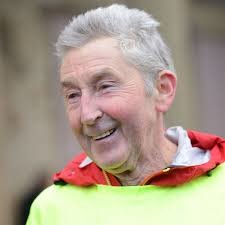
“His dedication to his sport was extraordinary, but he also stood out for being a great innovator,” he added. “He led the way with carbo-loading and with textiles. I doubt there is a British athlete in the last 30 years who hasn’t worn a pair of Ron Hill tracksters at some point. He will be deeply missed.
The 1991 world 10,000m champion Liz McColgan also paid her respects. “So sad to hear of the passing of marathon legend Ron Hill, an inspirational athletic icon over the years sincere condolences to his family. The wider running community will miss you. RIP.”
Hill’s clothing company Ronhill confirmed his death in a social media statement. “It is with immense sadness we today mourn the passing of British running legend Dr Ron Hill MBE, our founder, our inspiration, a husband, a father, a grandfather, a runner.”
(05/29/2021) ⚡AMPHow shepherd saved runners in deadly China ultra-marathon race
A shepherd has been hailed as a hero in China after it emerged that he saved six stricken runners during an ultramarathon in which 21 other competitors died.
Zhu Keming was trending on the Twitter-like Weibo on Tuesday, three days after a 100-kilometre (60-mile) cross-country mountain race in the northwestern province of Gansu turned deadly in freezing rain, high winds and hail.
The incident triggered outrage and mourning in China, as questions swirled over why organisers apparently ignored warnings about the incoming extreme weather.
Zhu was grazing his sheep on Saturday around lunchtime when the wind picked up, the rain came down and temperatures plunged, he told state media.
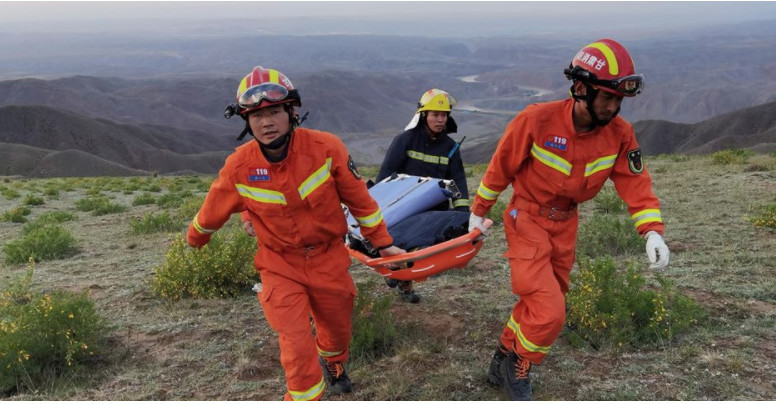
He sought refuge in a cave where he had stored clothes and food for emergencies but while inside spotted one of the race's 172 competitors and checked to see what was wrong because he was standing still, apparently suffering cramps.
Zhu escorted the man back to the cave, massaged his freezing hands and feet, lit a fire and dried his clothes.
Four more distressed runners made it into the cave and told the shepherd others were marooned outside, some unconscious.
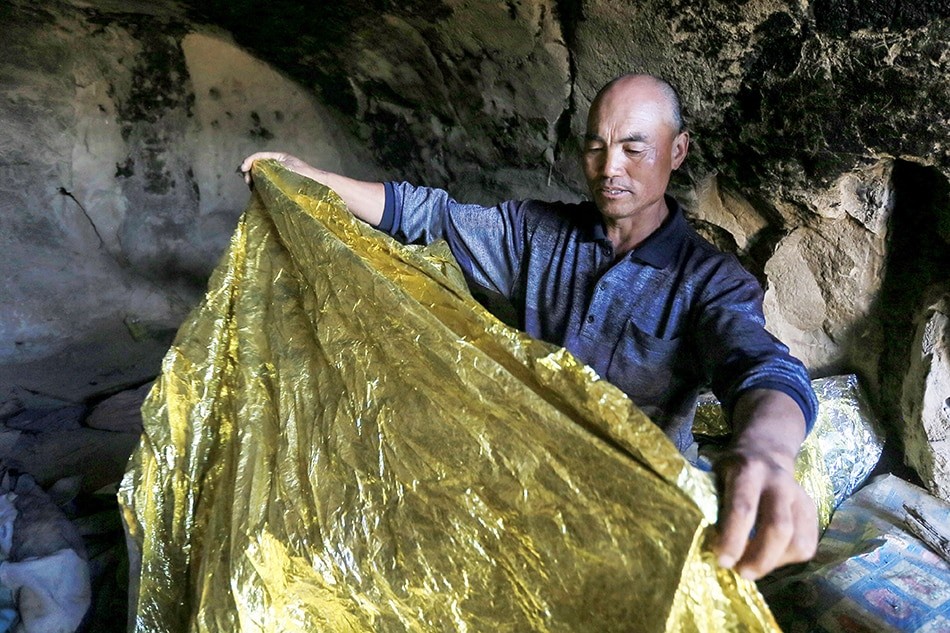
Zhu headed outside once more and, braving hail and freezing temperatures, reached a runner lying on the ground. He carried him towards the shelter and wrapped him in blankets, almost certainly saving his life.
"I want to say how grateful I am to the man who saved me," the runner, Zhang Xiaotao, wrote on Weibo.
"Without him, I would have been left out there."
Zhu has been feted in China for his selfless actions, but the shepherd told state media that he is "just an ordinary person who did a very ordinary thing".
Zhu rescued three men and three women, but regrets that he was unable to do more to help others who reportedly succumbed to hypothermia.
"There were still some people that could not be saved," he said.
"There were two men who were lifeless and I couldn't do anything for them.
"I'm sorry."
The tragedy has thrown a renewed spotlight on the booming marathon and running industry in China, with authorities ordering sports competitions to improve safety.
According to The Paper in Shanghai, five cross-country, marathon or other running races have been cancelled at short notice.
(05/29/2021) ⚡AMPThe Secret Psychology of Sneaker Colors
Aqua blue, acid lime and grape purple. Electric orange interspersed with neon pink. Gray suede and cheetah print mixed with white and gold. These are not descriptions of a minimalist’s worst nightmare, but rather new color combinations from Adidas, Reebok and New Balance. And they are jarring by design.
In the age of the infinite scroll and the era of sneaker culture, where the competition to make the hottest, rarest, most wanted kick is more intense than ever, the shoe that clashes shades with the most force stops traffic — at least of the online kind. As a result, athletic shoe companies are increasingly becoming fluent aficionados of that old art: color theory.
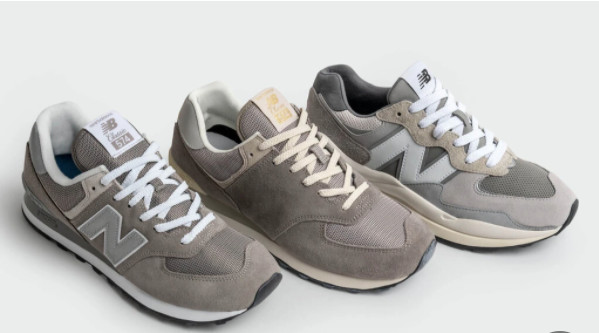
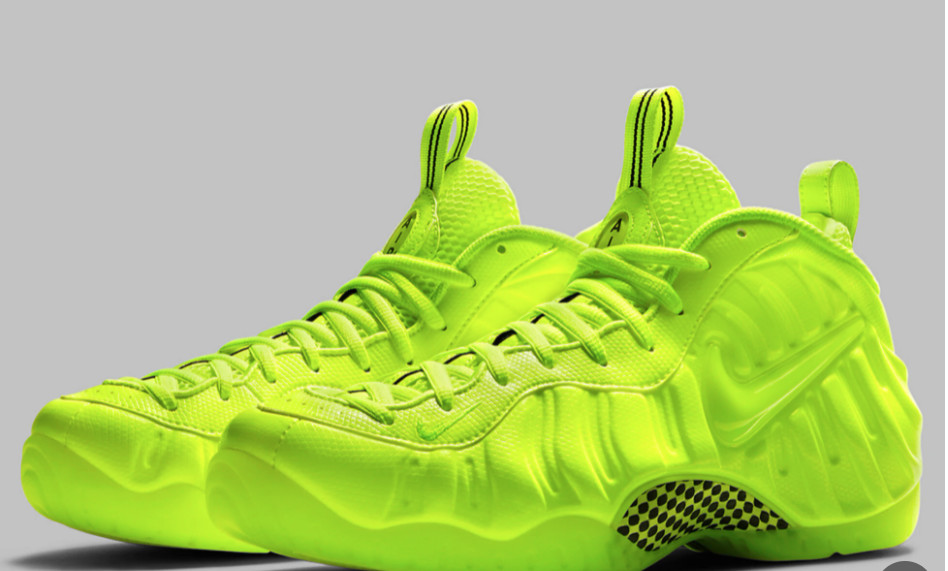
The links between color and emotion have been studied for centuries, from Carl Jung’s color coding of personality traits to focus groups evaluating the ways in which candy colors can affect perceptions of flavor. Drug companies color their pills “cool” or “hot” according to desired effect (hypnotics are often blue or green, antidepressants yellow), and we use SAD lamps in winter to replicate the energizing qualities of a sunny day.
Little wonder that sneaker brands have departments dedicated to manipulating minuscule shifts in shades, as well as engineering the visual equivalent of a crime scene so you rubberneck online. It’s their mission to create feelings and accelerate business.
“Between 70 percent to 90 percent of subconscious judgment on a product is made in a few seconds on color alone,” said Jenny Ross, the head of concept design and strategy for lifestyle footwear at New Balance. “It can excite or calm us, it can raise our blood pressure. It’s really powerful.”
So while the bread and butter of most brands remain the basics — the Nike Air Force 1 was the best-selling sneaker of 2020, and its default is all white — the pieces that power the continued churn and buzz are the limited-edition collectibles that tap into our subconscious to create desire.
Sometimes the triggers are obvious: The use of Varsity Red, for example, summons up Ferris Bueller collegiate nostalgia; gold and purple call to mind a Lakers game; and white is associated with racket sports. But in fashion, color is also your brand. Fendi is yellow, Hermès is orange and Tiffany is blue. Thus sneaker brands toggle between their core colors and wild experimentation.
New Balance, for example, is rooted in gray, omnipresent every season, suggestive of the urban running shoe, riffing on concrete. “Doing gray right is something we take a lot of pride in,” Ms. Ross said. “Every gray on our color ring has a character and personality: Castle Rock is warm; Steel is a blue tone. With legacy models, we make sure our tanneries never stray. They replicate with precision.”
At the other end of the dial is Nike, with its neon lime Volt color, first seen at the 2012 Olympics. To some it is heinous, to others a masterstroke. “That was an intellectual and scientific choice for Nike,” said Bryan Cioffi, Reebok’s vice president for footwear design. “The first color you read in your optical receptors is that super-bright lime. It’s possibly an evolutionary take from poisonous animals and signals danger. A physical thing happens when you see it. Nike triangulated that and repeated it forever.”
Repetition is how you win the color game. You may see Volt and recoil, but you’ll always think “Nike.” As colors go, it is a paradigm for brand marketing. “We did a complete technology innovation study about how color showed up on HDTV and sports tracks,” said Martha Moore, a Nike vice president and creative director. “We were studying the idea of speed and what color complemented that in the vibration of the human eye. Volt is emotional.”
After a year of living our lives almost wholly online, pixel coloration has become even more key. “We are developing colors that appear lit from within,” Ms. Moore said. “Pixels sitting next to one another create previously unseen colors. They create new neutrals and complex combinations. We are using complex knits of yarns, with bright spots and glows that haven’t been seen before.”
Indeed. “We are seeing a particularly positive response to dialed up pastels and strong yellow,” said Heiko Desens, the global creative director of Puma. “Things that speak of energy and positivity.”
That new energy is everywhere. For example, the Yeezy Boost 700 Sun shoe, introduced in January, is a blaze of yellow and orange that is a world away from the beige associated with Yeezy of yore. Hardcore Rick Owens fans may own numerous black pairs of his Dunks, but the new season’s Geo Baskets in bubble gum pink throw a curve ball and flip the dark Owens aesthetic.
(05/29/2021) ⚡AMPTokyo Olympics CEO insists ‘things are properly being managed’ as calls for cancellation grow
Tokyo 2020 chief executive Toshiro Muto attempted to reassure those concerned about the Olympic Games going ahead this summer as he insisted “things are properly being managed”.
Japan’s capital is still under a state of emergency with rising coronavirus infection rates in the country, while there is strong opposition among the public to the Games – scheduled to start on July 23 – going ahead.

Asahi Shimbun, a major Japanese newspaper and an official partner of the Games, has called for its cancellation, but Muto insisted the issue has not been expressed directly among the Tokyo committee executive board members.
“There has been some feedback pertaining to a potential cancellation or postponement but nobody has explicitly mentioned a view that we should cancel or postpone the Games,” he said.

“Rather the board members mentioned that Tokyo 2020 has made an effort to come this far. Things are properly being managed.
“We as board members understand that we need to communicate that to Japanese people in the general public. We need to be more mindful in how we can communicate what you are doing to (those) outside Tokyo 2020.”
Muto added it was understandable for news organisations to have different views on whether the Olympics proceeds when asked about the Asahi Shimbun editorial.
“Different press organisations have different perspectives on matters and that’s very natural given their role in the society,” he added.
“In order for us to hold Olympic and Paralympic Games, we in Tokyo 2020 and the people of Japan are maximising the effort to contain the pandemic of Covid-19. If we fail to do that then people will feel anxious, be worried.
“National governments and local governments are ensuring they have all initiatives in place to contain the pandemic.
“We believe these initiatives will bear fruit and be effective, so that the situation around infection will improve towards the Olympic and Paralympic Games, that’s our thought.”
(05/29/2021) ⚡AMPThe relashionship between sugary drinks and bowel cancer
Maybe you’re not a fan of plain water—we get it!—so you’ve created a mix of beverages to drink both on runs and in everyday life. That could be soda, energy drinks, and fruit juices, in addition to sports drinks. While that might solve your taste issue, a recent study in the journal Gut suggests you may want to rethink your drink.
Researchers looked at data provided by just over 95,000 participants in the Nurses’ Health Study II, an ongoing study of women that began in 1989 and tracks daily habits and health outcomes.

They found that over a 24-year period, those with a higher intake of sugar-sweetened drinks were at higher risk of developing bowel cancer before age 50. Women who drank two or more per day were about twice as likely to be diagnosed with this type of cancer, and each daily serving was associated with a 16 per cent higher risk.
The reason for this is likely due to the way sugar-sweetened drinks can cause a rapid rise in blood glucose and insulin secretion, causing inflammation and obesity, which are both associated with a higher risk of bowel cancer development.
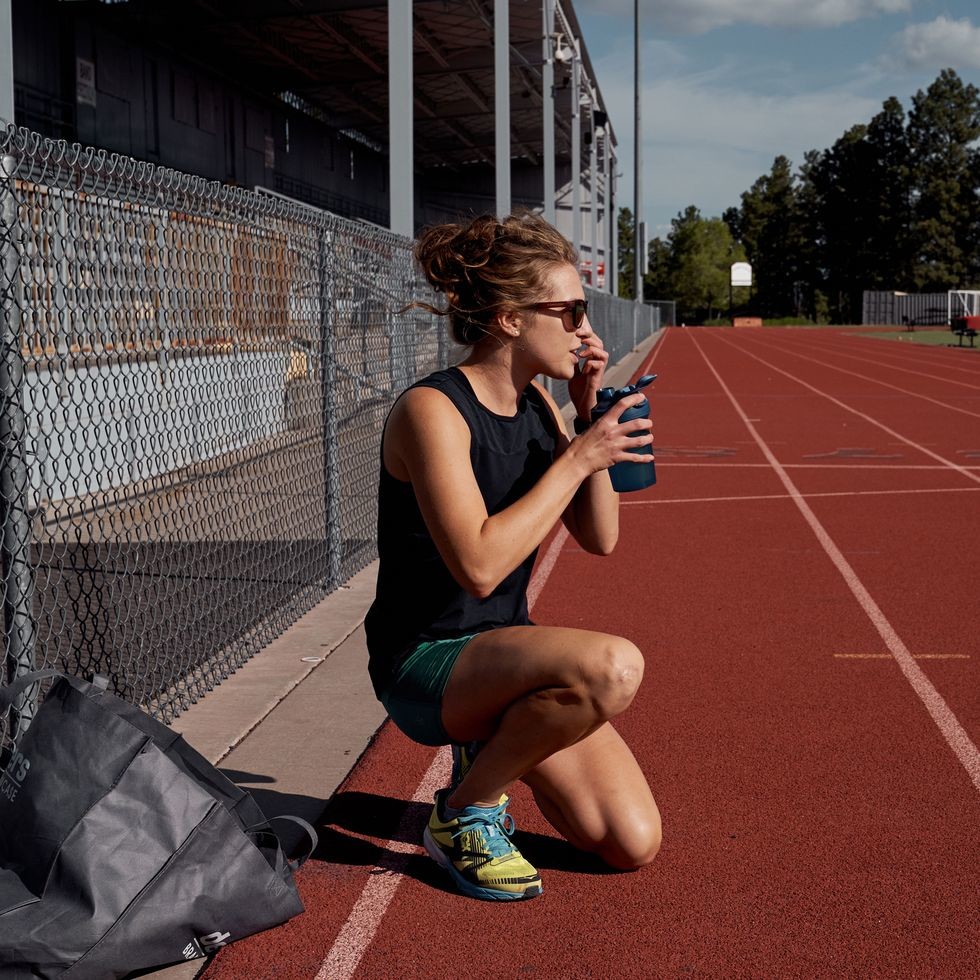
Although artificial sweeteners have their downsides in other research—like this review, which found negative side effects in some animal and human studies—the researchers in the current study discovered that substituting sugar-sweetened drinks with artificially sweetened ones were beneficial. In those cases, there was a 17 to 36 per cent lower risk of a bowel cancer diagnosis before age 50.
What does this mean in terms of daily consumption? First, that when you aren’t exercising, water tends to be a better option, according to dietitian Kelsey Pezzuti, R.D., who specialises in sports nutrition. She told Bicycling that laying off the sports drinks as a regular beverage can help you control the amount of sugar you’re consuming overall.
When you are on a run or doing other exercise, a sports drink can be beneficial if your activity is at moderate-to-high intensity and lasts for more than an hour. That’s because their combination of fluid, electrolytes, and carbs has been shown to help many people power through intense workouts with sustained energy compared to plain water.
If that run is just an easy 30 minutes, though? Not so much.
'These drinks are ideal for athletes training several hours per day, such as marathon runners or triathletes,' said Pezzuti. 'If your workout lasts less than an hour, chances are slim that you actually need a sports drink.'
(05/28/2021) ⚡AMPby Elizabeth Millard
Ethiopia’s Gudaf Tsegay has had an amazing 2021 season so far
2021 is the year of Gudaf Tsegay. The world championship 1,500m bronze medalist has raced six times this year, competing in a different event on each occasion. She ran the world-leading time in all six of those races, and she still holds the world lead in four of them. Tsegay has won every race she has entered this year, and on top of her world leads, she has run four PBs, a national record and a world record.
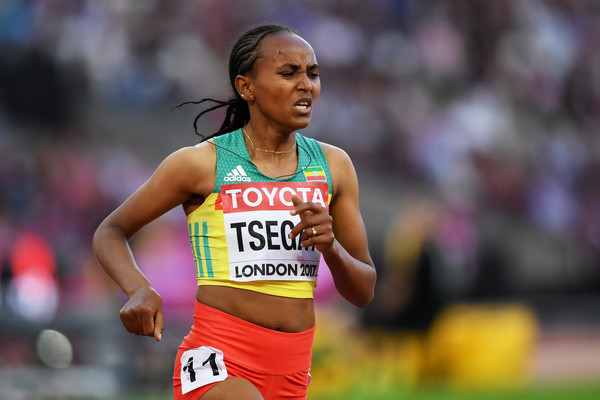
Tsegay opened her season with a 1,500m race in Addis Ababa, Ethiopia, where she ran 4:02.4. She won the race handily, beating the second-place finisher by nine seconds. At the time, this was the world lead in the outdoor 1,500m, but it came in January, early on in the season when most of the world was still competing indoors. Even so, since then, Tsegay’s time has only been beaten by five women, and she currently sits in sixth in the 2021 rankings.
Next, Tsegay travelled to France, where she raced an indoor 1,500m. She ran an incredible time of 3:53.09, crushing the rest of the field (Great Britain’s Laura Muir finished in second in 3:59.58) and beating the world record by two seconds. That gave Tsegay her second world-leading result in a row, but she wasn’t finished yet. Less than a week later at another French meet, she ran her third world lead of the year and a national record in the indoor 800m, which she won in 1:57.52.
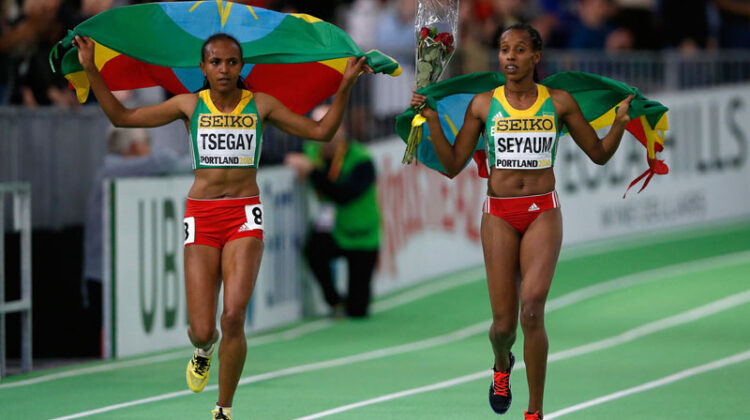
Closing out her indoor season 10 days later in Spain, Tsegay ran another world lead and PB, this time in the 3,000m. Yet again, she not only ran the fastest time of the year, but she destroyed the field, beating second-place finisher and fellow Ethiopian Lemlem Hailu by a whopping seven seconds. All three of these results that Tsegay ran indoors remain the world-leading times on the year.
Moving back outdoors, Tsegay jumped up in distance to the 5,000m, which she raced at the Ethiopian Championships in Addis Ababa in April. She won the race in 14:49.7, beating 5,000m world record holder Letesenbet Gidey by seven seconds. Tsegay’s time was the world lead for a month before Sifan Hassan of the Netherlands ran 14:35.34 in May.
Finally, Tsegay’s most recent run came in the 10,000m at a race in Portugal. Despite the fact that the race was her debut in the 10,000m, Tsegay cruised to the win and the world lead, stopping the clock in 29:39.42 (the fastest 10,000m debut in history). Second place went to Bahrain‘s Kalkidan Gezahegne in 29:50.77, which is the second-fastest result in 2021 so far.
That’s six races, six wins and six world leads across a wide variety of distances. Tsegay has proven that she is as capable of winning an 800m race as she is at winning a 10,000m, and she is only 24 years old. This has certainly been the year of Gudaf Tsegay so far, but with such clear talent and years of racing ahead of her, she could be the woman to beat for the better part of the next decade, so running fans better get used to hearing her name.
(05/28/2021) ⚡AMPby Ben Snider-McGrath
Predicting running injuries
A recent journal article on running injuries starts with this gem as its first sentence: “Runners are subject to a high incidence of lower extremity injury of between approximately 20% to 80%.” This pseudo-stat, which originated in a 2007 systematic review by Dutch researchers, is a kind of running joke among researchers in the field—an opening line that admits that we basically don’t know anything about who gets injured and why.
It’s particularly appropriate in this case, because the new study ends up highlighting the depths of our ignorance. Researchers at Dublin City University, led by physiotherapist Sarah Dillon, explored whether it’s possible to predict which runners are most likely to get injured based on tests of simple characteristics like strength, flexibility, foot position, and asymmetry. The results, which appear in Medicine and Science in Sports and Exercise, don’t say much for our ability to predict the future, but have some important implications for how we think about injury risk.
The study involved 223 recreational runners, divided into three groups. One group consisted of 116 people who had suffered a running-related lower-body injury between three and 12 months prior. The second group was 61 people who had been injured more than two years prior but were subsequently healthy. And the third was 46 unicorns who had never suffered a running injury, defined as pain that caused them to restrict or stop training for at least seven days or three consecutive sessions, or consult a physician or other health care professional.
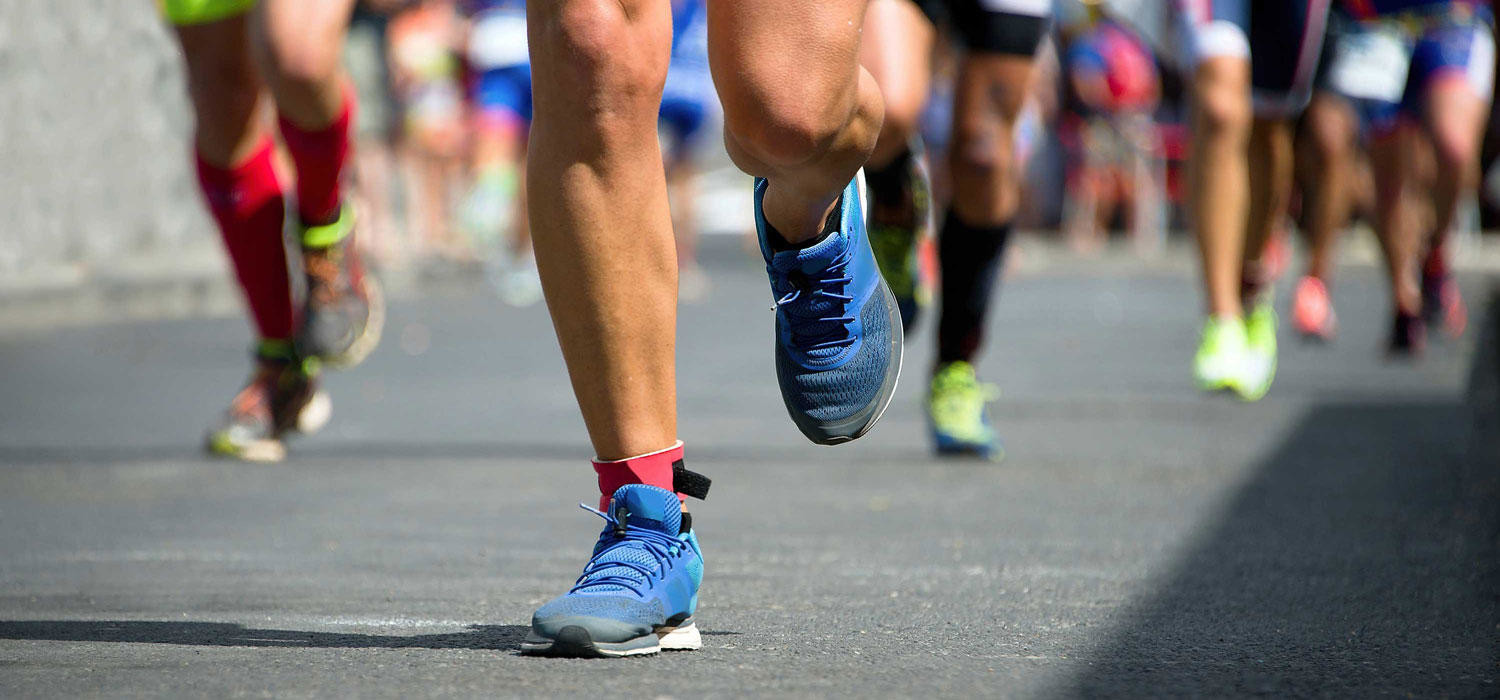
Runners who had been injured less than three months ago were excluded, to ensure that everyone was healthy. So were those injured between one and two years ago, to ensure a clear distinction between recently injured runners and those who seemed to have reacquired injury resistance. That’s important, because numerous studies (including the 2007 review) have concluded that one of the best predictors of future injury is previous injury. If you’ve been hurt and then stayed healthy for two or more years, you’re beating the odds.
All these runners came into the lab for a series of tests. Strength was assessed for various hip, knee, and ankle movements. Hip and ankle flexibility was measured, as were foot posture index and navicular drop, which both assess how much your foot pronates (rolls inward) or supinates (rolls outward). For each of these measures, an asymmetry index was calculated based on the differences between right and left side.
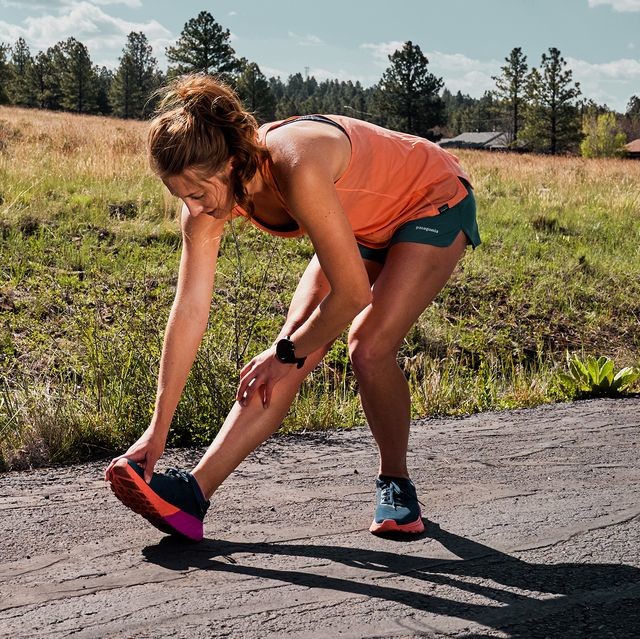
The results are pretty easy to sum up. The recently injured, injury-free for two years, and never-injured runners had, on average, essentially the same characteristics. In fact, the minor differences that did emerge were the opposite of what you’d expect: the never-injured runners had weaker calves than both injured groups, and weaker hip abductors than the recently injured runners. That’s bad news for the hope of injury-proofing yourself by doing a few simple tests, identifying key weaknesses, and fixing them with targeted exercises.
The two possible explanations floated by the researchers is that recently injured runners had equal or greater strength because they’d been diligently doing rehab exercises. Indeed, 87 percent of the recently injured runners reported doing a rehab protocol—though in my anecdotal experience that generally involves being given a sheet of paper with some exercises on it, half-assing them for a few weeks, and then getting bored and forgetting about it. Another possibility is that injured runners developed compensatory movement patterns that strengthened uninjured muscles while covering for the injured ones.
More likely, in my view, is that a broad approach that lumps all running injuries together is doomed to failure. Maybe people who develop runner’s knee have, say, slightly weaker hips, and people who develop shin splints have slightly weaker ankle dorsiflexors, and people who develop plantar fasciitis have slightly tighter calves, and so on. Throw them all together in one group, and none of those warning signs will be statistically significant overall.
If you’re searching for root causes and pondering the eternal philosophical question of why bad injuries happen to good people, then these caveats matter. Despite the new study’s non-result, it’s still possible that there is an anatomical reason for your injury, rather than just a bad roll of the dice. The current tests just aren’t sensitive enough to pick it up. But in practice, if you’re actually trying to predict and prevent injuries, that’s a problem.
If all this seems a bit depressing, it’s worth remembering that running injuries, unlike hamstrings strains, don’t generally happen instantly. They build up slowly, a consequence of too much, too soon, for too long. Transient aches and pains are probably a much better indicator than any screening test of what weaknesses and imbalances you need to address. And if you do get injured, don’t be too hard on yourself: despite what your therapist may tell you with the benefit of hindsight, nobody really saw it coming.
(05/28/2021) ⚡AMPby Alex Hutchinson
Raiya Matonovich is the fastest 13-year-old in North America at the 800m
Two weeks ago, 13-year-old Raiya Matonovich of Kamloops, B.C. ran 2:10.78 in the 800m, a mere 0.8 seconds off the U16 record that has stood for 26 years. That record was set in 1995 by none other than the current Canadian record-holder in the marathon, Malindi Elmore, which bodes well for the future success of this young track star.
According to Kamloops news outlet, CFJC Today, Matonovich has been running since she was five years old, when her mom would take her to Kenna Cartwright Park for runs. Ever since then, the young athlete says she’s been really enjoying it. Now a grade eight student at SaHali Secondary School, her coach, Sean Lehmann, believes Matonovich’s success is only beginning.
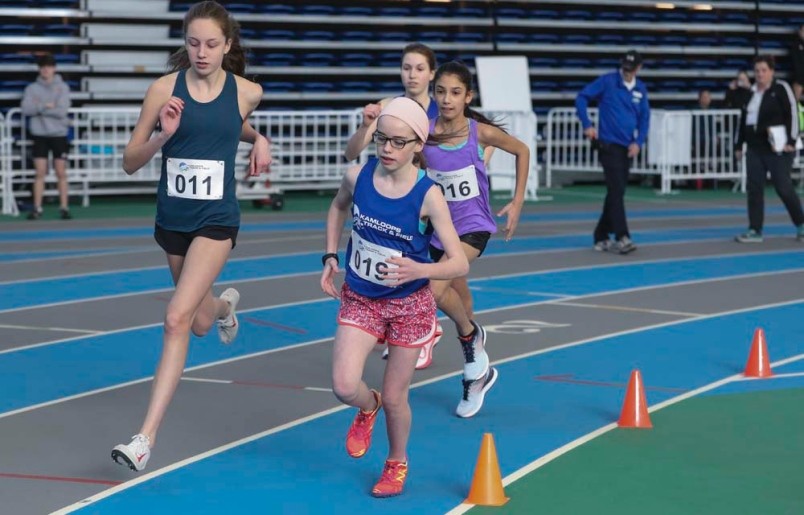
“Raiya’s just started running as a U16, so she’s still 13 years old, and she’s got plenty of time to break these records,” he said. Matonovich is also excited about her success, and she’s anxious to keep going to see what she can achieve.
“For sure, next time I’m aiming to get under 2:10 for 800,” she adds.
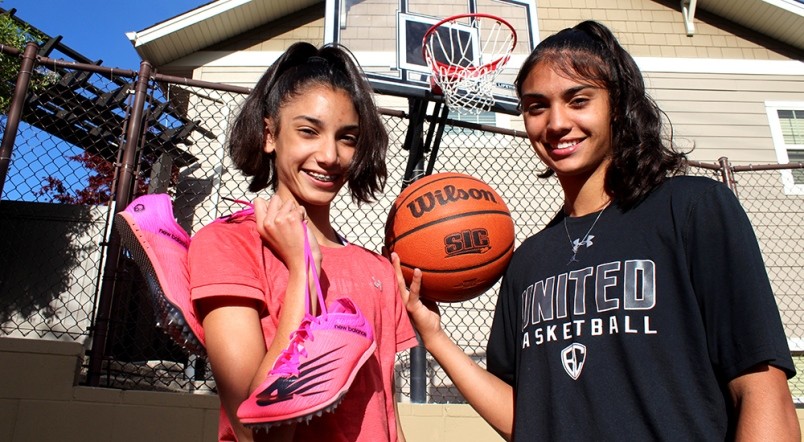
Lehmann says Matonovich’s time makes her the current fastest 13-year-old 800m runner in North America and the second-fastest in the world (the fastest time of 2:08.45 belongs to Ivy Boothroyd of Sydney, Australia). She is also the third-fastest in the world at the 1,500m.
The young runner looks up to Elmore, whose time she nearly beat, and hopes to one day run at Stanford, where Elmore set the school’s record in the 800m and the 1,500m and was a five-time All-American.
“For quite a few years now, I know this is something that I want to do when I grow older, just to run professionally,” she said. “So I feel like it’s really exciting for me. I want to see how far I go.”
Lehmann believes she’s got the chops to accomplish this, considering she’s running University-level times already. If Matonovich continues with this trajectory, in a few year’s time we may be seeing her not only competing at Stanford, but accomplishing her other dream — to compete at the Olympics, and, as she says, “hopefully to break some world records, for sure.”
(05/28/2021) ⚡AMPby Brittany Hambleton
2021 Richard S. Caliguiri City of Pittsburgh Great Race Returns to a Live Start Line and Opens Registration
The 44th annual Richard S. Caliguiri City of Pittsburgh Great Race presented by Highmark Blue Cross Blue Shield and 26th annual Dollar Bank Junior Great Race open registration inviting participants to the live event. The One Great Weekend is scheduled for Sept. 25-26, 2021.
“Last year's virtual event participation showed us just how much people love this event,” said Brian Katze, Race Director. “We can't wait to welcome everyone back to the start line for this year’s One GREAT Weekend.”
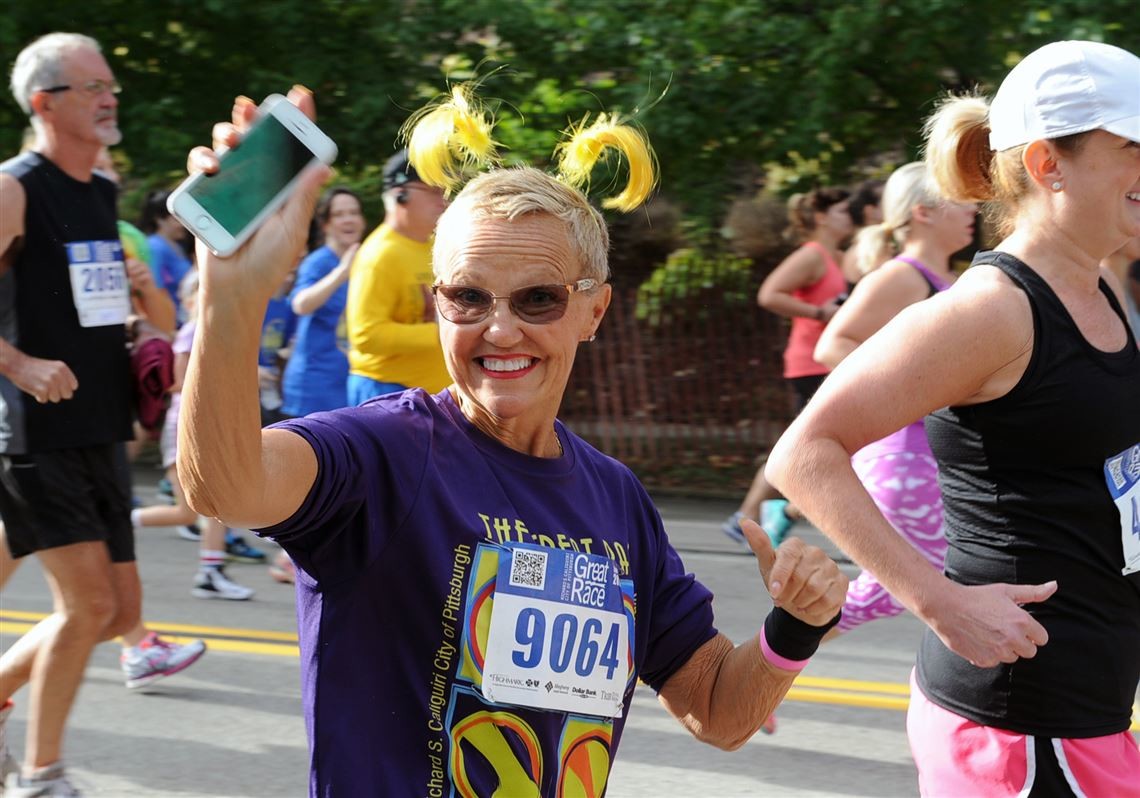
With a 10K, 5K, One Mile Family Fun Run, Tot Trot and Diaper Dash race options, there is an event for everyone in the whole family. Registration for the 5K and 10K opens at $30 while the Junior Great Race events are $10. All participants will receive a race shirt and medal for their accomplishments.
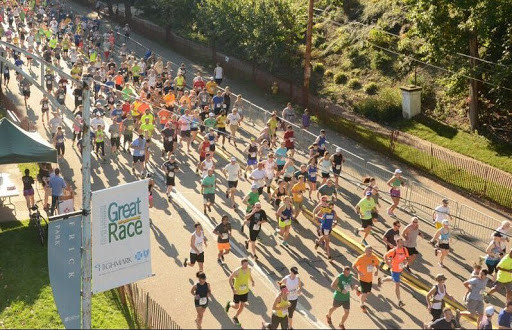
Each year, the Great Race donates $1 from every Great Race and Junior Great Race registration to the Richard S. Caliguiri Amyloidosis Fund, a fund held by the Pittsburgh Foundation that is dedicated to supporting medical research.
For the fifth year in a row, the City of Pittsburgh will partner with P3R, the engine behind Pittsburgh’s greatest races including the DICK’S Sporting Goods Pittsburgh Marathon, to produce the 2021 weekend of events. The Richard S. Caliguiri City of Pittsburgh Great Race is the largest 10K in Pennsylvania and continues to grow.
About the Richard S. Caliguiri City of Pittsburgh Great Race
Each year on the last Sunday of September, the starting gun sounds for a world-class road race that has become a true Pittsburgh tradition for the past 40 years. The Great Race – established as a 10K race by the late Mayor Richard S. Caliguiri – has attracted nearly a half million participants since 1977. Over the years, this popular fall fitness classic has grown to include a 5K run/walk, running clinic, two-day expo and children’s race. For more information about the Richard S. Caliguiri City of Pittsburgh Great Race, visit www.RunGreatRace.com
(05/27/2021) ⚡AMPCity of Pittsburgh Great Race
In 1977 Mayor Richard S. Caliguiri established The Great Race as a community “fun run.” Eleven years later, Mayor Caliguiri died of amyloidosis, a rare protein disorder in which one or more organ systems in the body accumulate deposits of abnormal proteins known as amyloid. Each year The Great Race donates $1 from every Great Race and Junior Great Race...
more...Japanese Men Break M90 4x400 m World Record by Almost Four Minutes
At Sunday's Aomori Masters Time Trials meet a Japanese men's team set a 4x400 m relay world record of 8:49.01 in the men's 90+ age category, taking nearly four minutes off the previous world record of 12:41.69 set in the United States in 2014.
Starting from a crouching start, leading runner Matashiro Suruga, 91, split roughly 2:07.5 before handing off to second runner Yuzo Kudo, 92. Kudo split 2:34.5, with third runner Kozo Mitsuya, 90, splitting 2:27.0 But anchor Hiro Tanaka, 90, delivered the biggest run of the day.
Out smooth and readily steadily, the stadium announcer predicted on the first curve that Tanaka would bring the team home under ten minutes. Hie was fast enough that less than 200 m later she revised that prediction to under nine minutes. Kicking in the last 100 m, Tanaka split an impressive 1:40 to bring the team home to the record. Without a doubt, it was the performance of the weekend worldwide.
(05/27/2021) ⚡AMP
by Bret Larner
BOLDER ON THE RUN in a Safe Return to In-Person Racing
One of the largest road races in the nation, and America’s All-time Best 10K is back. With guidance from governmental entities and health officials, the BOLDERBoulder team is set to create a unique experience in 2021 to deliver the fun that the annual race is known for, in a new event concept which has been specifically designed to re-acclimate race participants from virtual running back to in-person running races, Stack Sports announced today.
The BOLDERBoulder this year has created a unique variation for Memorial Day Weekend in this “walk before you run” run, called BOLDER on the RUN, and will stage in-person 10K races, on marked, measured and timed courses, at six different locations along the front-range.
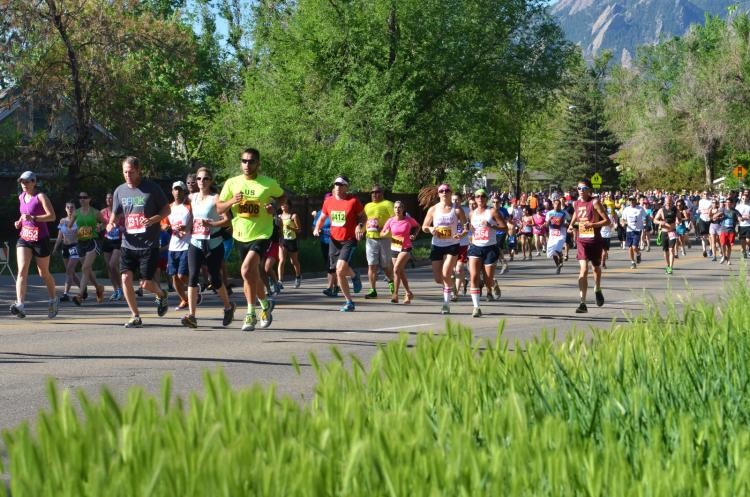
The event will span 14 hours each day, beginning Saturday May 29 at 6:30 a.m., through 8:30 p.m. Monday May 31, 2021.
In support of BOLDER ON THE RUN, the BB10K team is partnering with its longstanding timing, scoring and results partner, the End Result Company powered by Stack Sports, for the official timing, including the daily event execution to provide accurate timing and official results and scoring for each participant.“This is an incredible event and we are so excited to be a part of its return in 2021,” said John Adams, GM – Endurance at Stack Sports. “We are always looking for opportunities to innovate, and working with Cliff and his team on this idea was a real look at how technology can partner with event staff to deliver a great experience. BB10K is back, and an example for other races and the broader community of road running events that it’s safe.”The BOLDERBoulder mantra, “Oh Yes You Can!” since 1979, is the battle cry which has encouraged participants of all ages and abilities to participate, stay active, get healthy, get outside, celebrate Boulder, Colorado, and honor Memorial Day and those who have given their life in service to this country.
This year the event will take its Can Do Attitude on the road and to the next level with a one-of-a-kind experience at the six unique courses, in Broomfield, Erie, Firestone, at the Greenland Trail in Larkspur, Littleton, and Loveland.Each venue features a different course and each provides a unique experience and adventure, allowing every participant to take on the challenge of finishing a 10K by selecting their venue, their day and their preferred race time. Famous for its BOLDER attitude at its BOULDER altitude (5,391’) each course offered is situated above 5,000’ and provides for smaller race groups to run unimpeded during their specific time block over the weekend.“Because we are able to time each participant, similar to the big race, we will be able to recognize the top 15 fastest times for boys and girls and men and women every age,” said race director, Cliff Bosley.
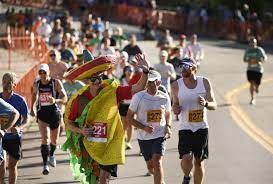
“Creating something new and different in a year where there is still an abundance of caution about CV-19, also puts us in a great spot where we can help participants to be comfortable as they assimilate back to in-person running as we begin preparations for the traditional race in 2022.”In its 42nd year with BB10K End Result has worked closely with the event anticipating its return. “End Result Company is excited to see this great event return in such a unique way and to provide the premier event with best-in-class technology,” said Kevin Jandt, VP, Endurance at Stack Sports. “Providing our timing services just provides additional data points to BB10K to ensure the event is both competitive and safe.”“We can’t wait to see you out there,” Cliff Bosley, Race Director.About BOLDERBoulderThe BolderBOULDER, named America’s All-Time Best 10K by Runner’s World, is the 4th largest running race in the United States and the 7th largest in the world. The race attracts over 50,000 runners, joggers, walkers and wheelchair racers, and draws professional athletes from around the world to compete for one of the largest non-marathon prize purses in road racing.
The annual in-person race starts at 30th and Walnut and winds through Boulder neighborhoods with live music and entertainment at every corner. The race finishes at the University of Colorado’s Folsom Field and attracts over 100,000 spectators throughout the course.
(05/27/2021) ⚡AMPBOLDER BOULDER
In 1979 we dreamt of attracting a few hundred of our friends to race though the streets of Boulder, Colorado to celebrate Memorial Day with our families. Fast forward almost 40 years and the Bolder BOULDER has grown to become one of the largest and most highly acclaimed 10K’s in the world. Almost 1.2 million runners, joggers, walkers and spectators...
more...Francine Niyonsaba runs 5,000m debut, finishes just off Olympic standard in 15:12.08
World and Olympic 800m silver medallist Francine Niyonsaba of Burundi raced a 5,000m in Spain on May 22, and she finished with a national record of 15:12.08.
Niyonsaba’s result was just off the Olympic standard of 15:10.00, and it was her first official race over 5,000m. Like South Africa’s Caster Semenya, Niyonsaba is an athlete with DSD (differences of sexual development), and a 2019 World Athletics ruling prevents her from competing in any events from 400m up to the mile.
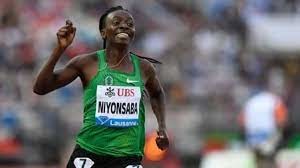
Niyonsaba, Semenya and other DSD athletes (who have higher-than-usual rates of testosterone) had to make a tough decision when WA barred them from competing in certain events. They could take hormone-suppressing drugs to lower their testosterone levels, drop down in distance to compete in sprinting events like the 100m and 200m or jump up to races longer than a mile. Refusing to take any hormone suppressants, Semenya has spent the past couple of seasons testing out both ends of the racing spectrum, running races as short as 200m and as long as 5,000m.
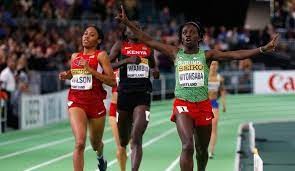
Semenya has made progress in both arenas, but her PBs of 23.49 seconds in the 200m and 15:52.28 in the 5,000m are well off the Olympic standards of 22.80 and 15:10.00. Niyonsaba, however, has set her sights solely on the 5,000m, and her undivided focus on the longer race seems to have paid off, as she is now just a couple of seconds away from qualifying for the Tokyo Games.
Niyonsaba announced her plans to compete in the 5,000m in February, and she now has a little over a month to lower her PB by a couple of seconds in order to qualify for the Summer Games. (The Olympic qualifying window closes on June 29.) After the race, Niyonsaba took to social media to express her excitement in the run, writing, “So happy to be back in international competition with a great debut of 15:12 in the 5K..it was a big challenge but I faced it with great determination and perseverance.”
(05/27/2021) ⚡AMPby Ben Snider-McGrath


